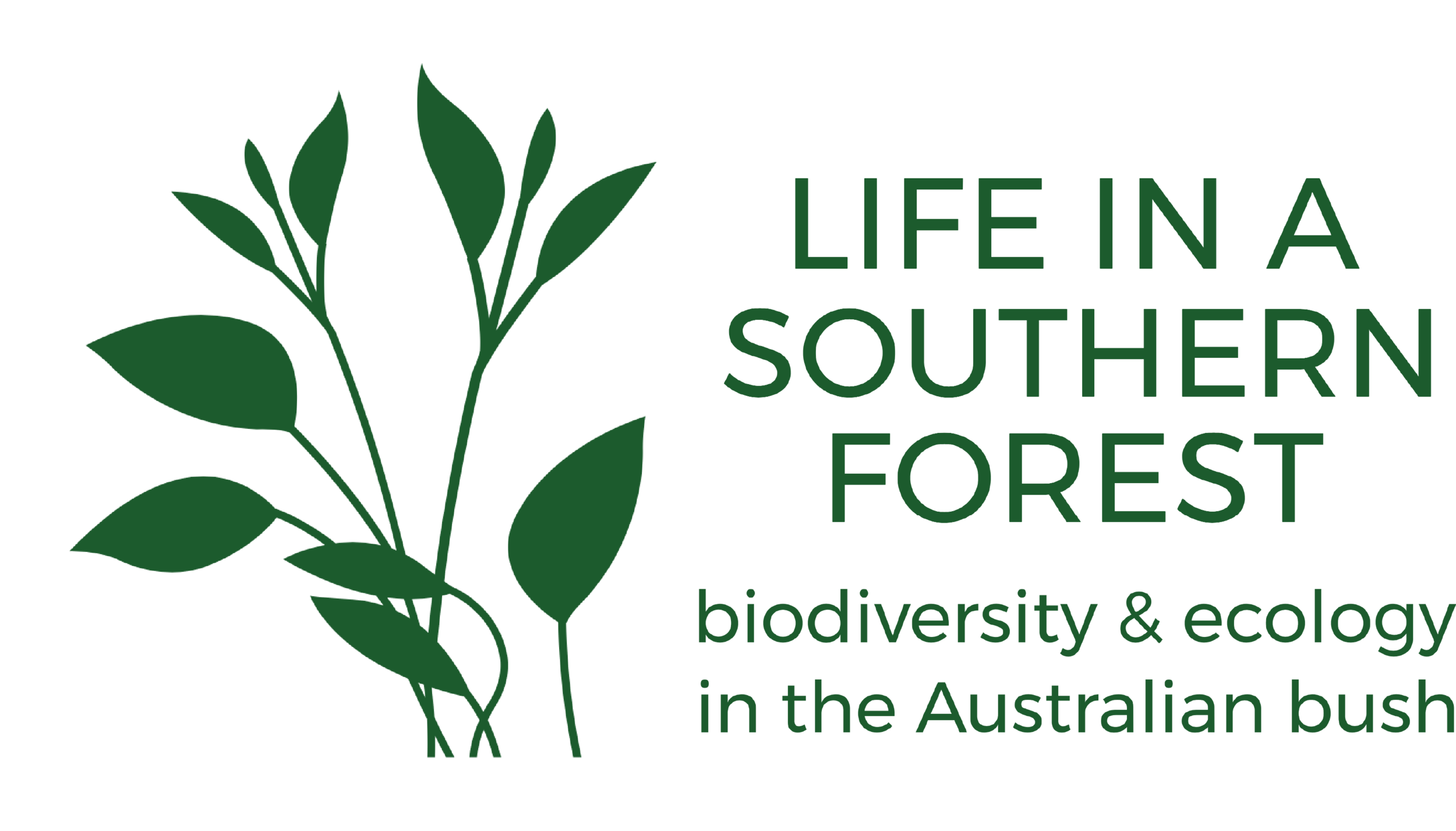
Bearded Tylophora
Vincetoxicum barbatum
A twining vine, with an attractive, but short-lived flower. It’s restricted to the southern half of coastal NSW, just extending into Victoria.

Hairpin Banksia
Banksia spinulosa
This banksia, which has benefited from the fire, is just coming into bloom. Each of the protruding, yellow structures on the spike is an individual flower. These will open over the next few weeks to reveal the ‘hairpins’ of this species. See our Proteaceae blog for more details.
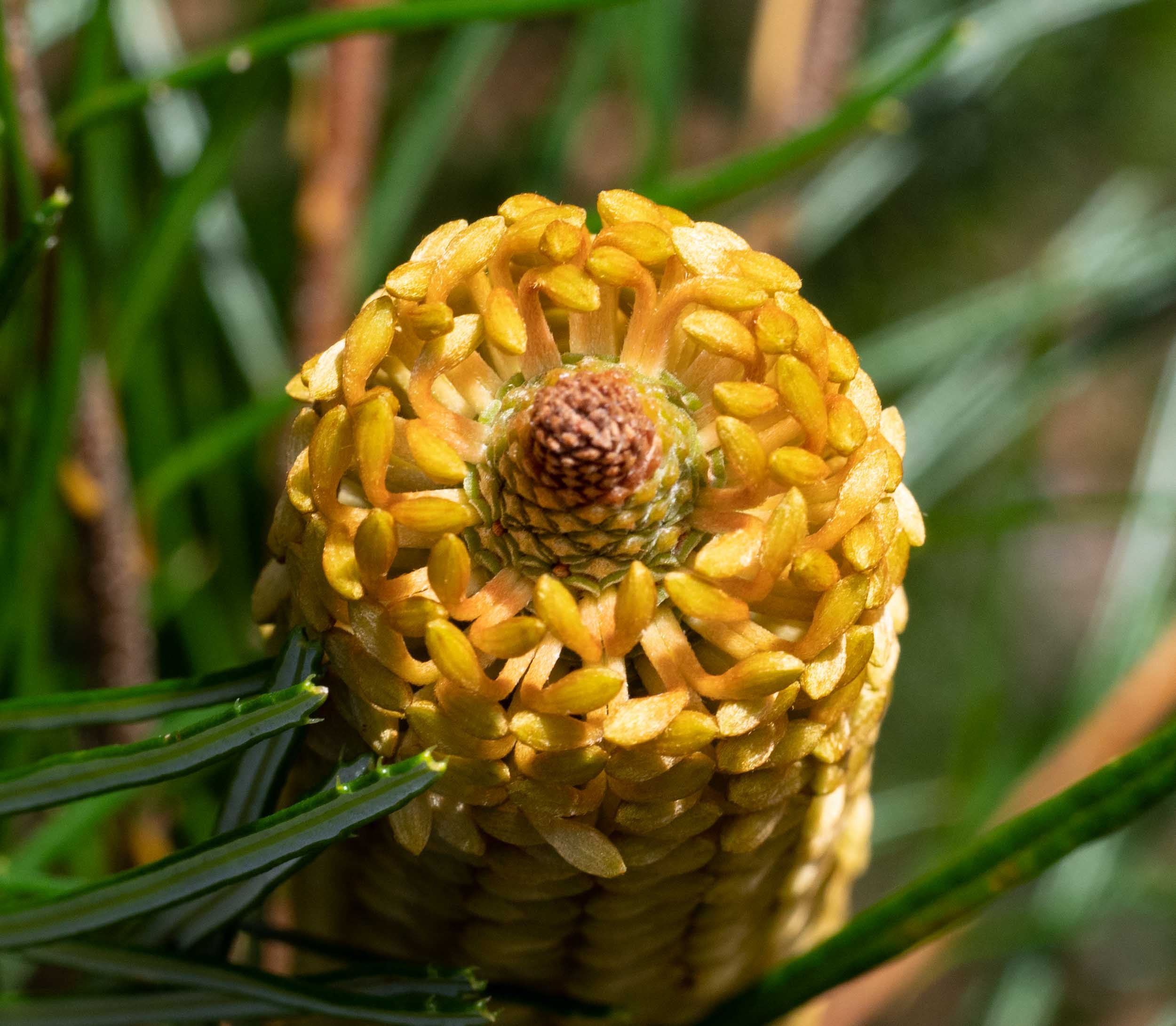
Hairpin Banksia
Banksia spinulosa
This adjacent spike is a little further advanced in its flowering. The style has started to form.

Geebung
Persoonia
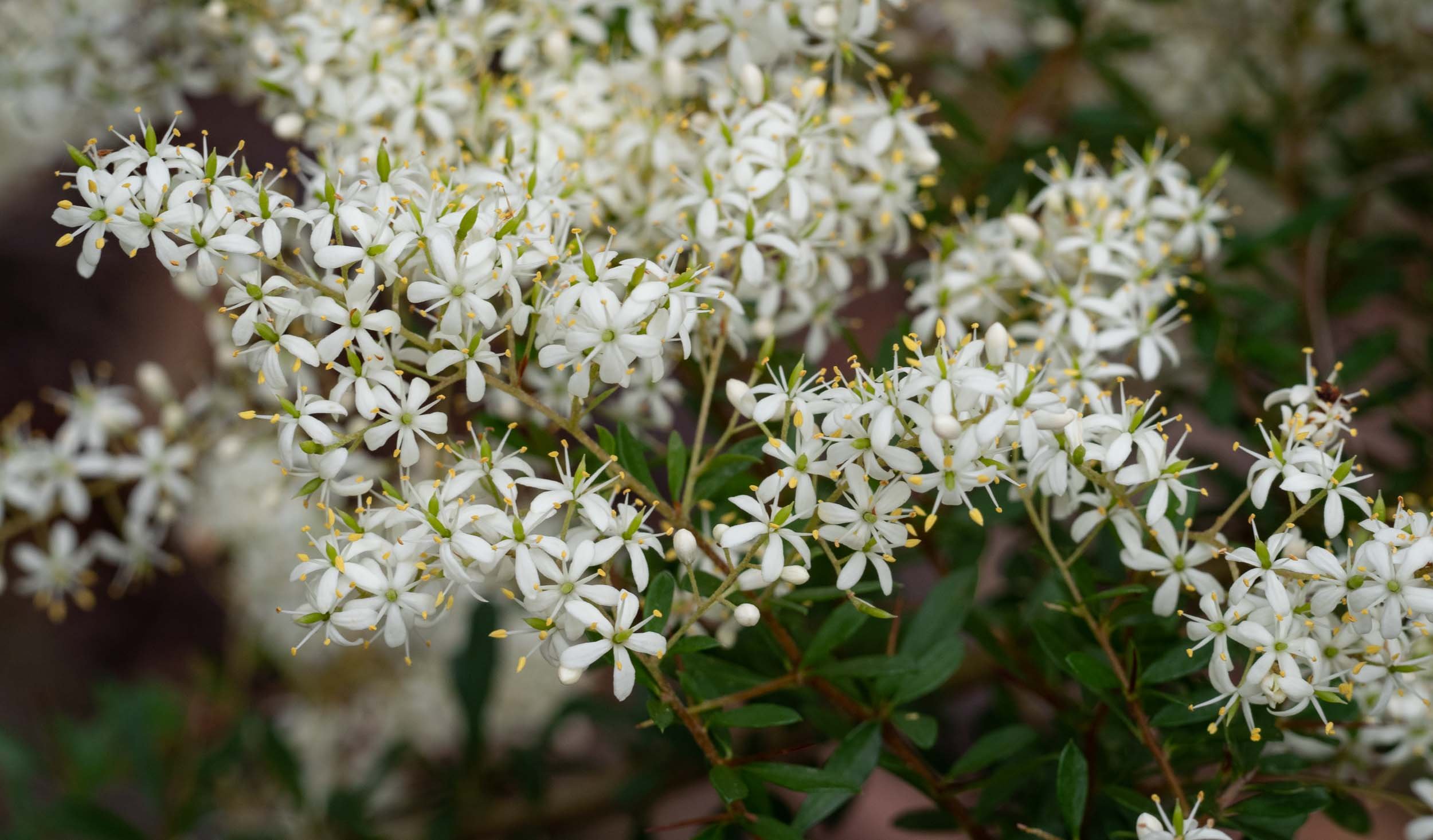
Hairy Bursaria
Bursaria spinosa ssp. lasiophylla
This is the first time since the fire that we’ve seen this plant bloom in our forest. Its flowers are visited by a number of beetles, flies and butterflies, including Bright Copper. Caterpillars of the latter butterfly feed on the leaves and form a symbiotic relationship with ants. The caterpillars are guarded by the ants as they feed, while the pupae live in chambers in the soil constructed by the ants.
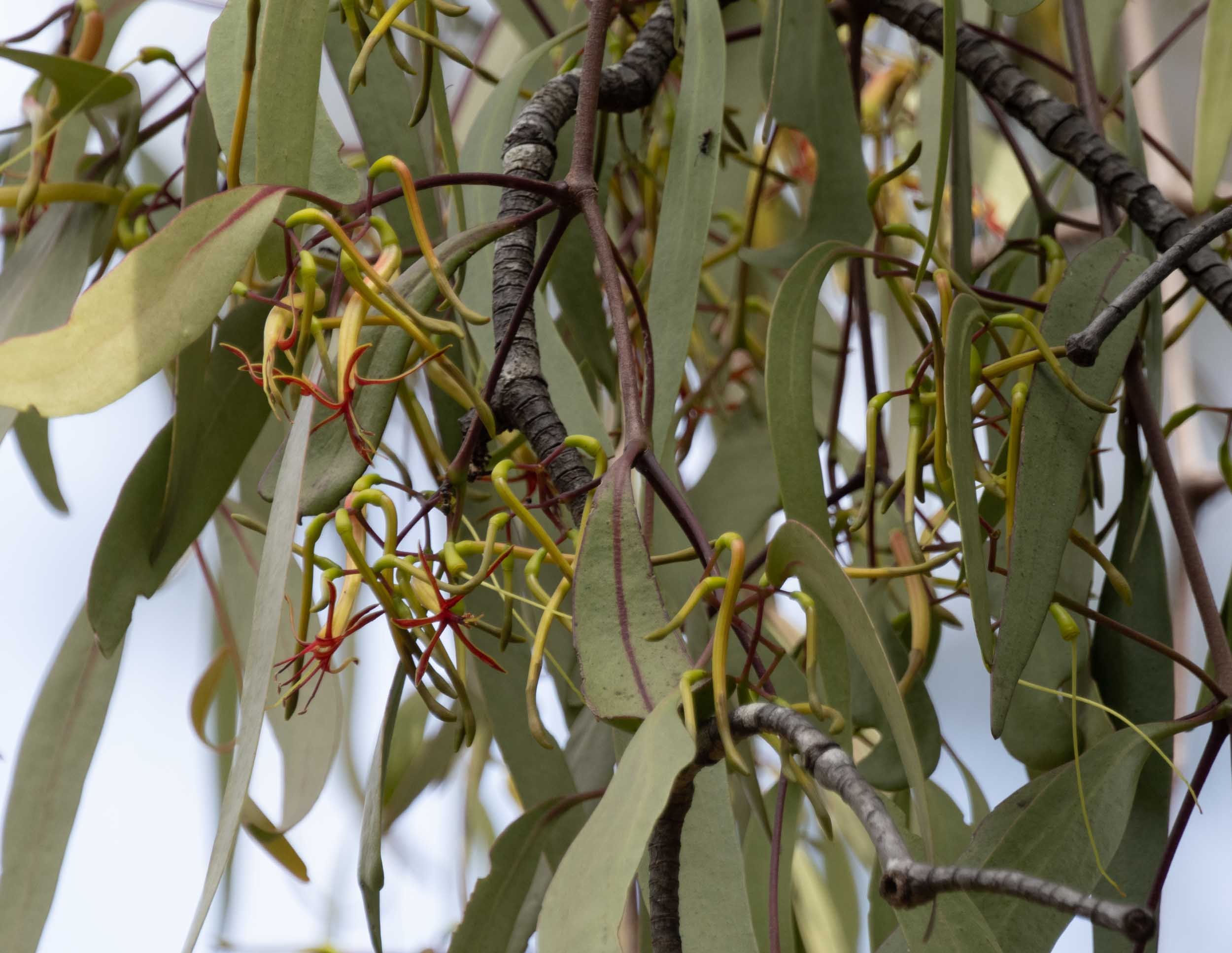
Creeping Mistletoe
Muellerina eucalyptoides
This was one of the last plants to reappear after the fire and was a welcome sight as it often fails to survive intense fire. This one is growing on an Angophora floribunda tree and is now flowering profusely. Its foliage is a food plant for a number of butterflies and moths - including the Imperial Jezabel. And its seed is of course eaten by the Mistletoe Bird. We hope to see it soon!
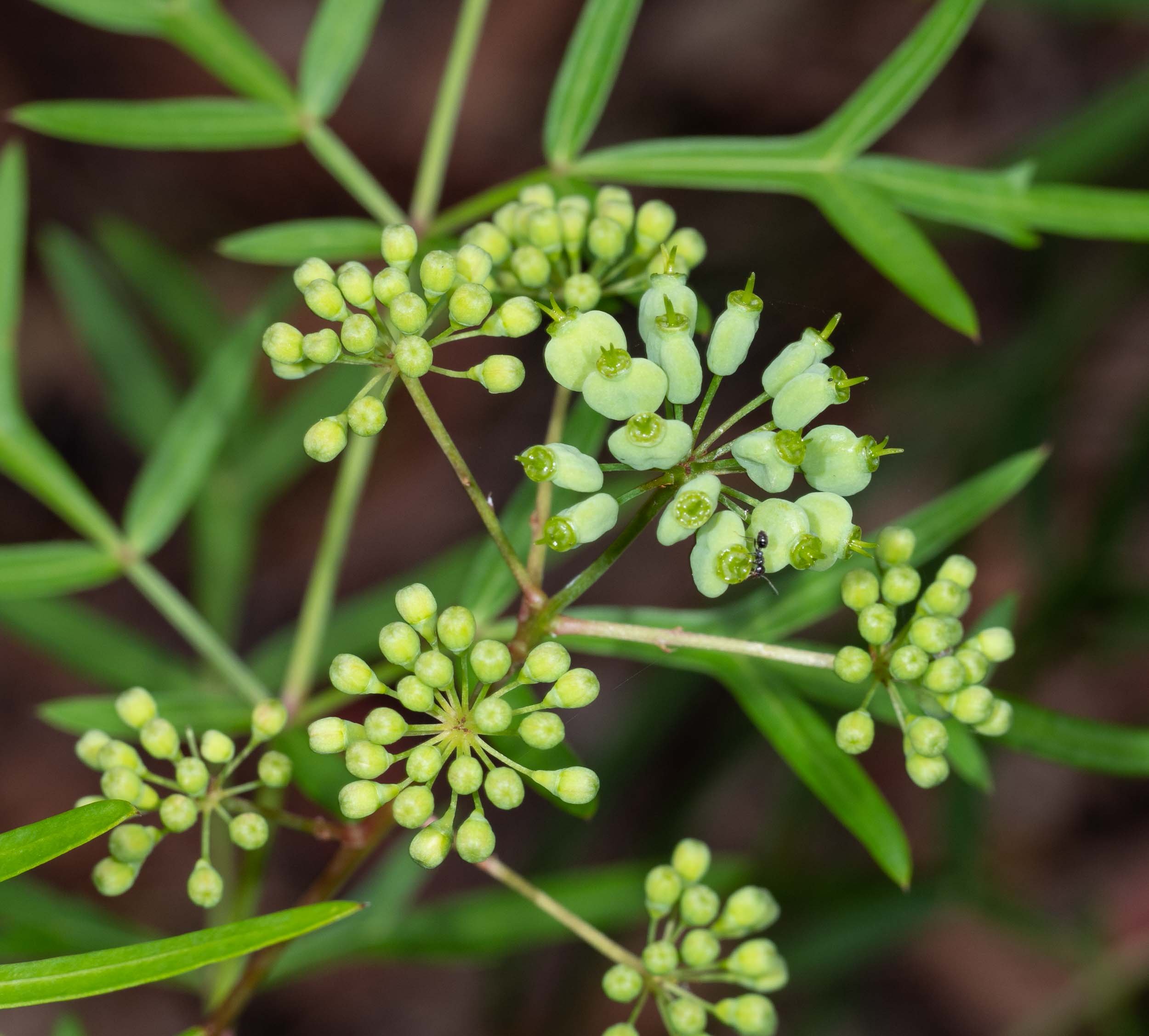
Elderberry Panax
Polyscias sambucifolia
We have just a few plants of this low shrub in the forest, but it has become more widespread since the fire. It has an unusual leaf form and flower and the small fruit is quite attractive, as well as being edible.

Slender Hyacinth-Orchid
Dipodium variegatum
We first sighted this orchid just before the fire and this summer it has made a reappearance. It forms a microrrhyzal association with the fungus Russula, which it shares with eucalypts.
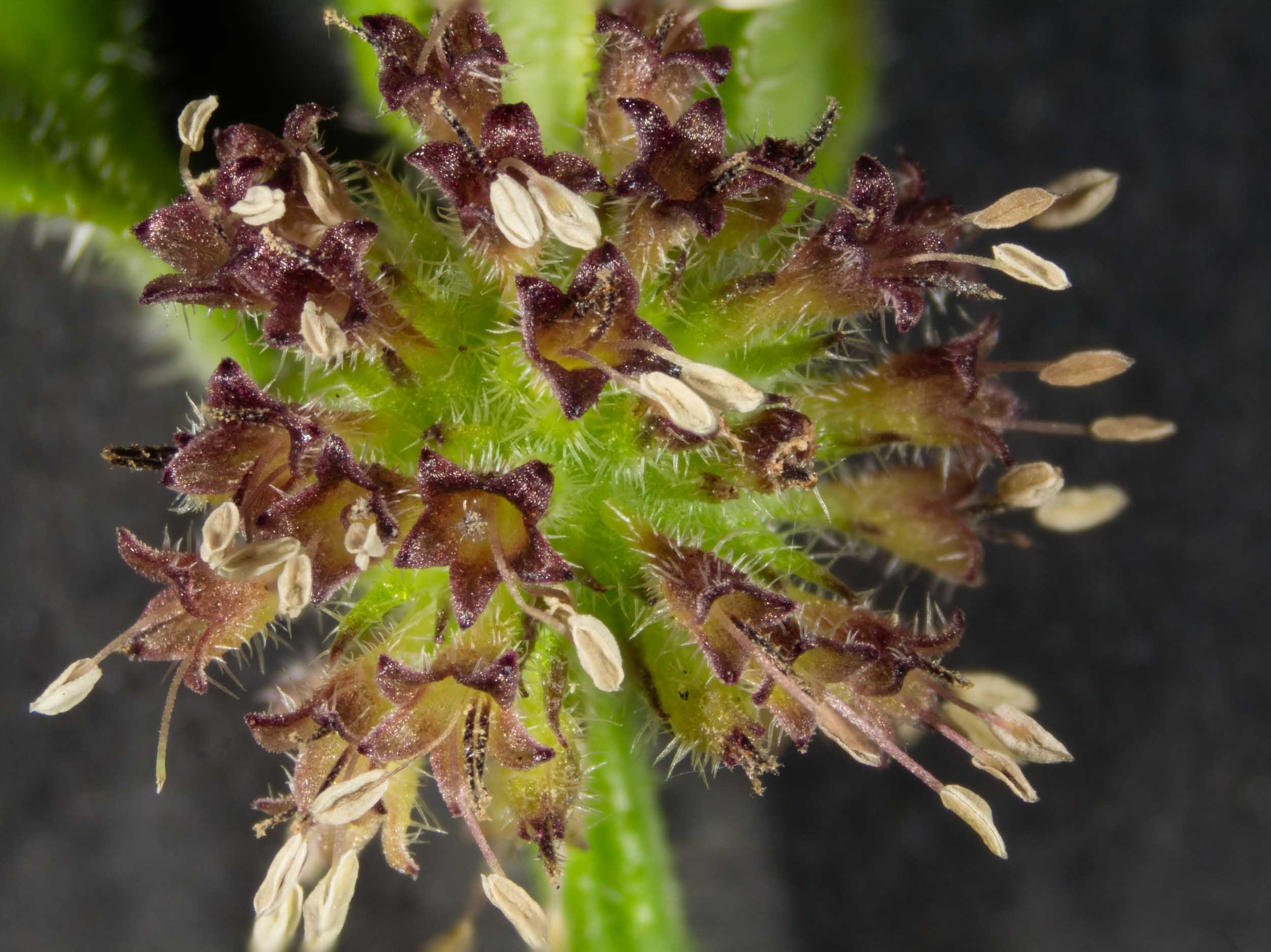
Coarse Stinkweed
Opercularia aspera
This is a widespread forb in the forest. Its common name is justified, as its vegetation has a rather unpleasant aroma when trodden on. On the upside, its inflorescence, a spherical head of 10-30 flowers, is rather beautiful.
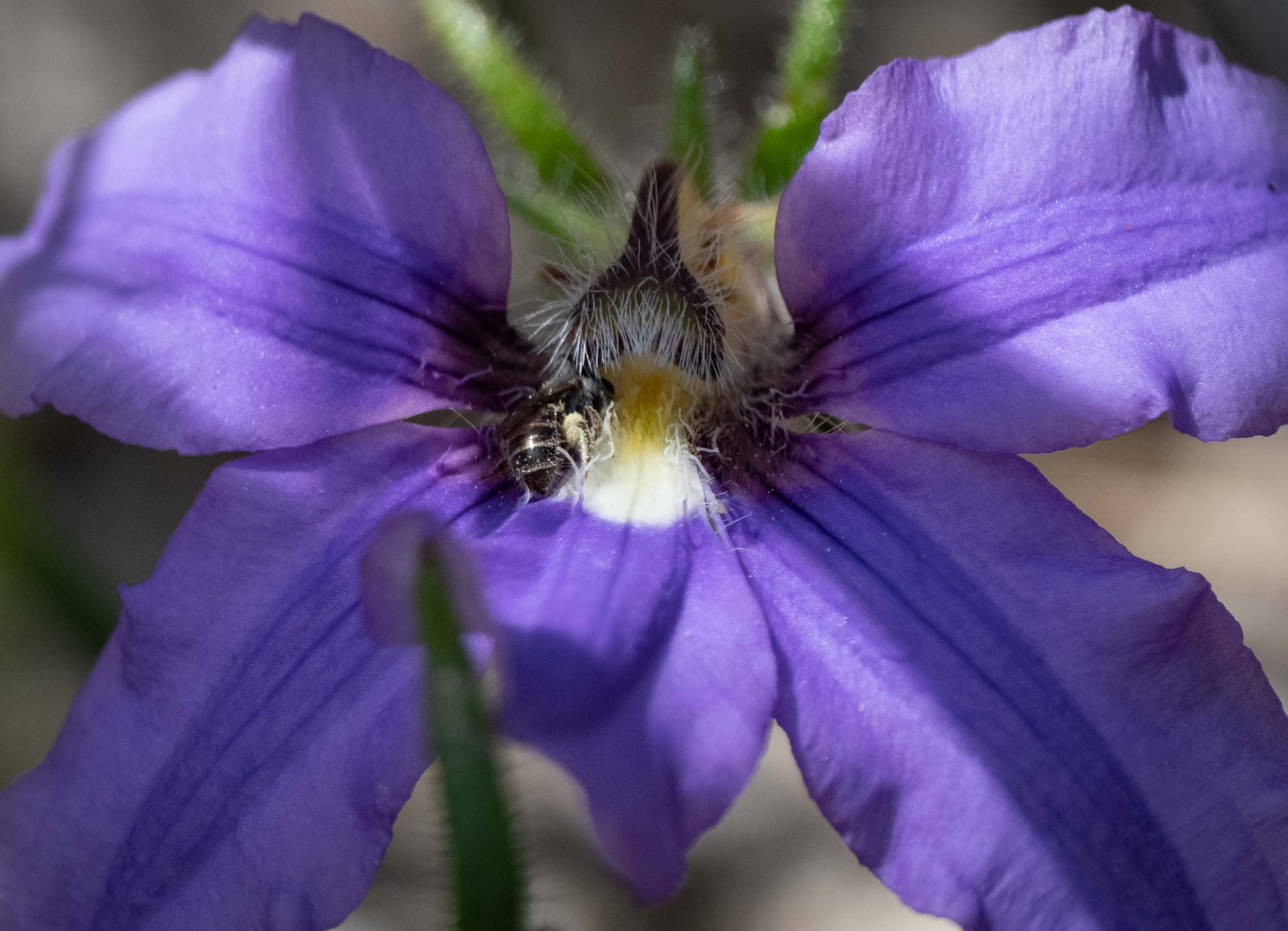
Hairy Fan-flower
Scaevola ramosissima
This is the first time I’ve seen an insect visiting these long-flowering plants … it’s a bee, and it’s tiny!
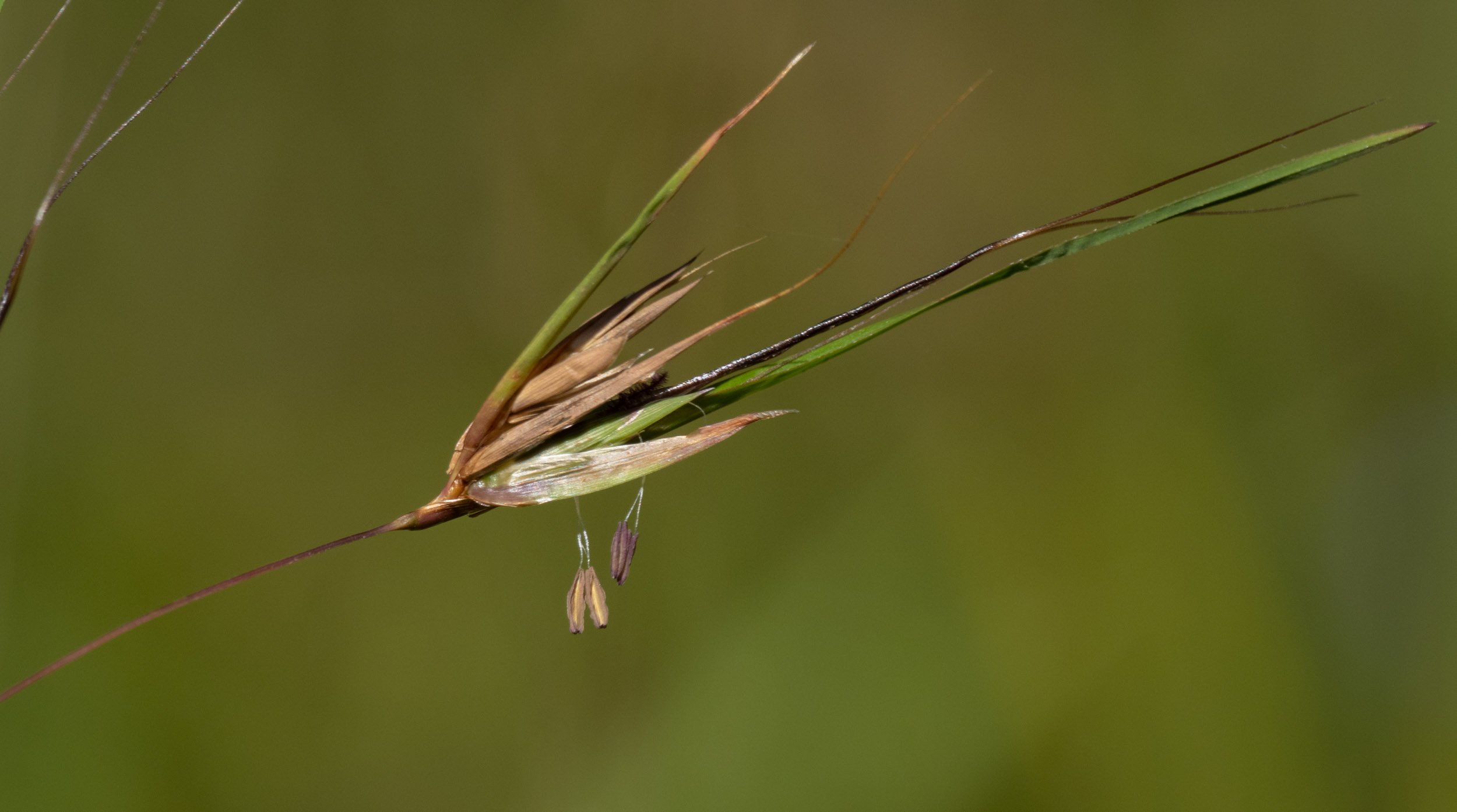
Kangaroo Grass
Themeda triandra
This grass with its unusual, complex inflorescence flowered strongly again this late spring/summer. It has an interesting, widespread distribution, being found in Asia, Africa and the Pacific and has traditional uses as food and medicine in both Africa and Australia.
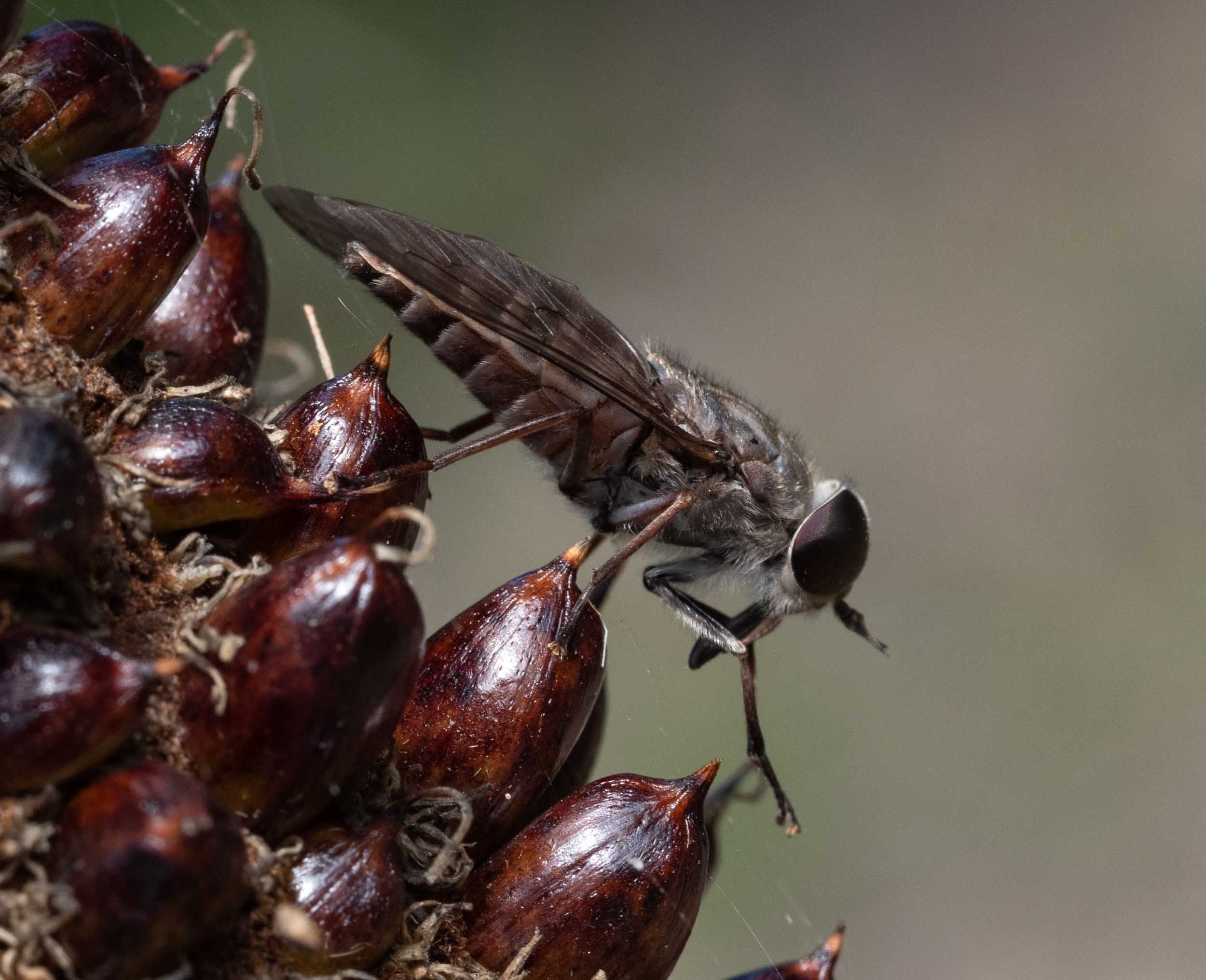
march fly
In late summer these rather notorious flies emerge, sometimes in very large numbers. And they bite! This summer has been particularly fly-filled, perhaps due to the high rainfall of the past few years. Tabanid larvae live in wet ground or aquatic environments, hunting invertebrates.
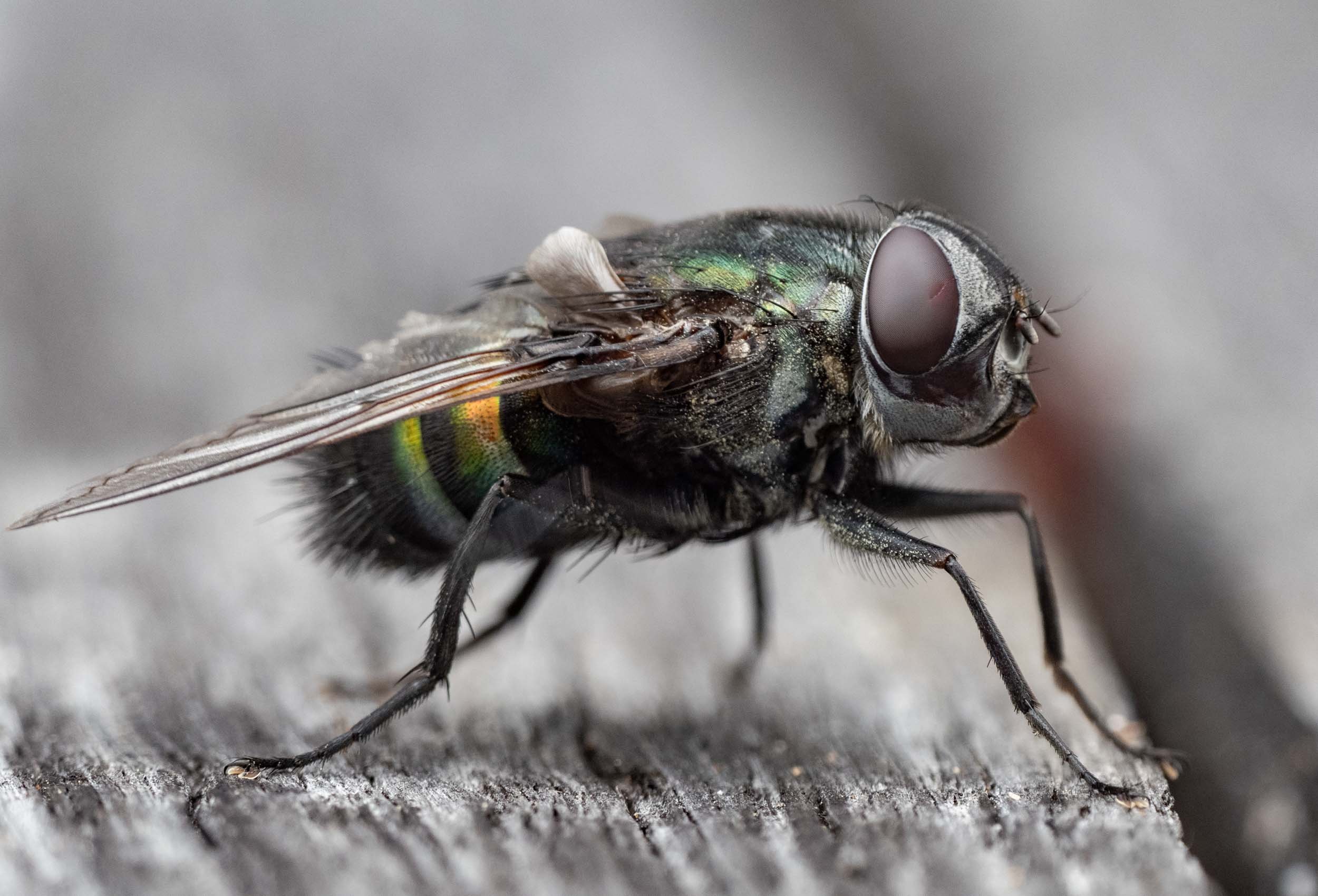
tachinid
This massive, metallic, bristly fly is harmless. No biting, no blood sucking. Tachinid larvae, however, are parasitoids. Among their hosts are caterpillars, beetle grubs and wasp larvae. Sawflies too … and we currently have large numbers of those clustered on eucalypt leaves (see Paul’s post Sawfly galleries)
Rutilia

ant fly
Small, hovering sluggishly, then settling on vegetation … and quite unlike any fly I’d seen before! It turns out that the adults are not common, and their biology fascinating. The larvae live inside ant colonies, feeding on ant larva and pupae … protected by a shell! In the past they’ve even been mistaken for molluscs! Little, tank-like armoured hunters.
Archimicrodon

a regular hover fly
This is the archetypal, ubiquitous hover fly. So very unlike its cousin the ant fly. Syrphine larvae are predators of aphids and other plant-sucking bugs. The adults are commonly seen at flowers, although at this time of year they are probably relying on honeydew.
Simosyrphus grandicornis
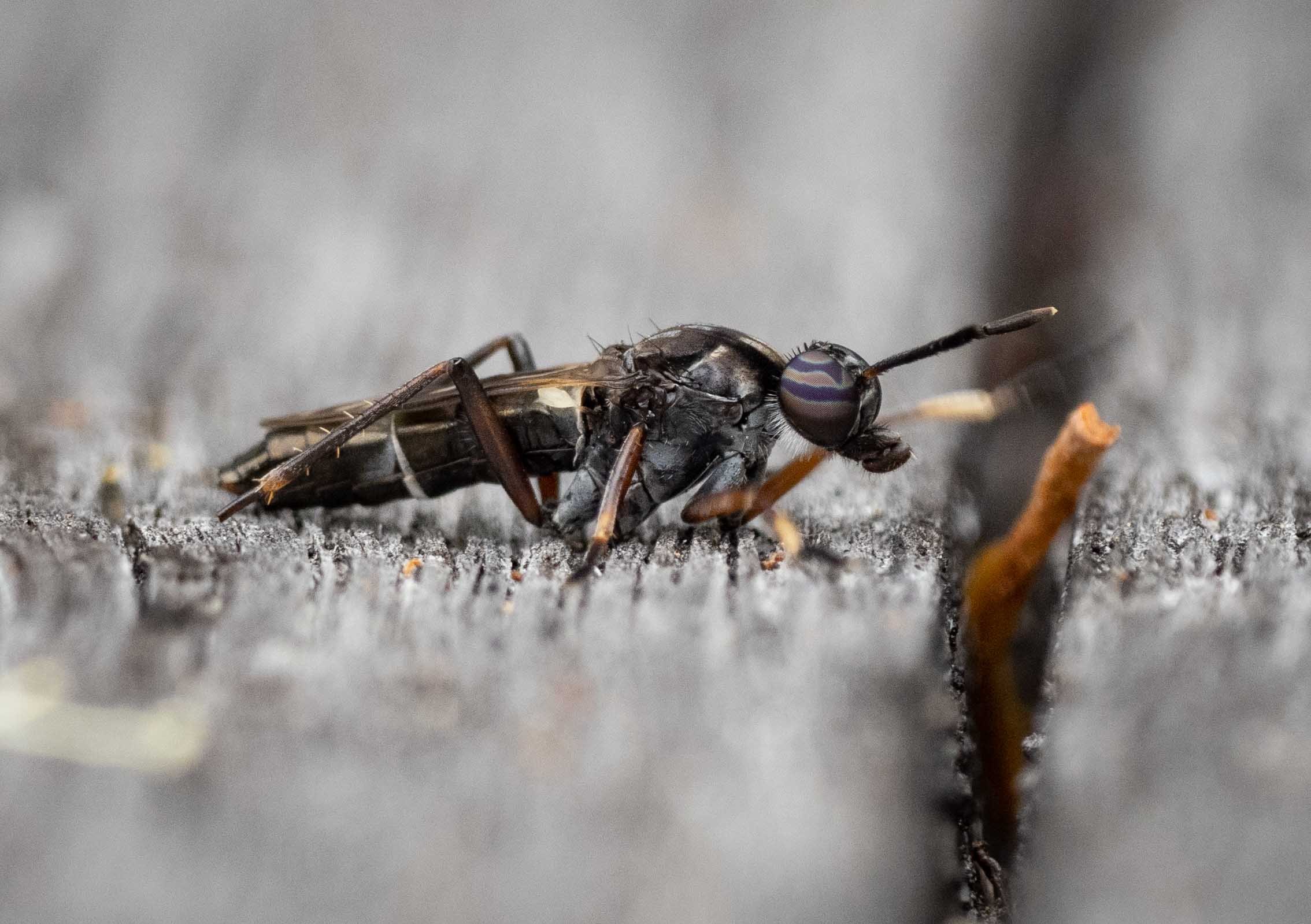
stiletto fly
Small, unfamiliar, and a remarkably forgiving photography subject … not flying, just waving a leg occasionally. Adults are nectar feeders but their wiry larvae are fossorial predators, hunting other invertebrates in dry soil.
Agapophytus queenslandi
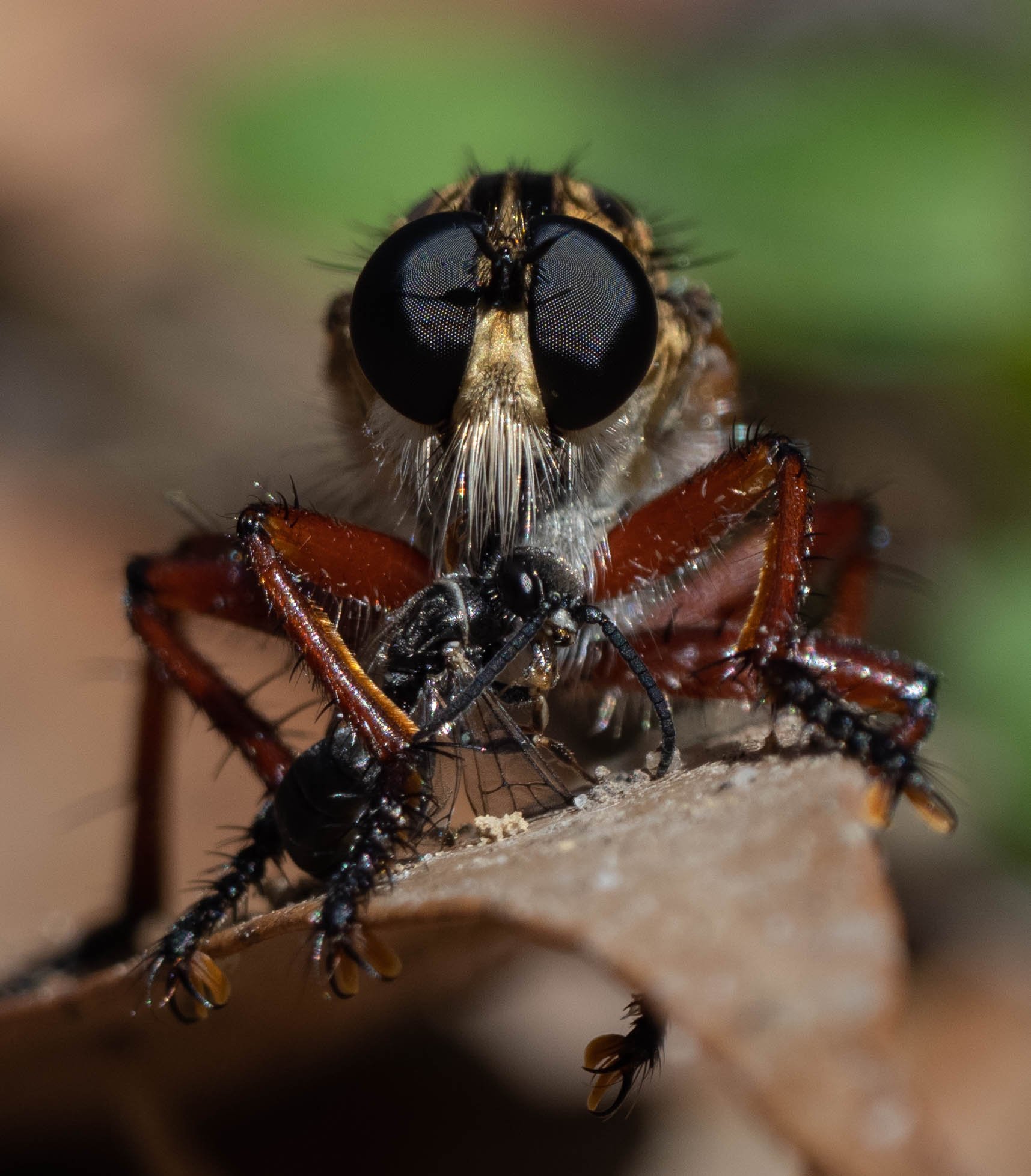
robber fly with flower wasp
Robber flies are accomplished aerial hunters, often taking well-defended prey. The fly has strategically impaled this flower wasp through the neck. Within seconds the prey had stopped moving completely.
Zosteria
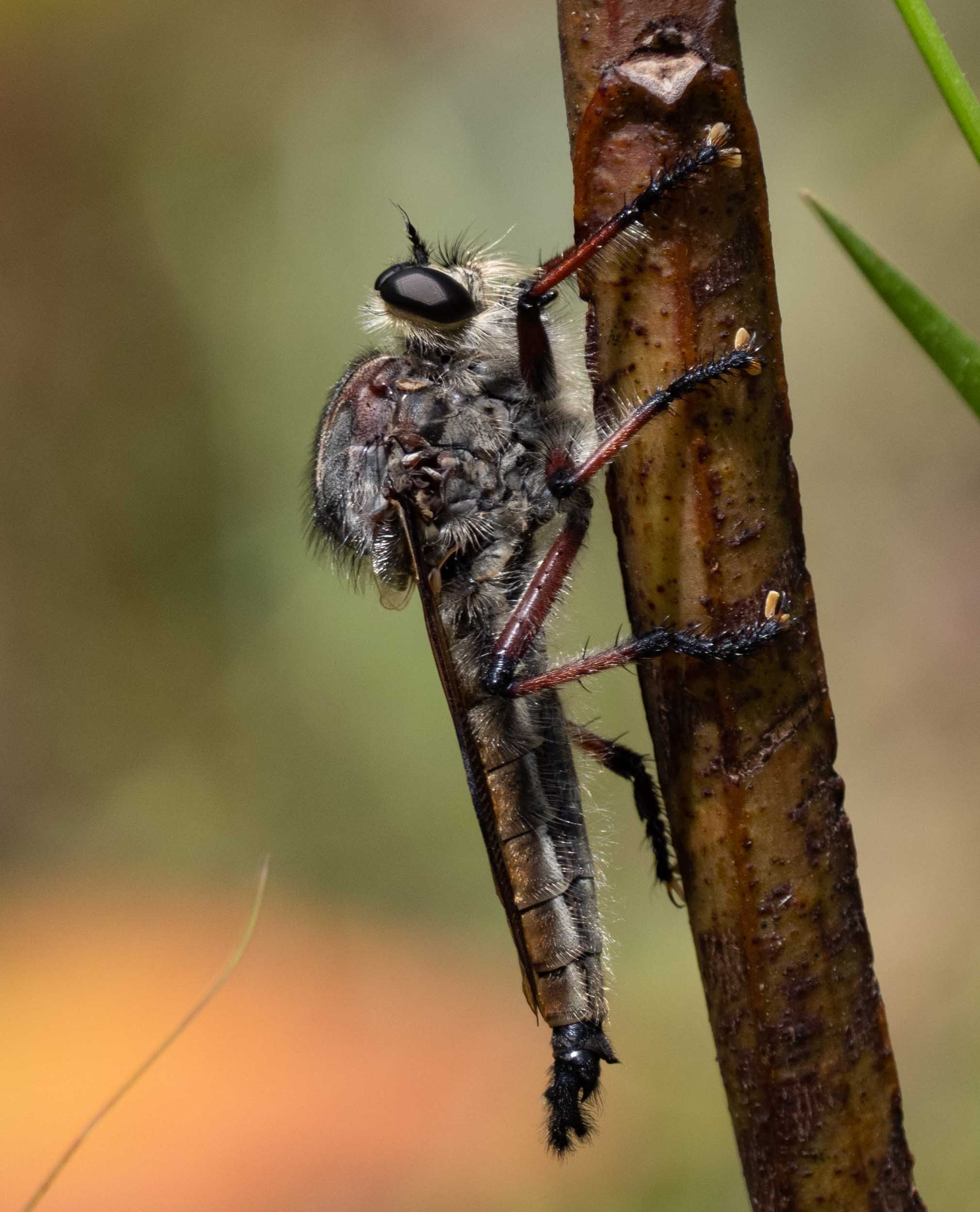
robber fly
Asilidae is one of the largest fly families. Australia has nearly 400 species of robber flies across 68 genera, most of them endemic.
Neoaratus hercules
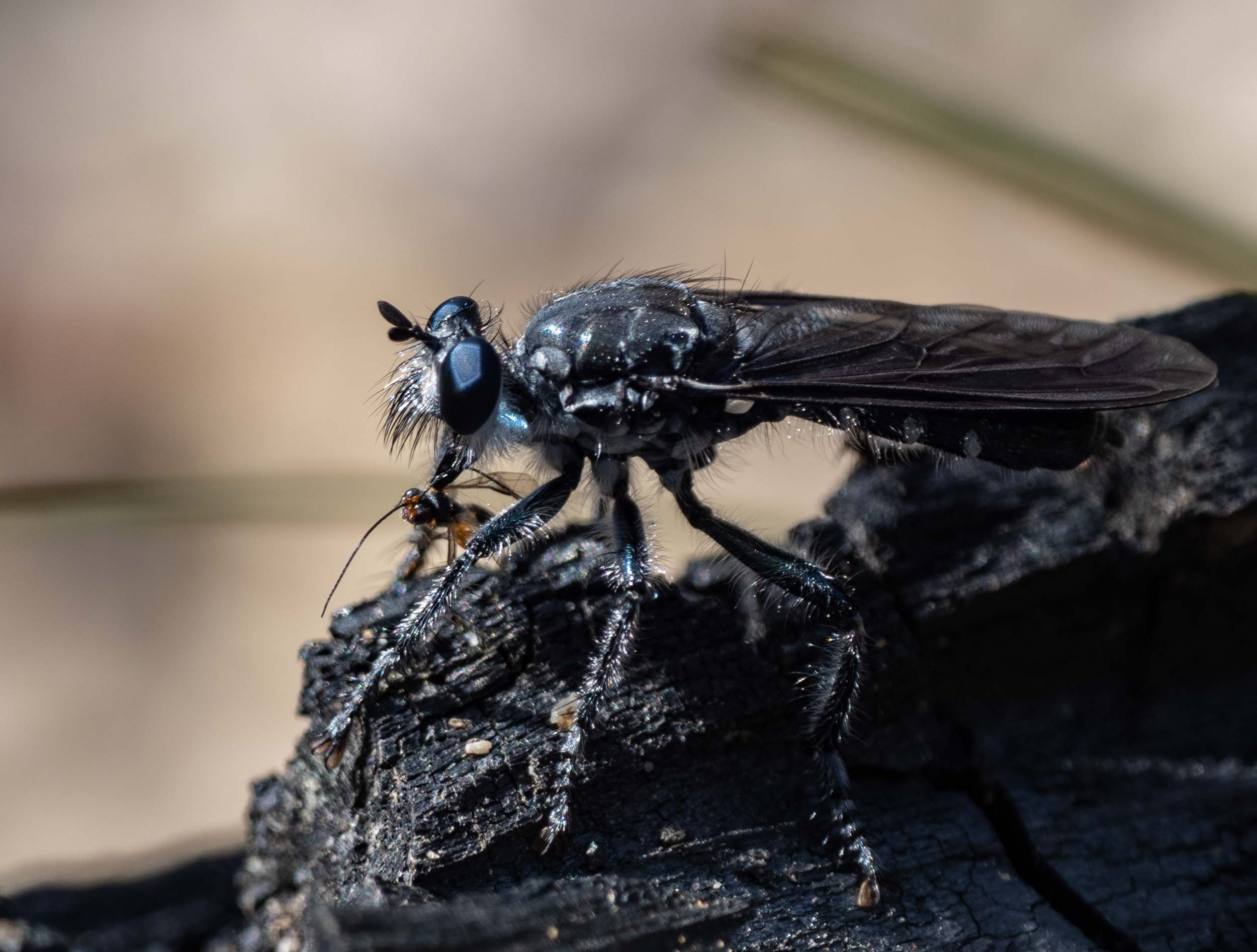
predators - as adults & as larvae
The larvae of robber flies typically live in soil, decaying wood or under bark. They hunt soft-bodied prey such as beetle grubs and digest them extra-orally before ingesting the liquified tissues. Just like their parents.
Orthogonis
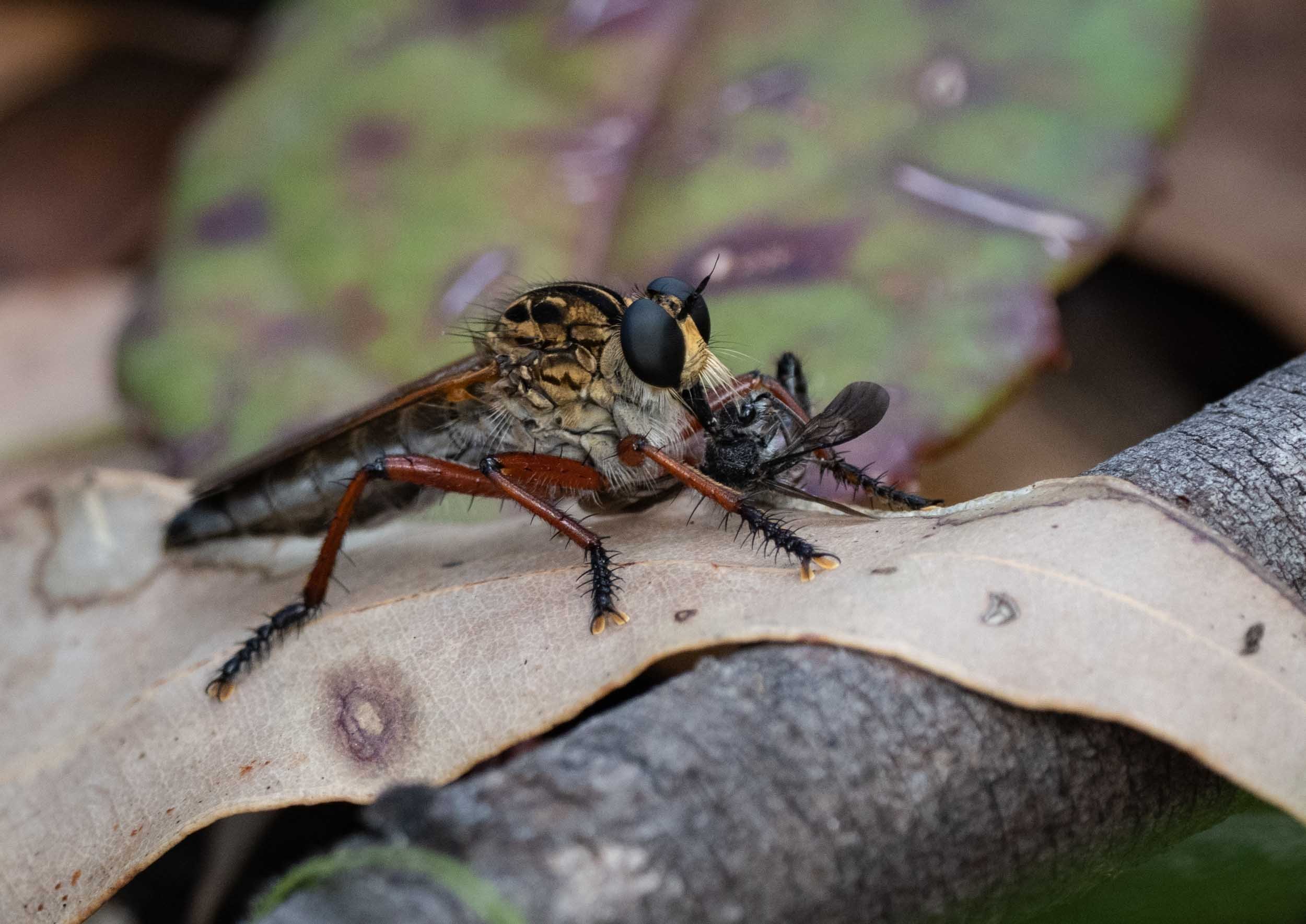
robber fly with velvet ant
I had been watching sand-nesting wasps and the associated patrols by velvet ants (Mutillidae), when this robber fly landed nearby. It appears to have nabbed one of the male velvet ants. That’s impressive, as mutillids are fast flyers.
[at least, I think it’s a mutillid … some flower wasps look quite similar]
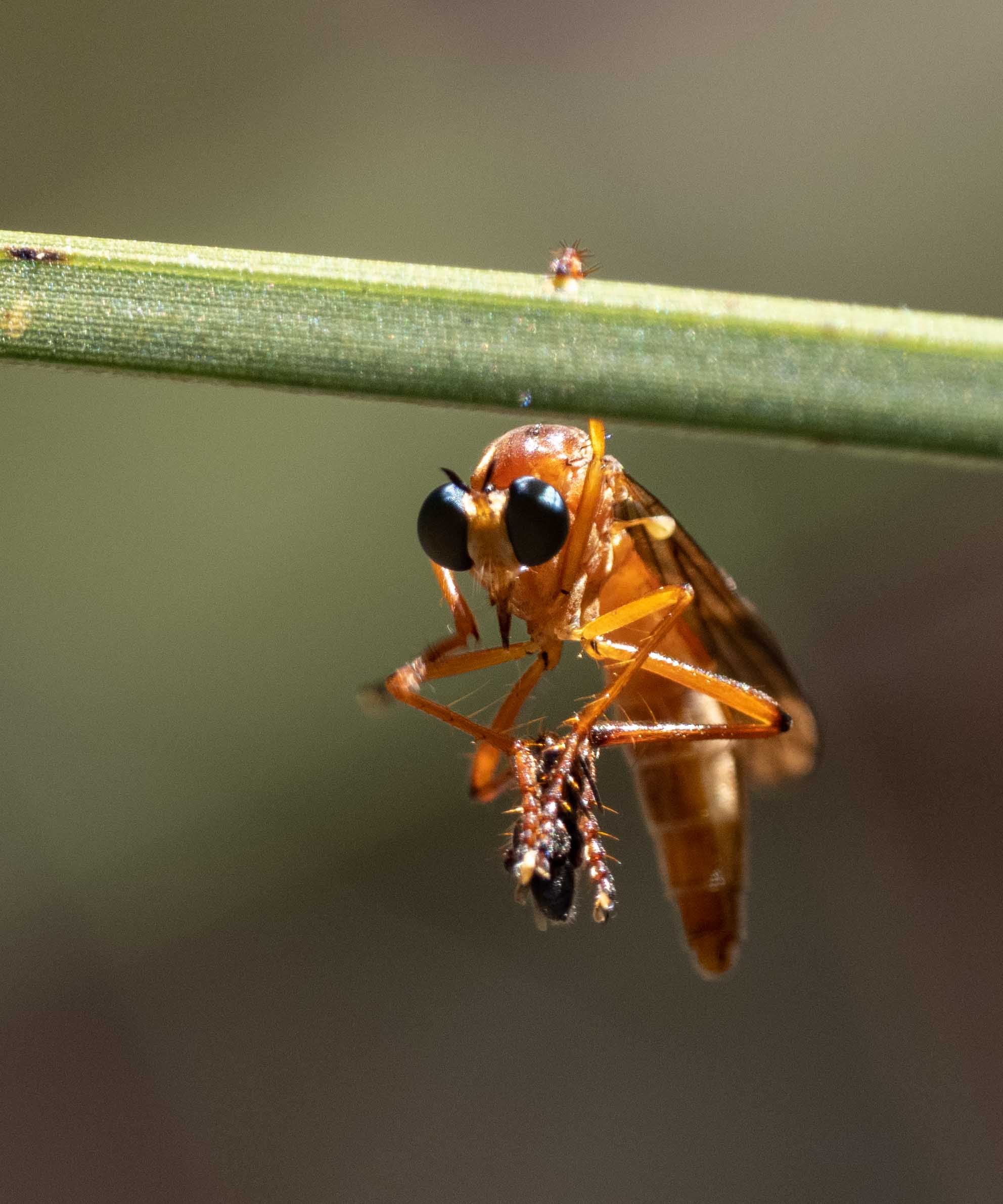
a mystery robber fly
Hanging by one leg while consuming prey is apparently typical behaviour for members of this subfamily. First time I’ve witnessed it, though. And the species identity remains a mystery too (see iNaturalist record).

robber fly with a large meal
Robber flies are among the most commonly photographed insects. They sit motionless, in the sun, often with impaled prey. It takes a while to liquify and ingest the contents of the hapless victim. The saliva of the robber fly contains nerve toxins (to immobilise) and enzymes (to break down proteins).

courtship display
These small, colourful flies slouch at the tips of plants … and dance. The moves involve repeated, alternating leg raises accompanied by wagging of the abdomen. Various members of the family are renown for their courtship display, so I assume that this one is trying to attract a mate.
Brachyrhopala ruficornis

small robber fly, tiny prey
This is one of the smaller robber flies we see, but it is still larger than many. Some species are just a few mm long! As a larva, this species probably prowled beetle burrows in wood.

yet another species of robber fly
Medium in size, yet willing to take tiny prey.
Cerdistus
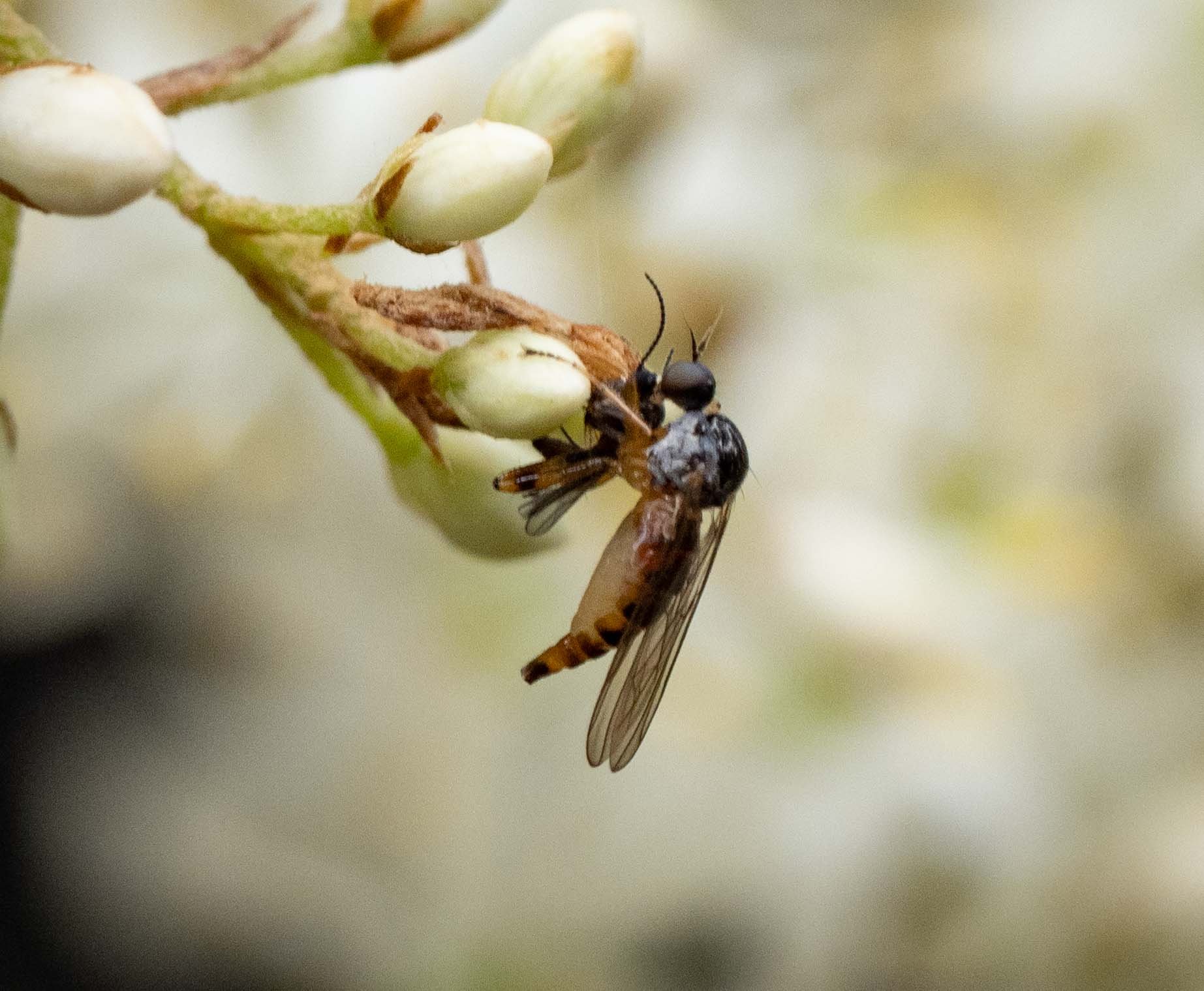
tiny dance fly
A tiny predator, with even smaller prey. They behave very much like robber flies, flying to and from hunting perches to seize flying insect prey.
Hoplopeza

blowfly
Amenia. A rather spectacular blowfly. Females deposit their well-developed larvae (i.e. maggots) onto snails … although the details are known for just a few species. And we really have rather few snails here (?)
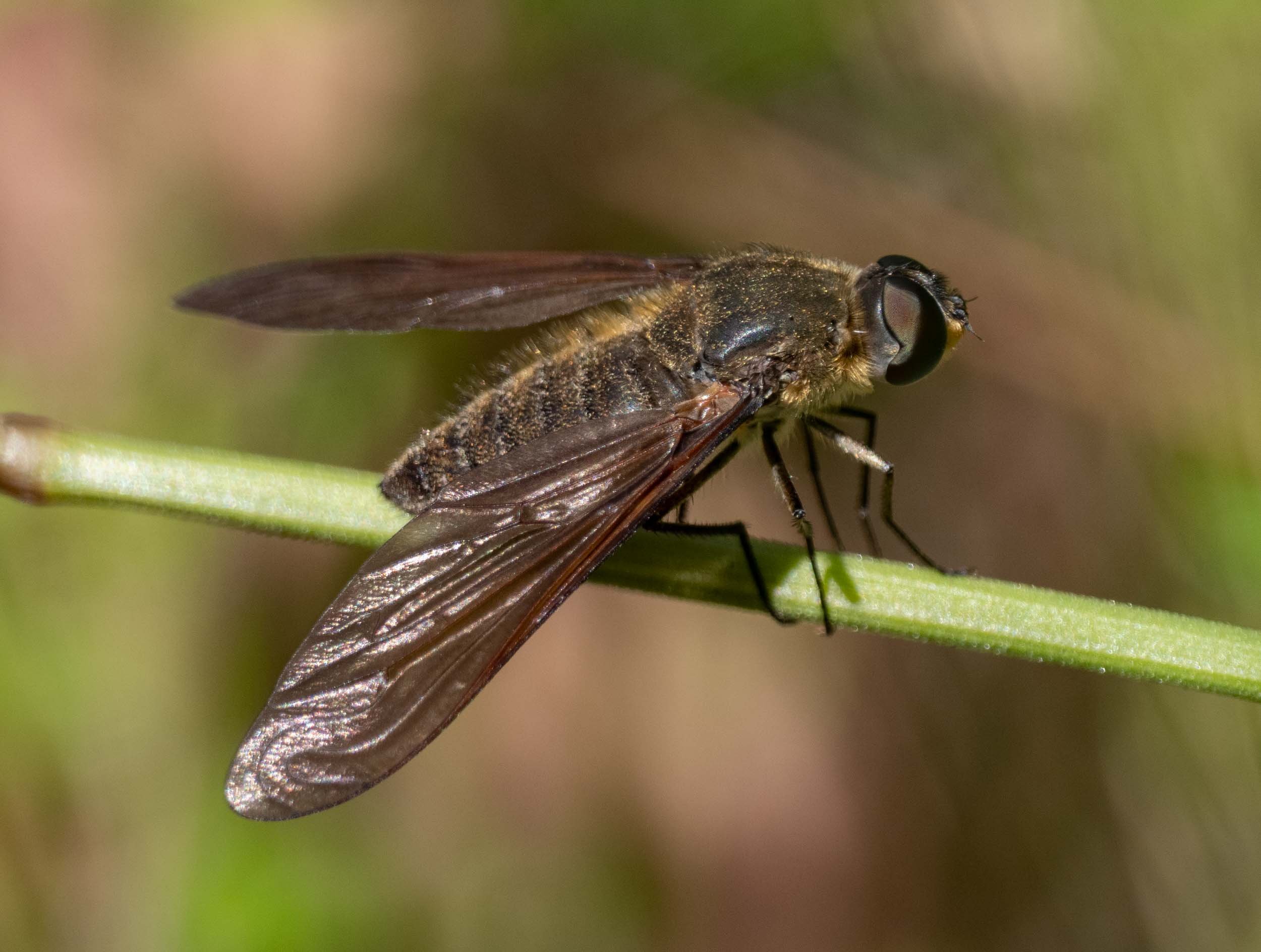
long-winged bee fly
Comptosia. The biology of this group is not well documented. The larvae may feed on ants, beetles or other insects.
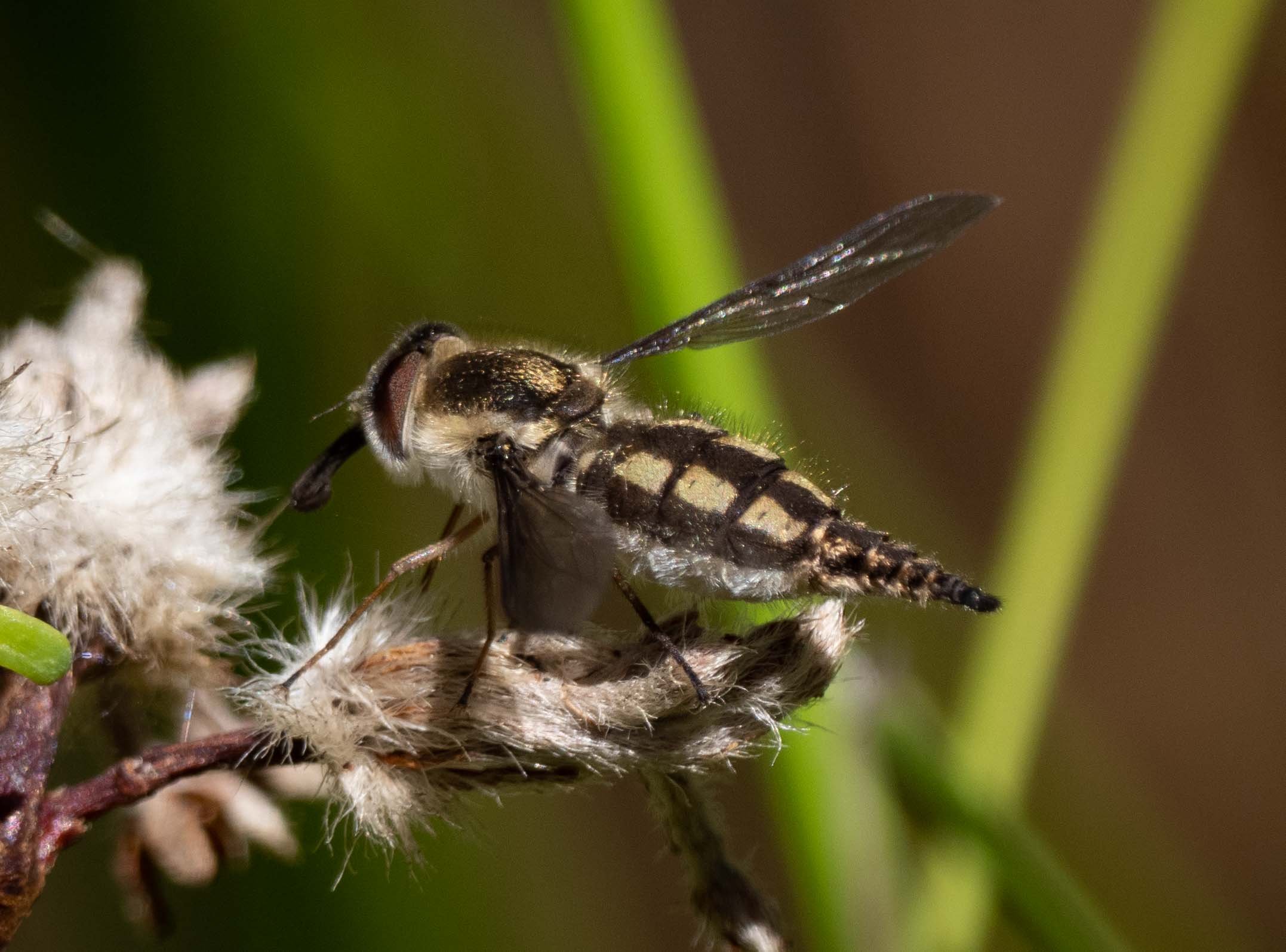
tangleveined fly
These fast-flying insects take only nectar as adults, despite that impressive looking proboscis. Females like this one will lay thousands of eggs amongst vegetation. The resulting larvae actively seek and penetrate their target hosts – grasshoppers & katydids.
Trichophthalma
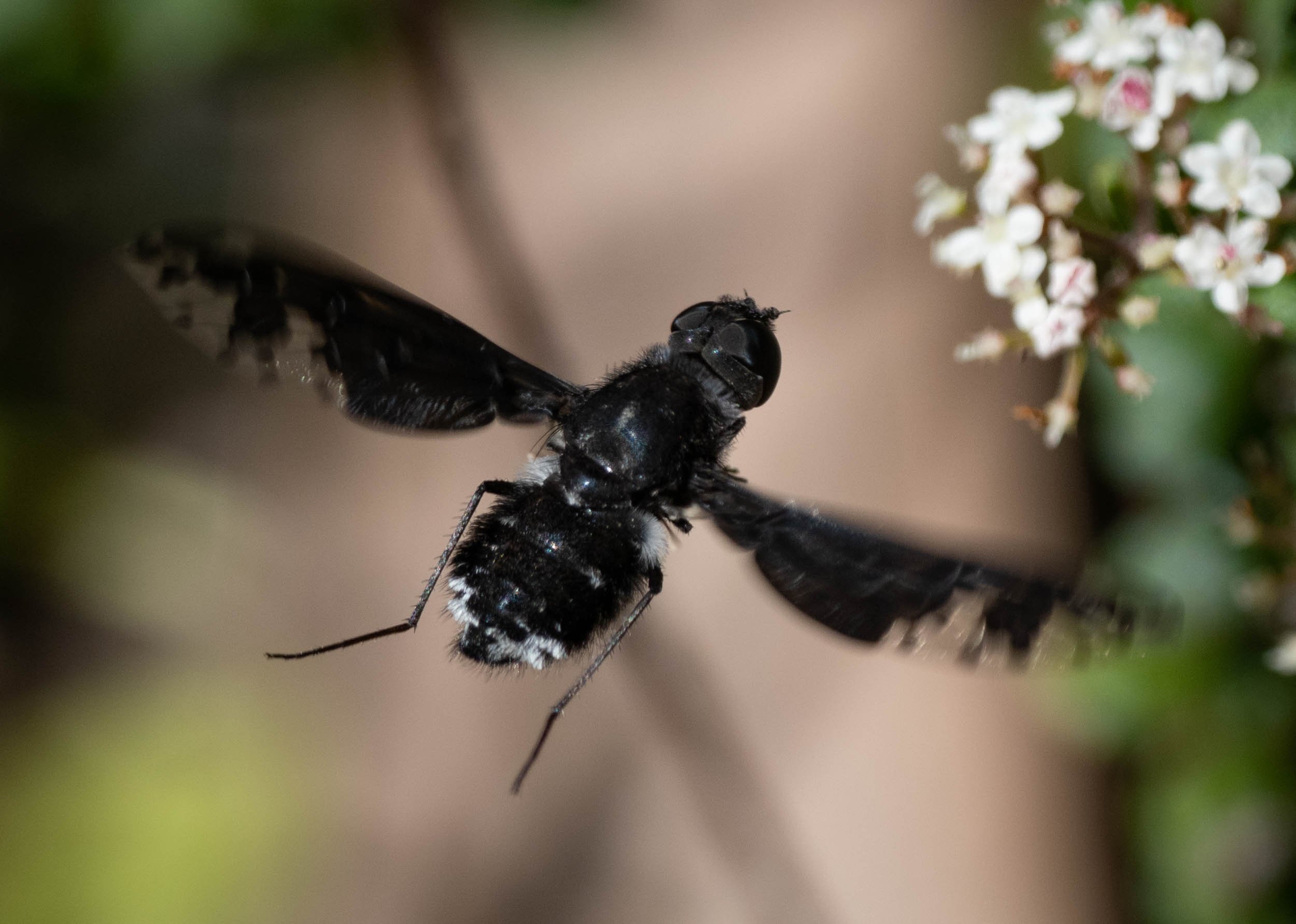
bee fly
Adults are usually seen feeding on nectar at flowers or touching down on sand. Larva typically attack ground-nesting wasps & bees - as ectoparasites, kleptoparasites or predators.
Anthrax maculatus

bee fly
These banded bee flies are common and have been abundant all summer. They vary in size, and some are tiny.
Villa, or another member of the tribe Villini

signal fly
Males use that flat face to bump heads in defence of their territories. Larvae of this family typically feed on bacteria in decaying plants, fungus or dung, although some feed inside the root nodules of legumes.
Duomyia
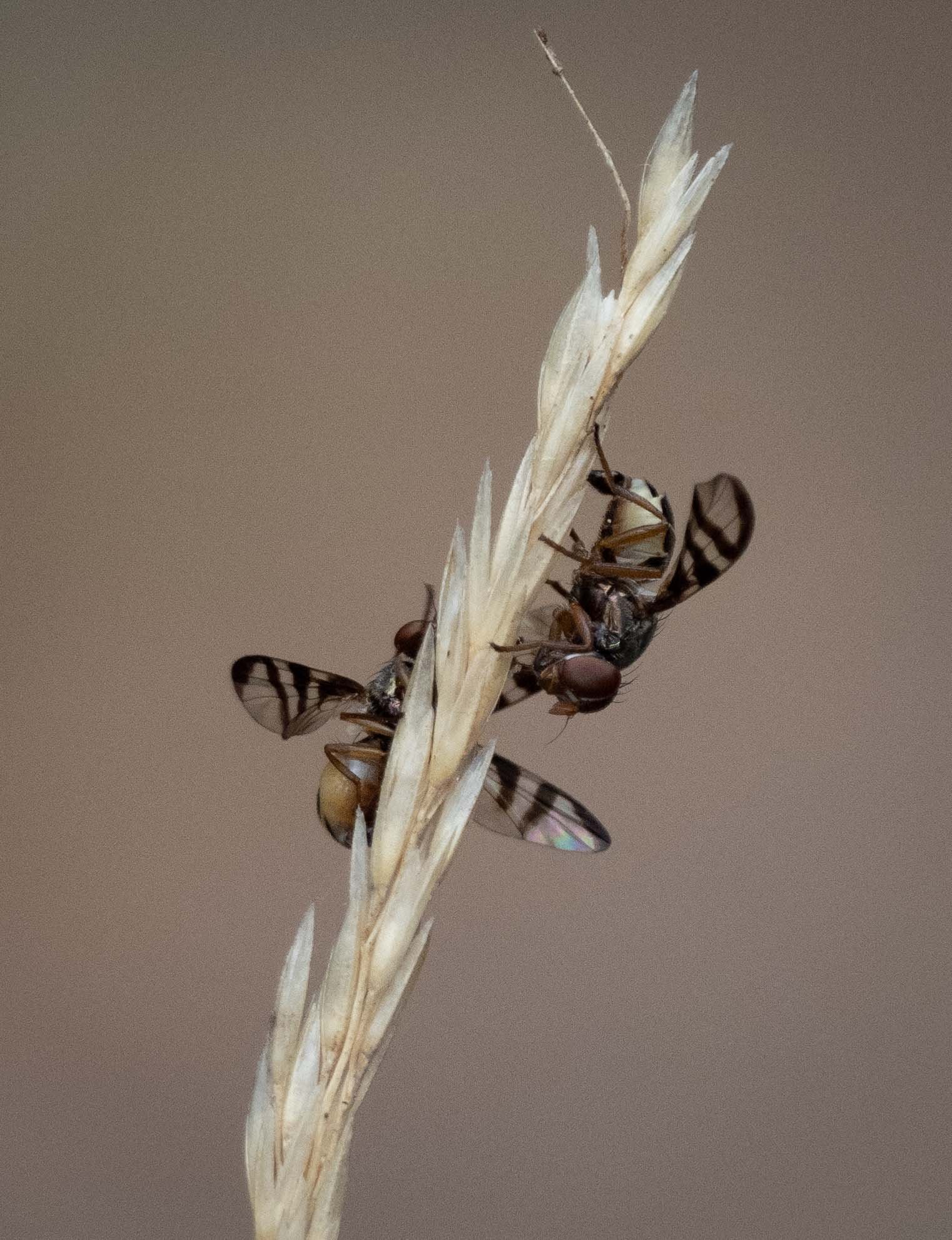
signal flies
Small and with the characteristically-marked wings of this genus … but this behaviour is novel. We commonly see Rivellia in mating swarms around fresh wallaby and wombat dung. But these two females were alone and quite intent on laying eggs into this dry grass seed head. I guess there are bacteria in all kinds of places.
Rivellia
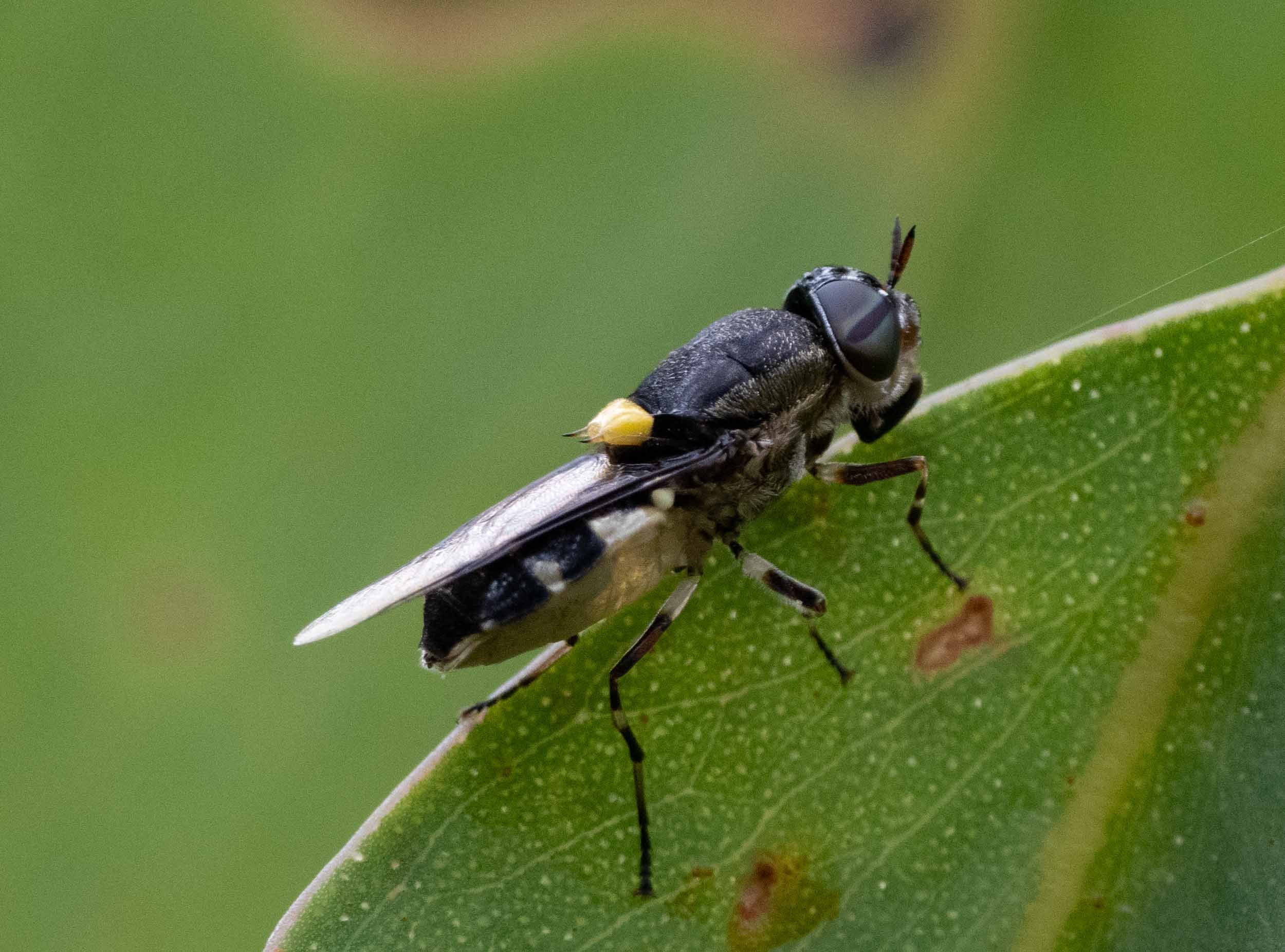
a novel soldier fly
Our first and only sighting of this species here in the forest. And given that the larvae are aquatic filter-feeders, perhaps that’s no surprise. Then again, we get dragonflies in large numbers …
Odontomyia hunteri
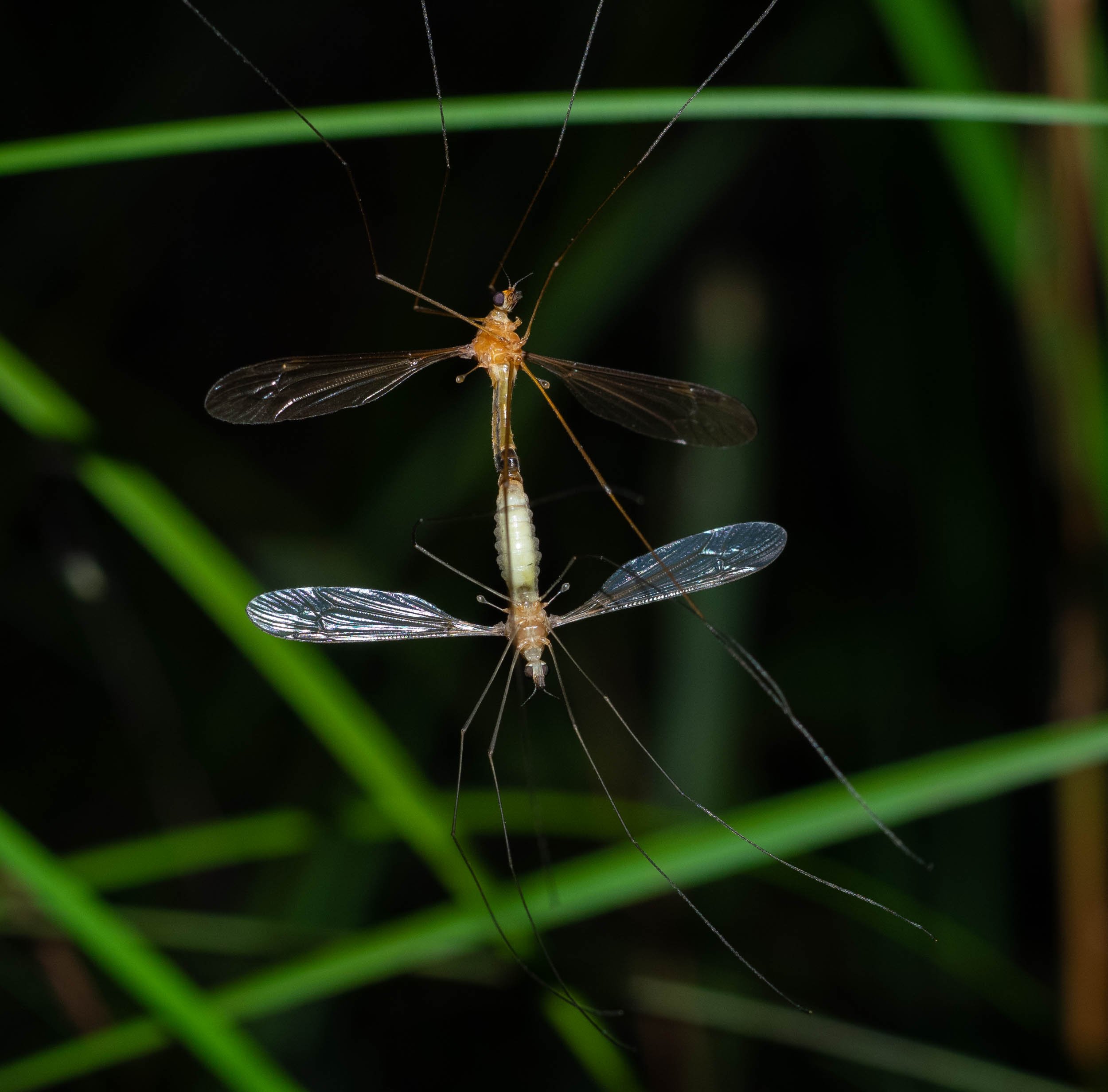
mating crane flies
Large, familiar crane flies. Larvae feed on decaying plant material, and may make a significant contribution to leaf litter break down.
Leptotarsus
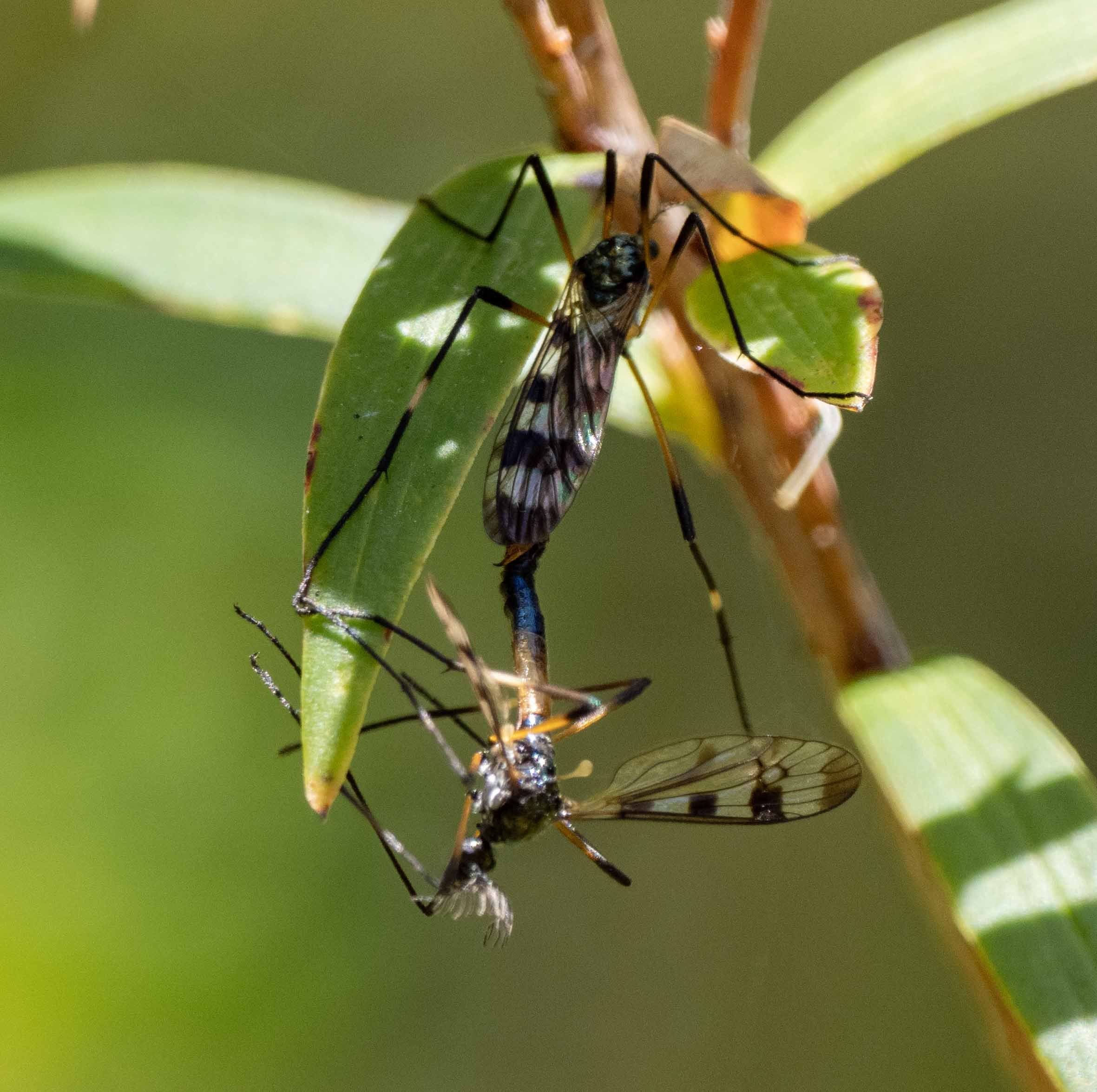
Limoniid crane flies
They look and behave rather like ‘regular’ crane flies, and were once grouped in that family.
Gynoplistia bella
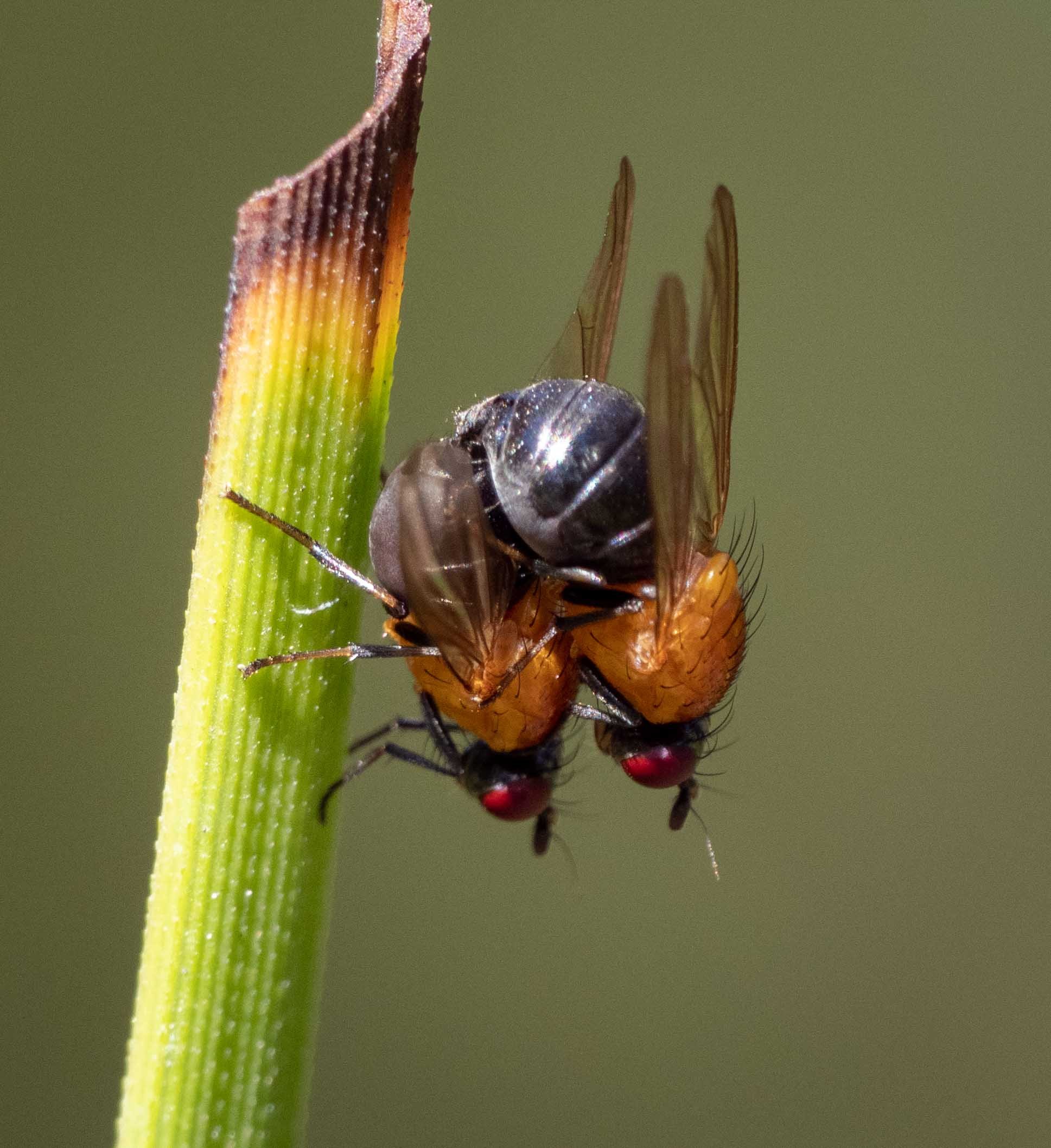
lauxaniid flies
Vegetarian, as adults and as larvae. Well, many feed on fungi and decaying plant material but that counts as vegetarian by most definitions.
Sapromyza
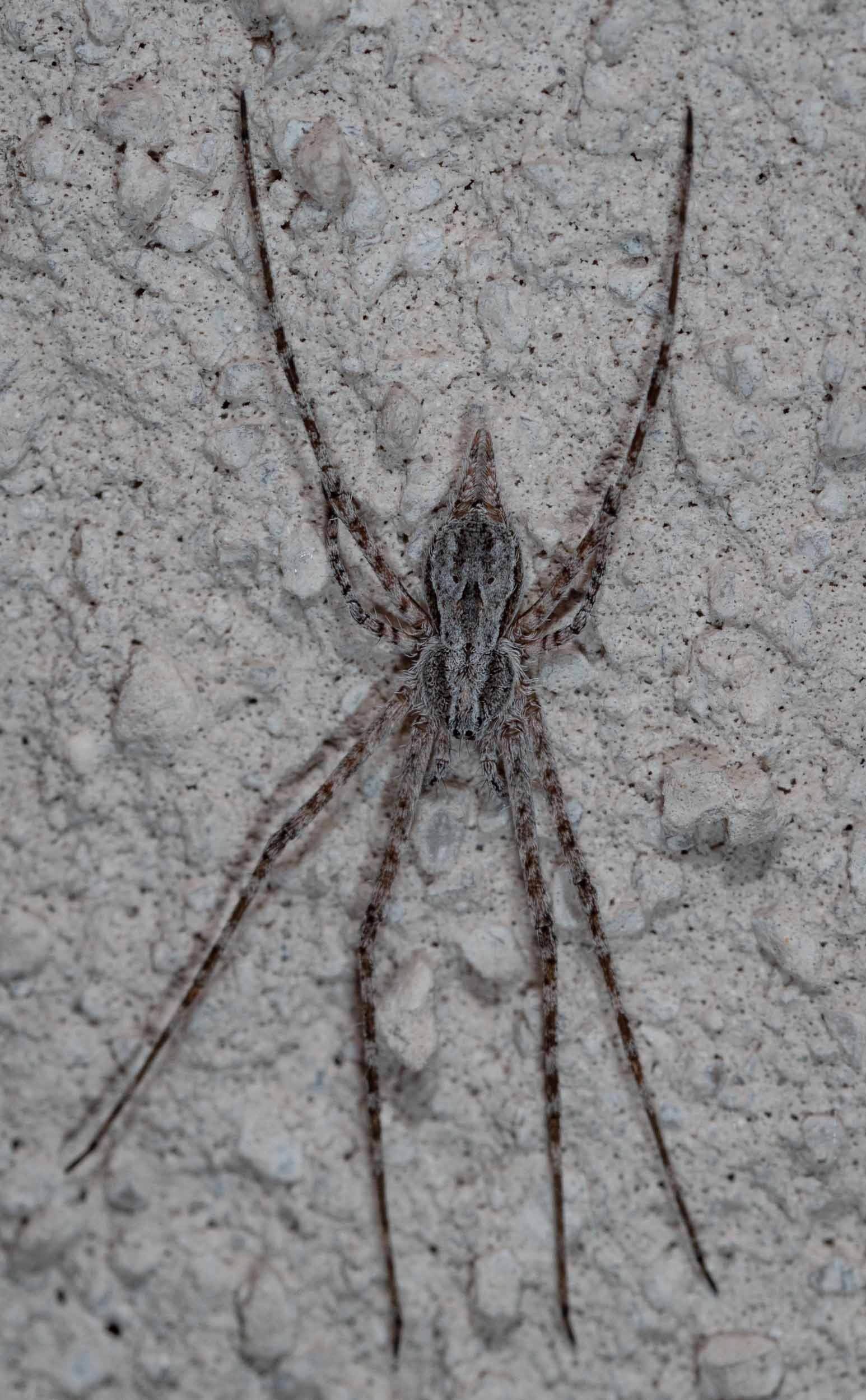
two-tailed spider
Tamopsis, perhaps.
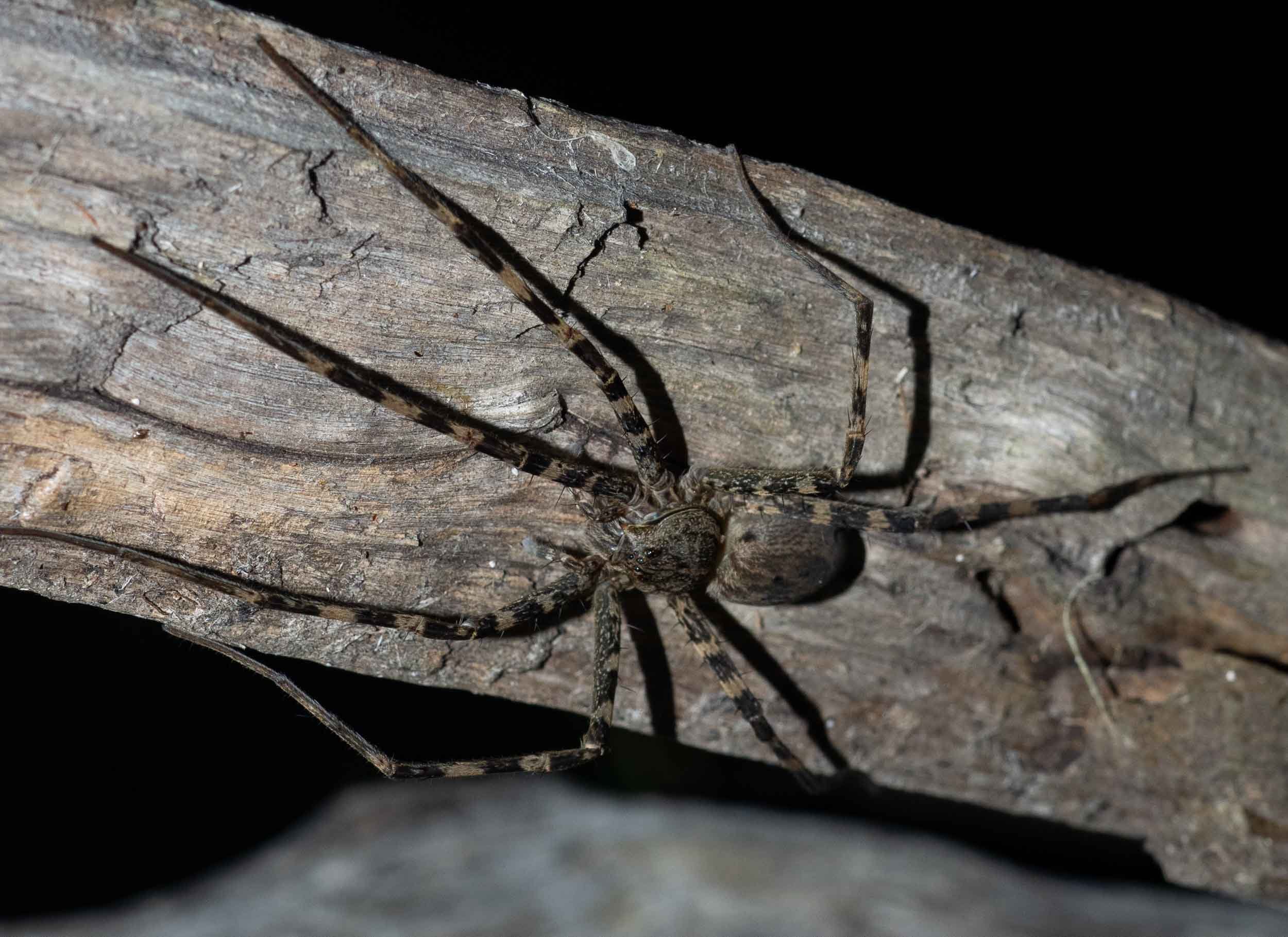
fishing spider...
Megadolomedes
This is one very large spider, hunting in and around the frog pond at night. And yes, they can swim! She could easily take a tadpole, and almost certainly does. For scale, the branch is 40mm wide.
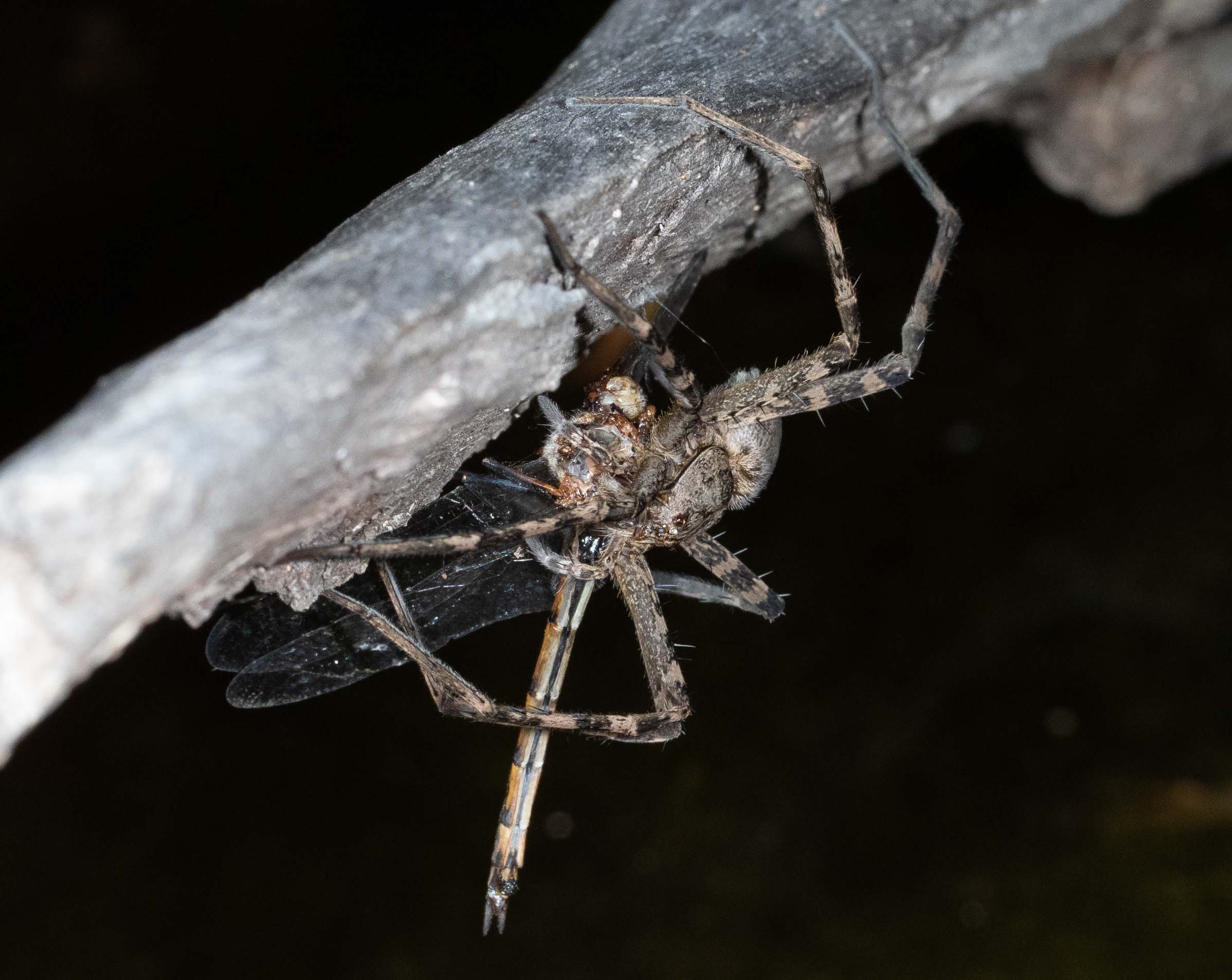
...with prey
Megadolomedes
Hunting in the dark, by stealth and without the aid of a web, she has landed a large prize. The daytime predatory dragonfly becomes night time prey.

Red-and-black Spider
Could belong to any of several genera which all have a similar appearance.

tiny wolf spider
Artoria
A tiny wolf spider, but clearly mature … that’s an egg sac she’s carrying about, attached to her spinnerets.
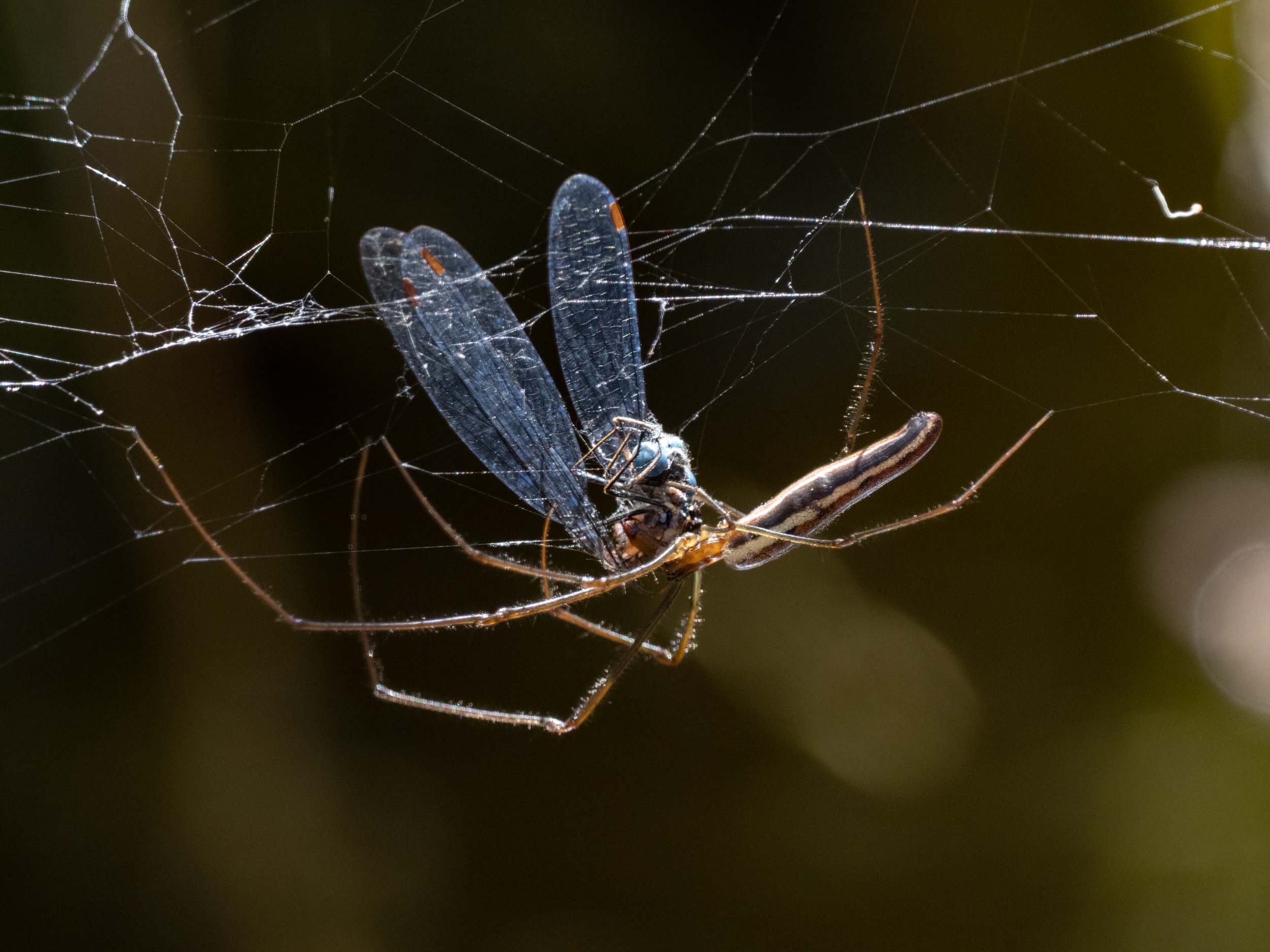
long-jawed spider ... with damselfly remains
Tetragnatha
The looping webs of these spiders hang over the frog pond and are the undoing of many dragonflies and damselflies.
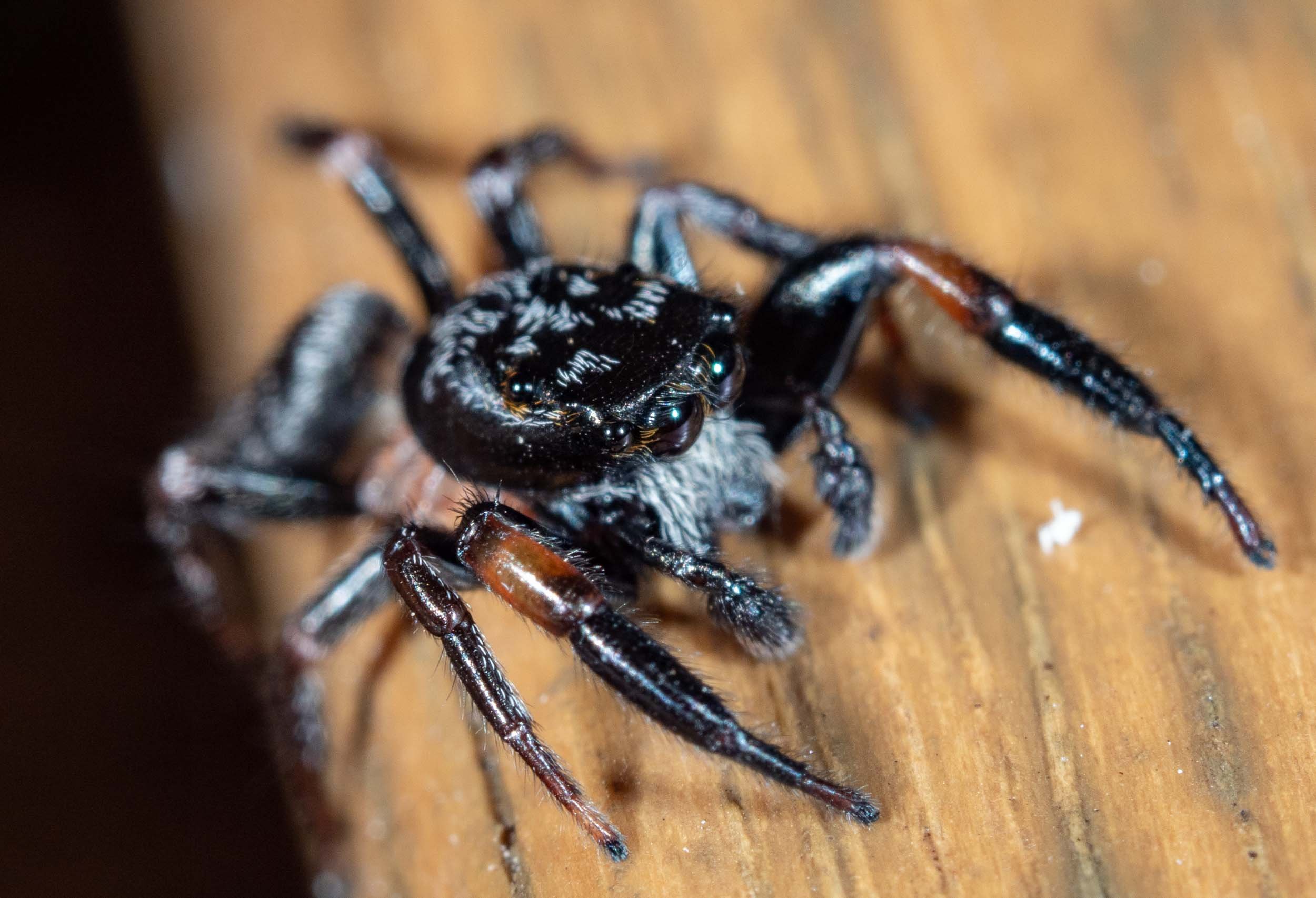
jumping spider
Pungalina plurilineata
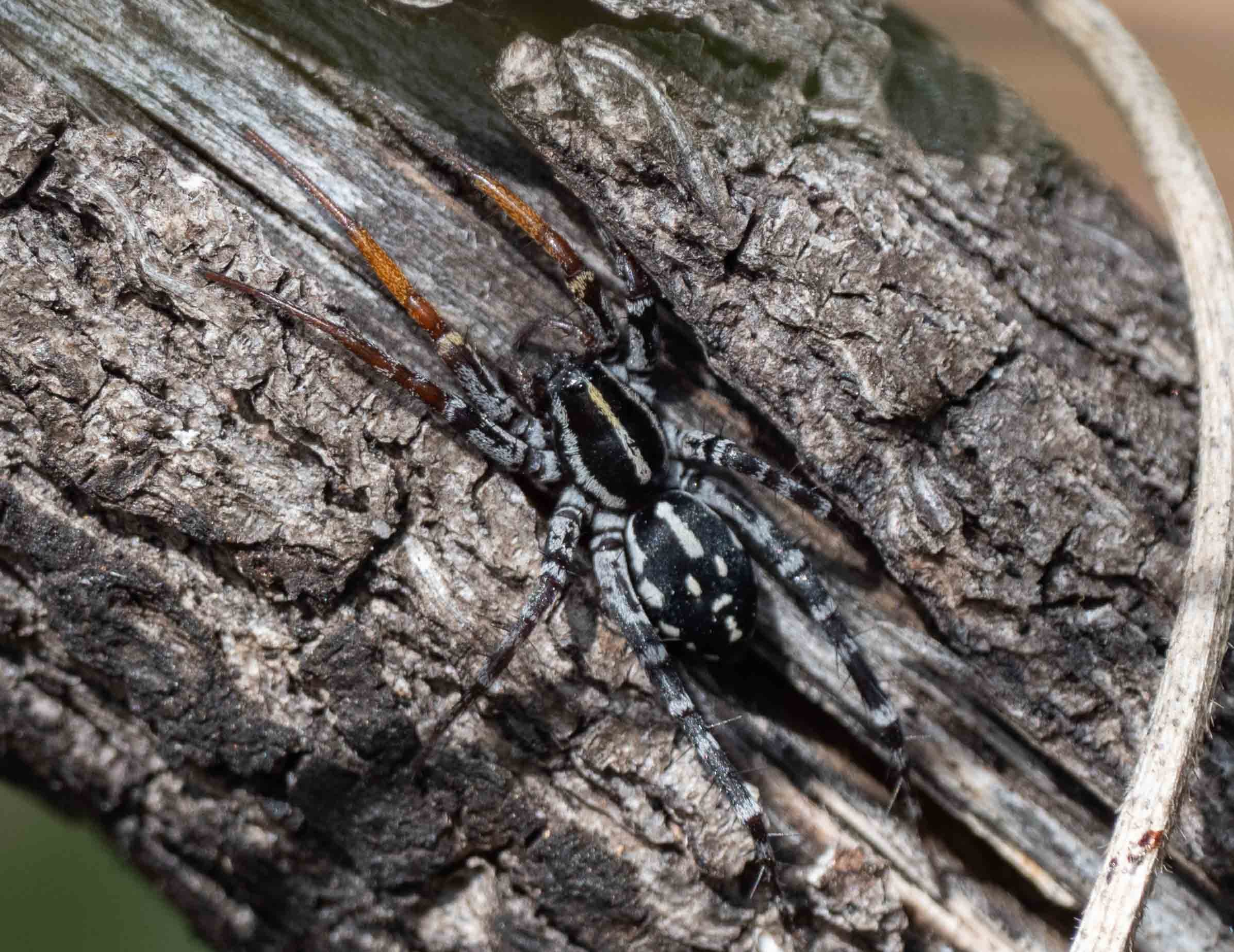
Spotted Ground Swift Spider
Nyssus coloripes
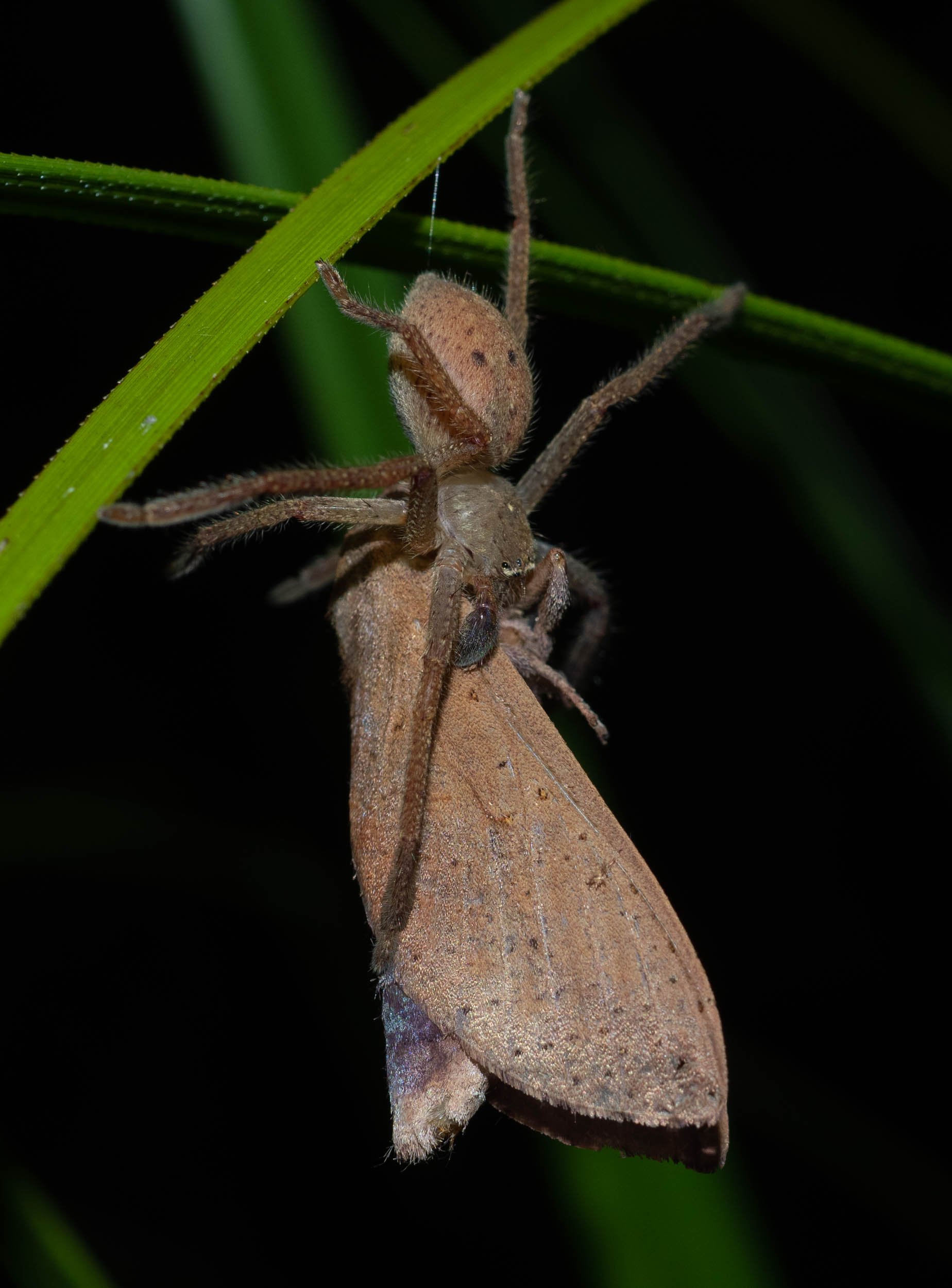
huntsman with ghost moth
Neosparassus
One of the thousands of Elhamma falls prey to a small huntsman.
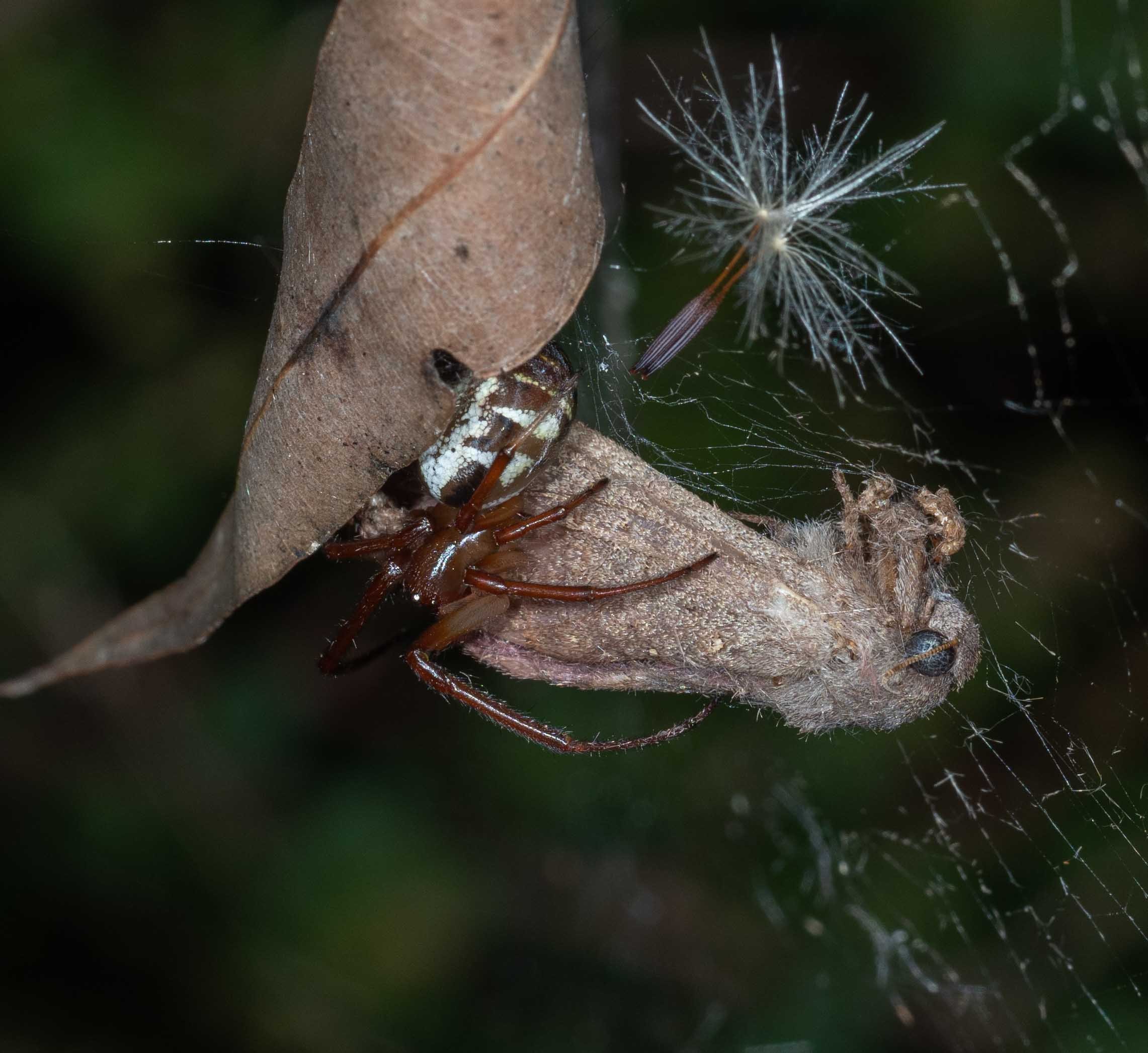
leaf-curling spider
Phonognatha graeffei
Yet another Elhamma falls prey to a spider, this one caught in a web.

a tiny wasp
Gasteruption
The larvae take over the nests of solitary wasps and bees, eating the larvae and the food stash.
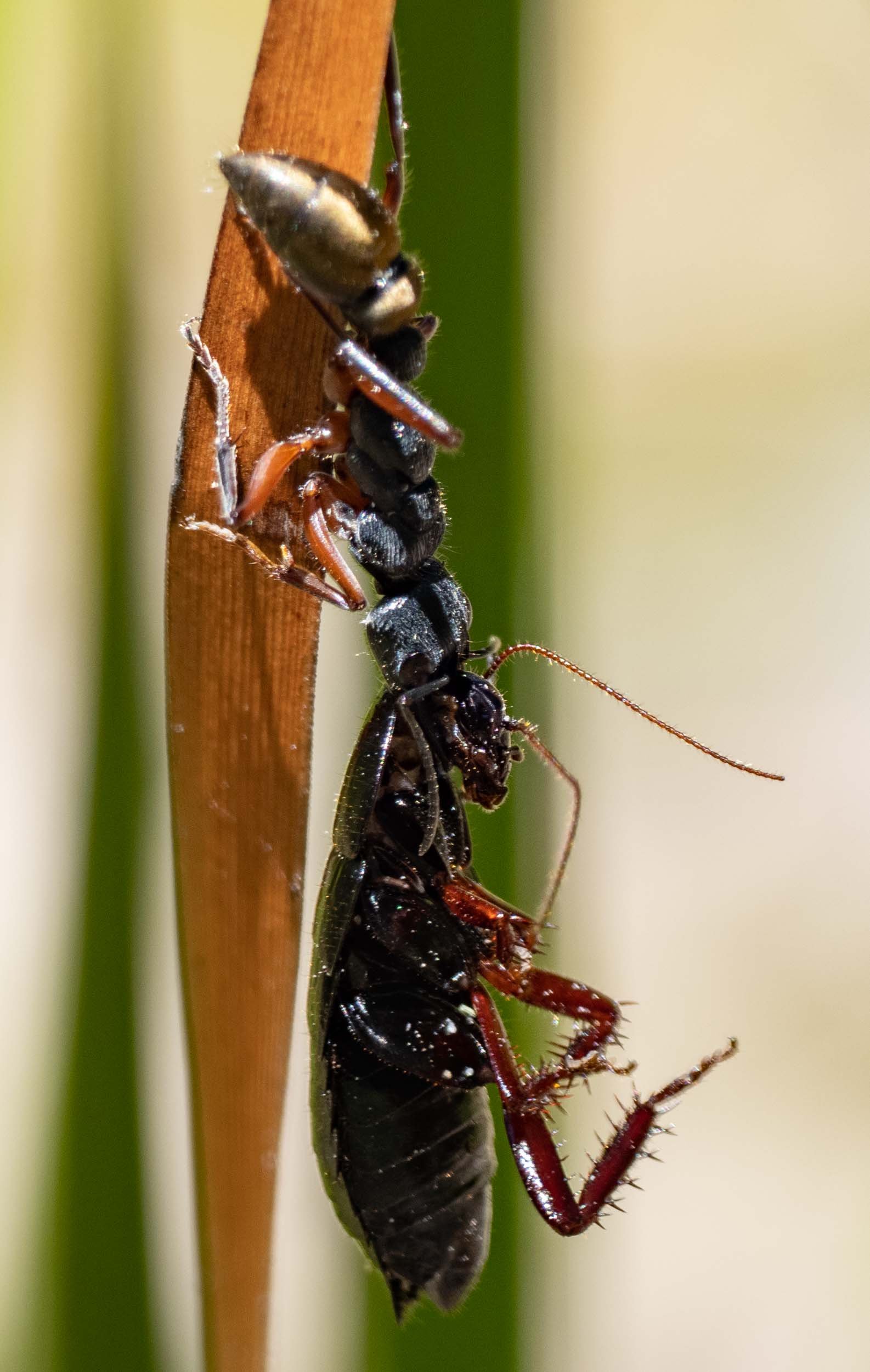
Tawny-legged Jack Jumper Ant
Myrmecia fulvipes
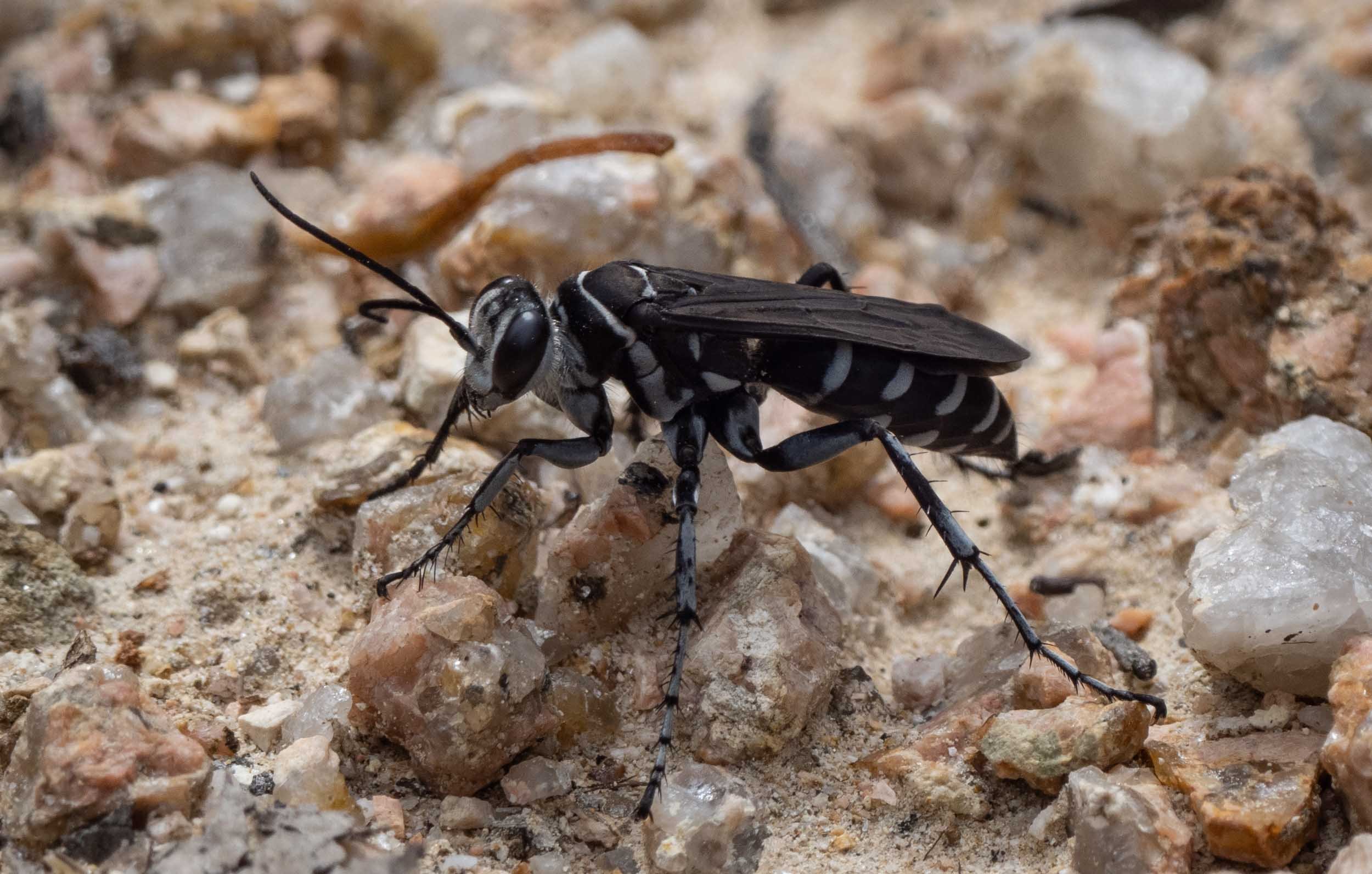
spider wasp
Turneromyia, perhaps. See Paul’s recent post for the full story (‘Delivering food for the future’)
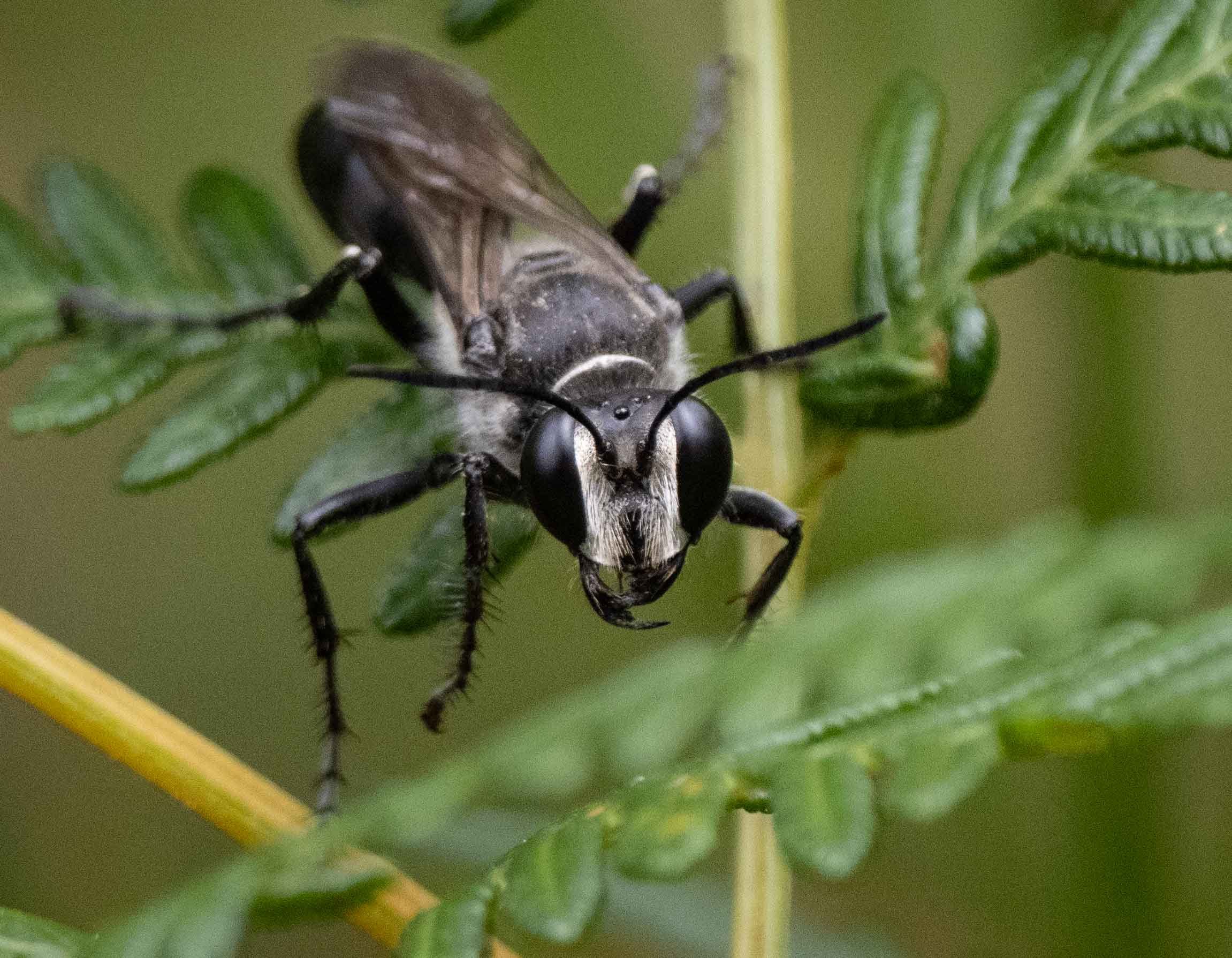
thread-waisted wasp
Sphex
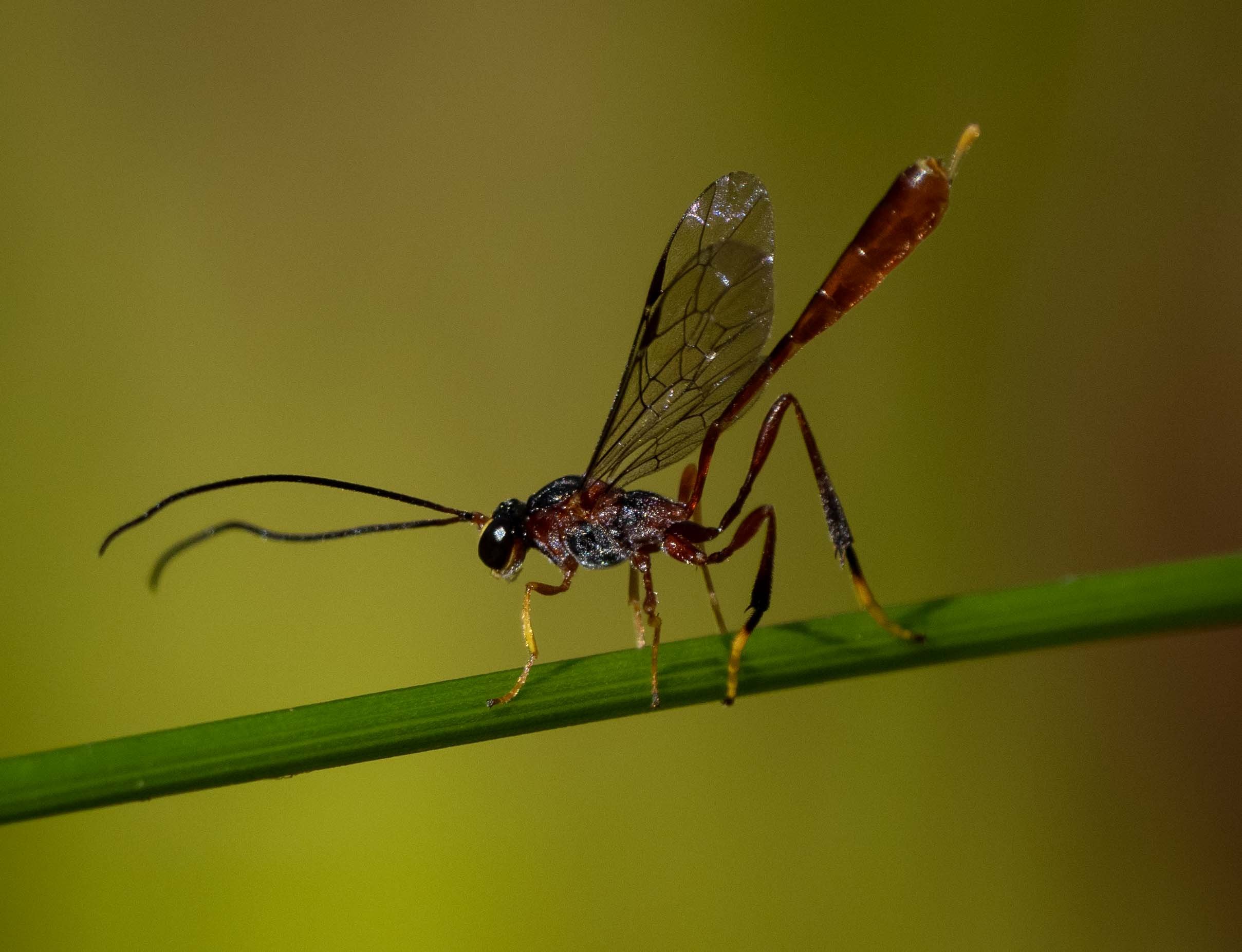
parasitic wasp
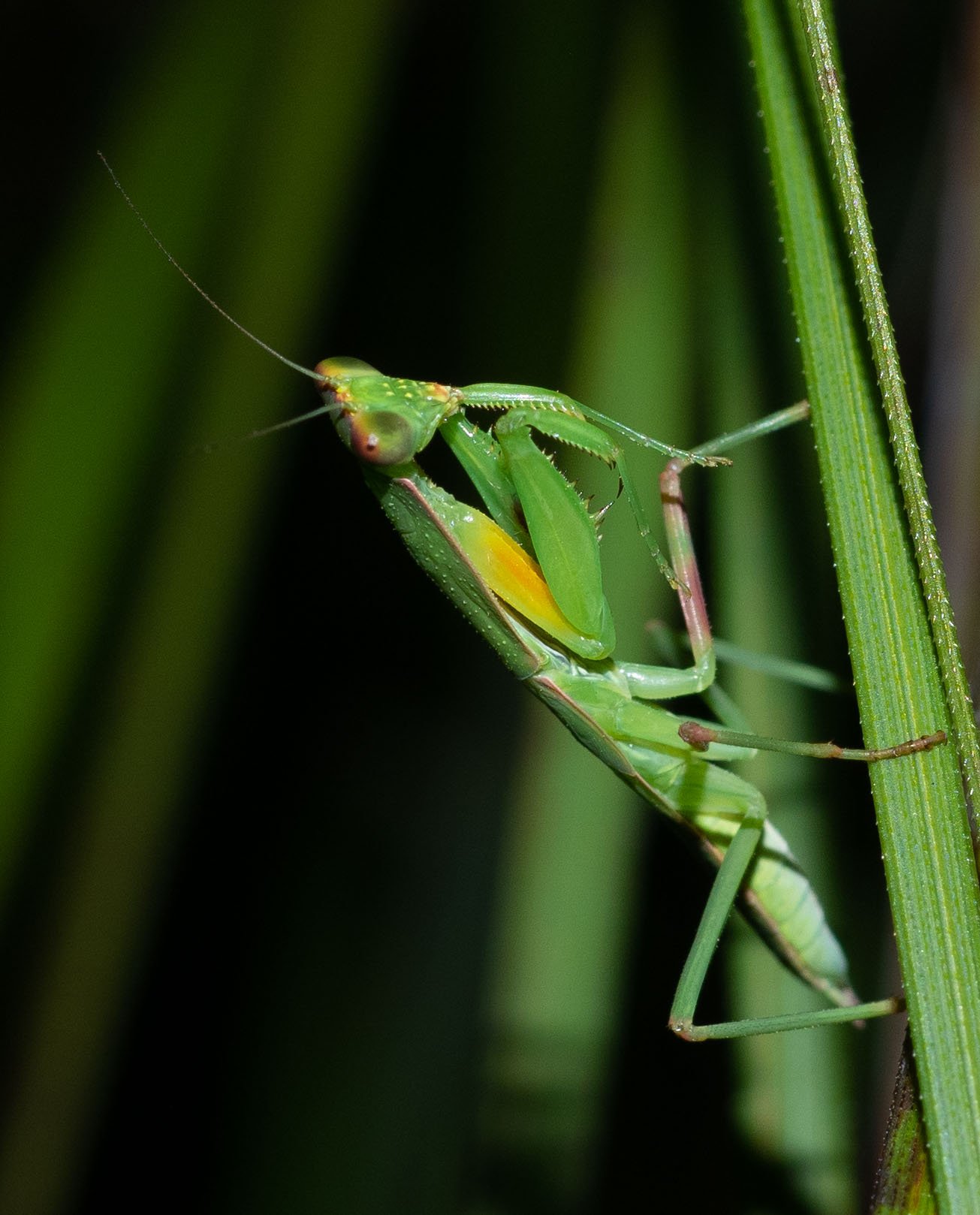
garden mantis
Orthodera ministralis

a rarely seen wasp
From a family we’ve never seen before! Although rarely collected, they can apparently be locally abundant after fire. The larvae are endoparasitoids of wood-borers such as longhorn beetle grubs.

large longhorn beetle
Cnemoplites australis
Attracted to a moth sheet by night.
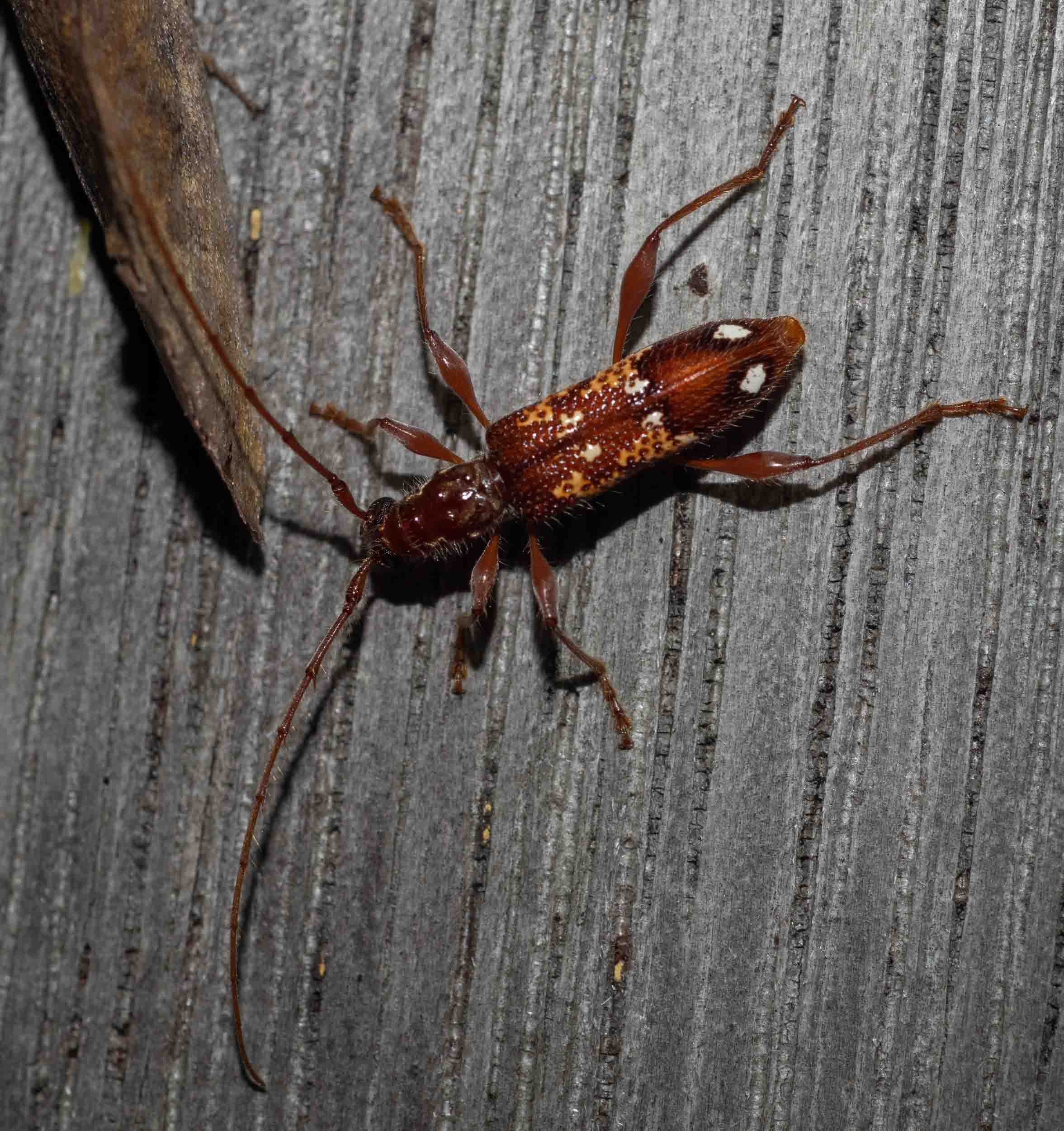
longhorn beetle
Coptocercus

an exciting find
Elimus australis
These are perhaps the first published, live photos of this species. We watched her hunting caterpillars in the same patch of forest for several days running. And we were lucky enough to see a male too!
(see iNaturalist entry for this species)
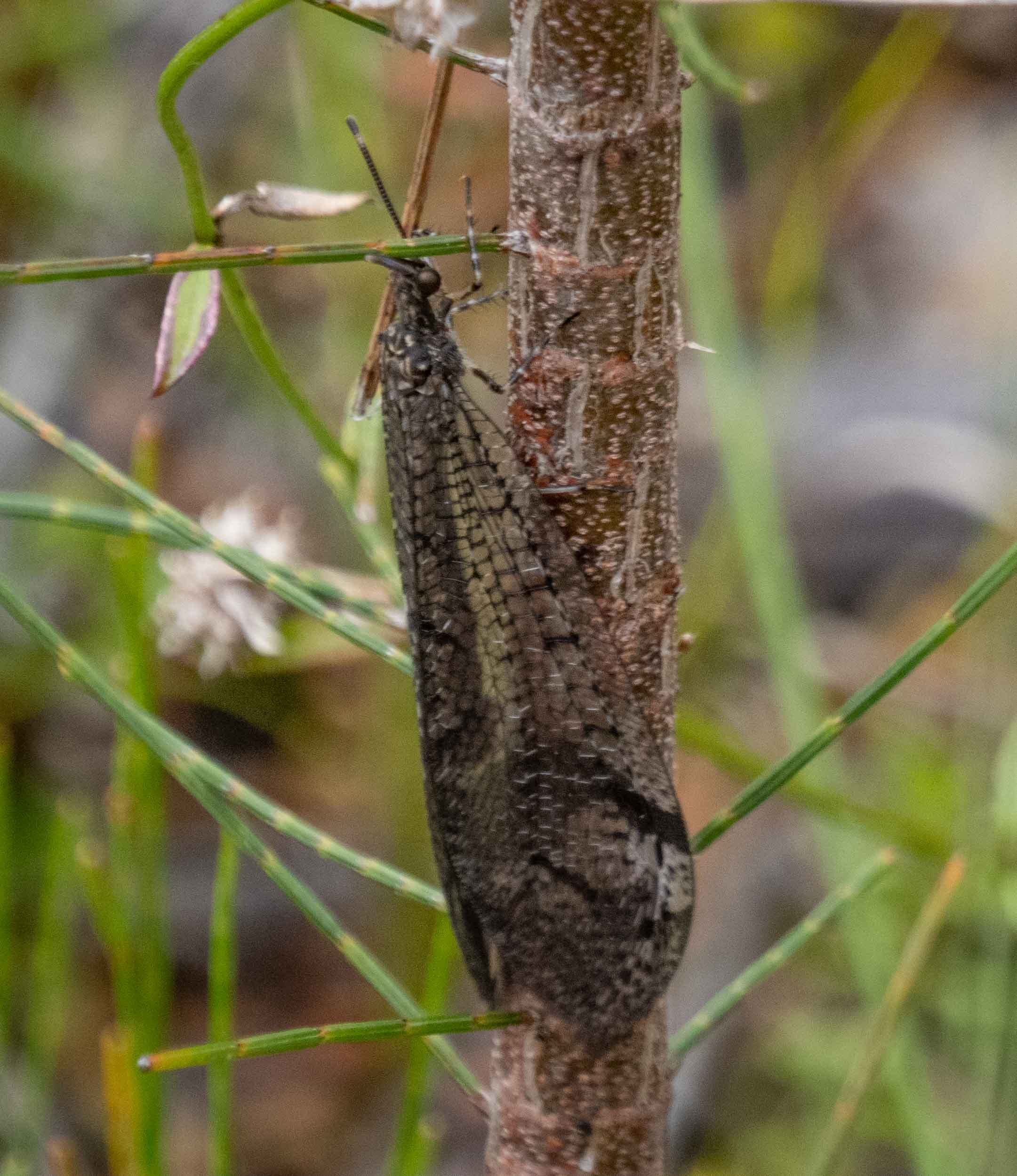
lacewing
Glenoleon

lacewing & others attracted to a light sheet
Myrmeleon acer (Common Brown Antlion)
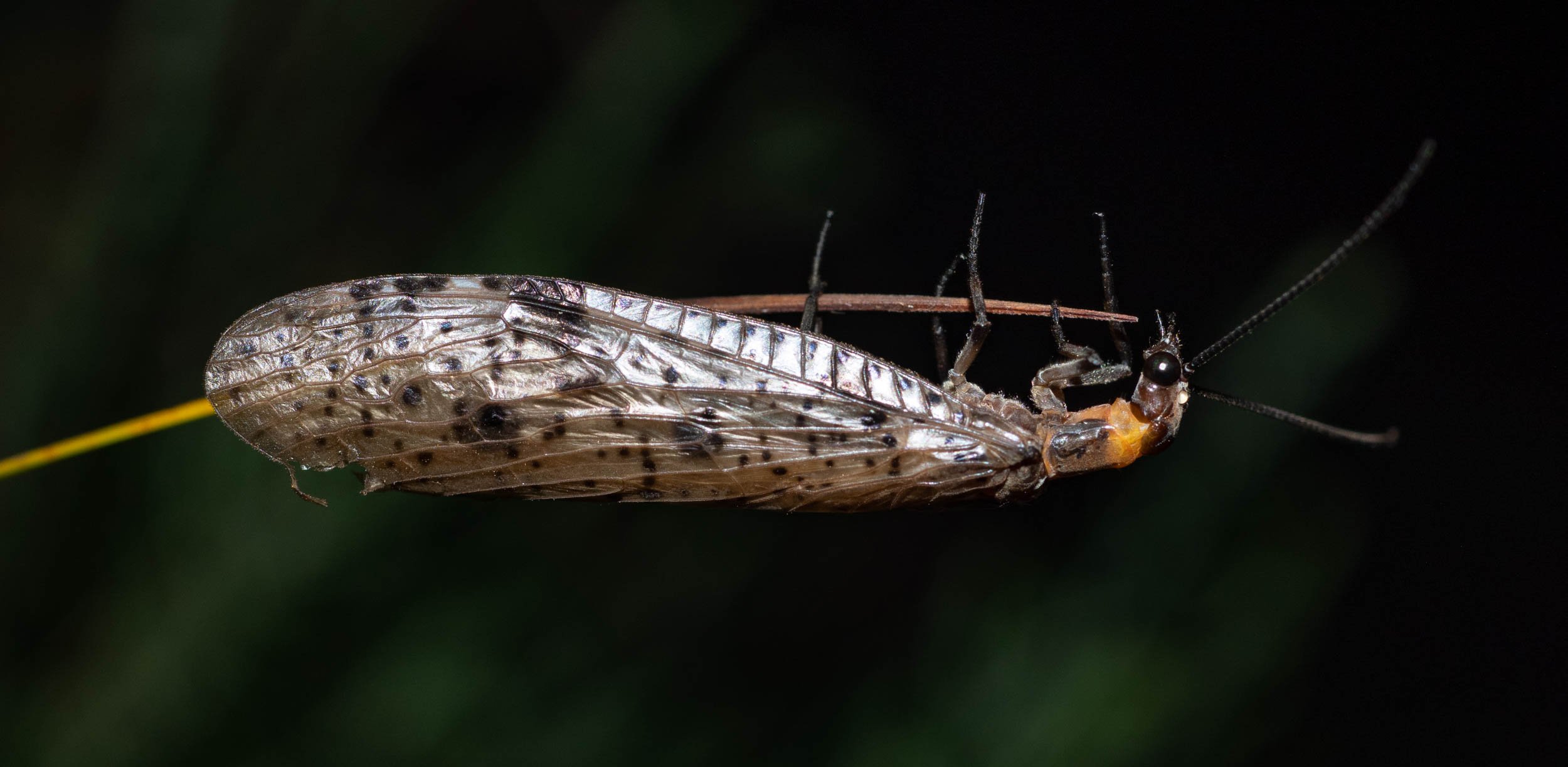
a 'fishfly'
Archichauliodes
At first glance we thought this was a lacewing, but they belong to an entirely different order … and one we’ve never recorded at home before! The larvae are aquatic carnivores.
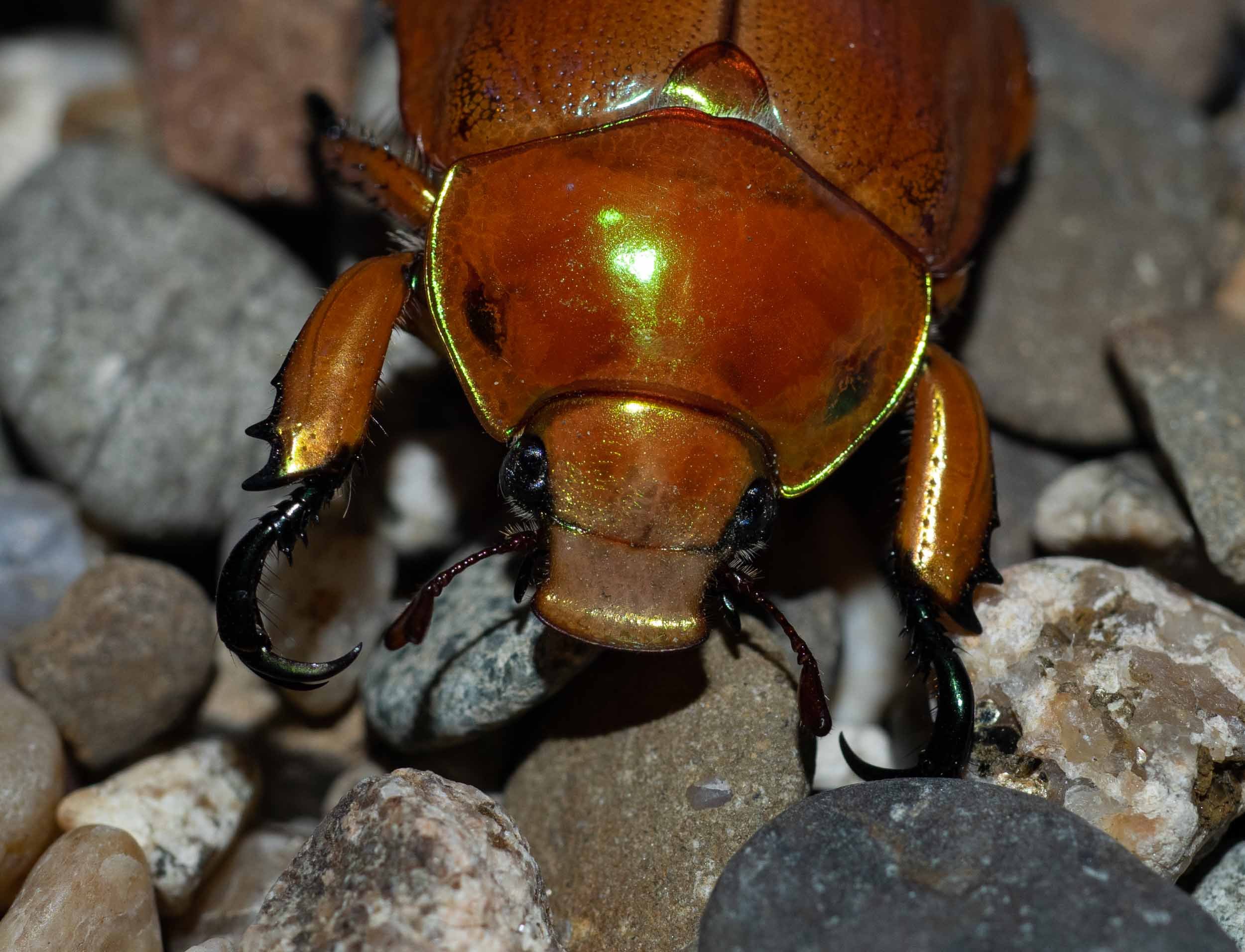
christmas beetle
Anoplognathus
Attracted to lights at night.
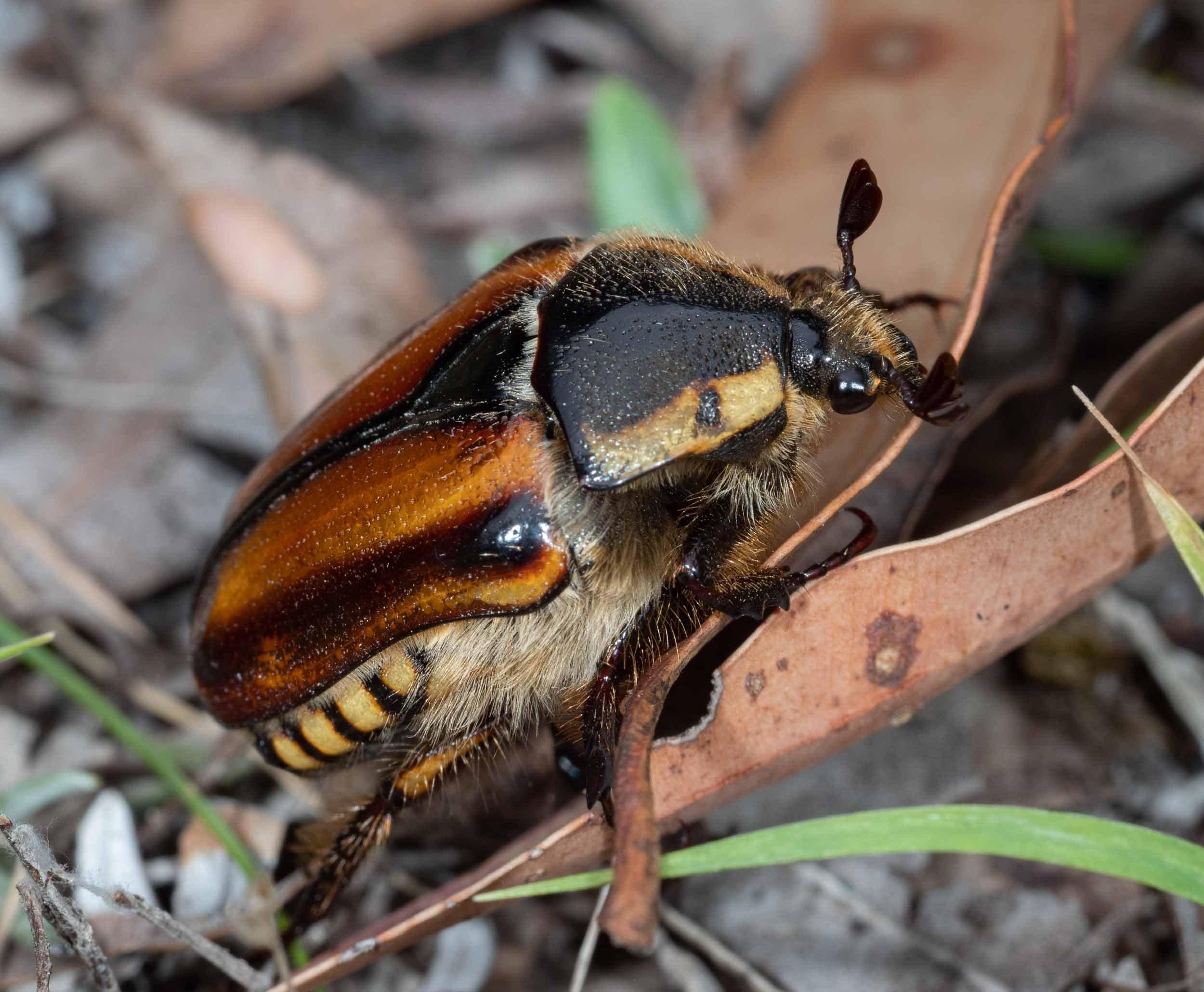
flower chafer
Chondropyga gulosa
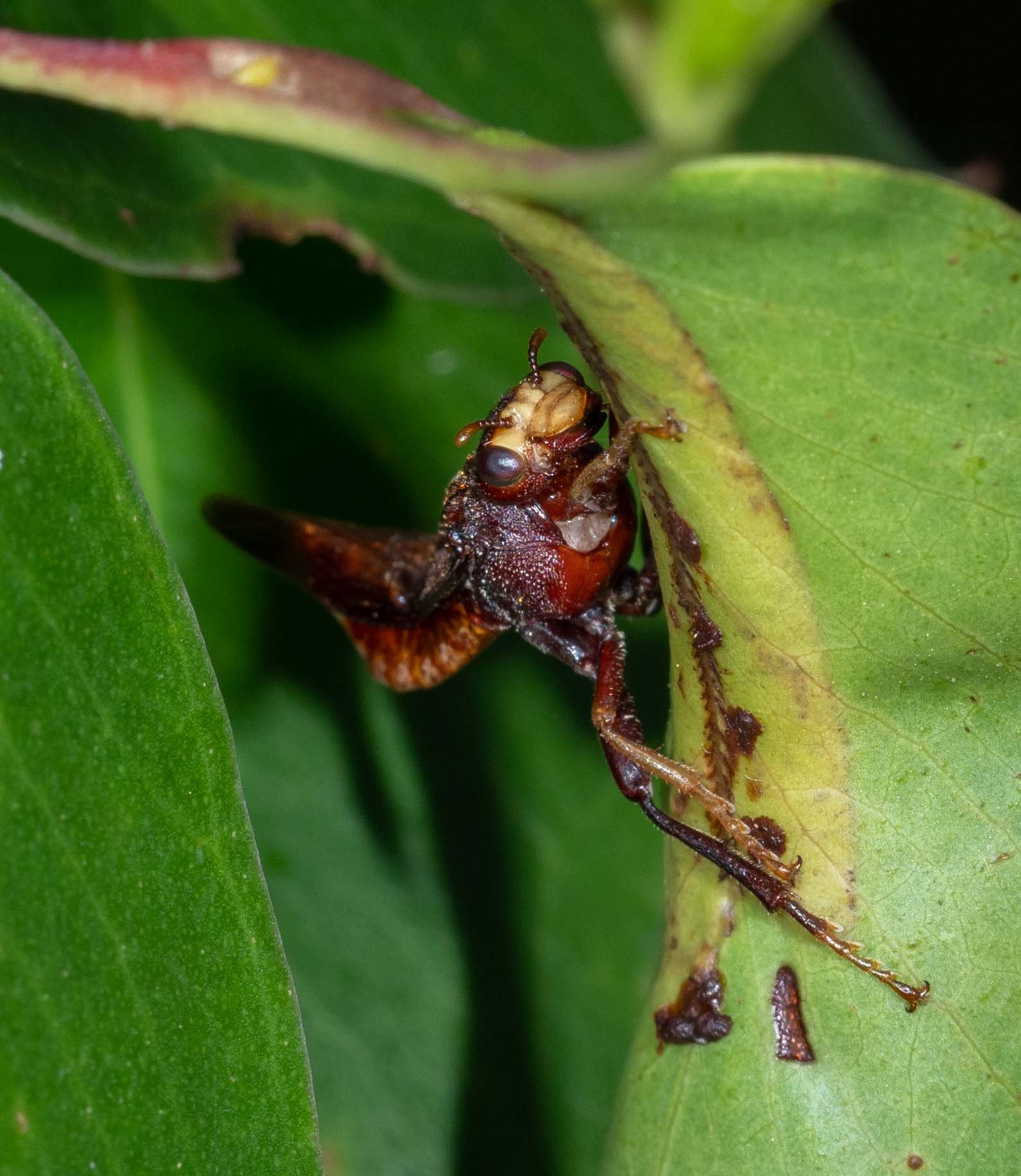
sawfly
Pseudoperga ferruginea
For this mother’s full story, see ‘Sawfly galleries’

Whistling Moth
Hecatesia fenestrata
We came across this moth on a late night ramble through the forest. Males, like this one, have a ribbed patch near the costa of the forewing, which lacks scales. They rub this against a small protrusion to make their eponymous sound - presumably to attract females. The caterpillars feeds on Devil’s Twine, Cassytha.
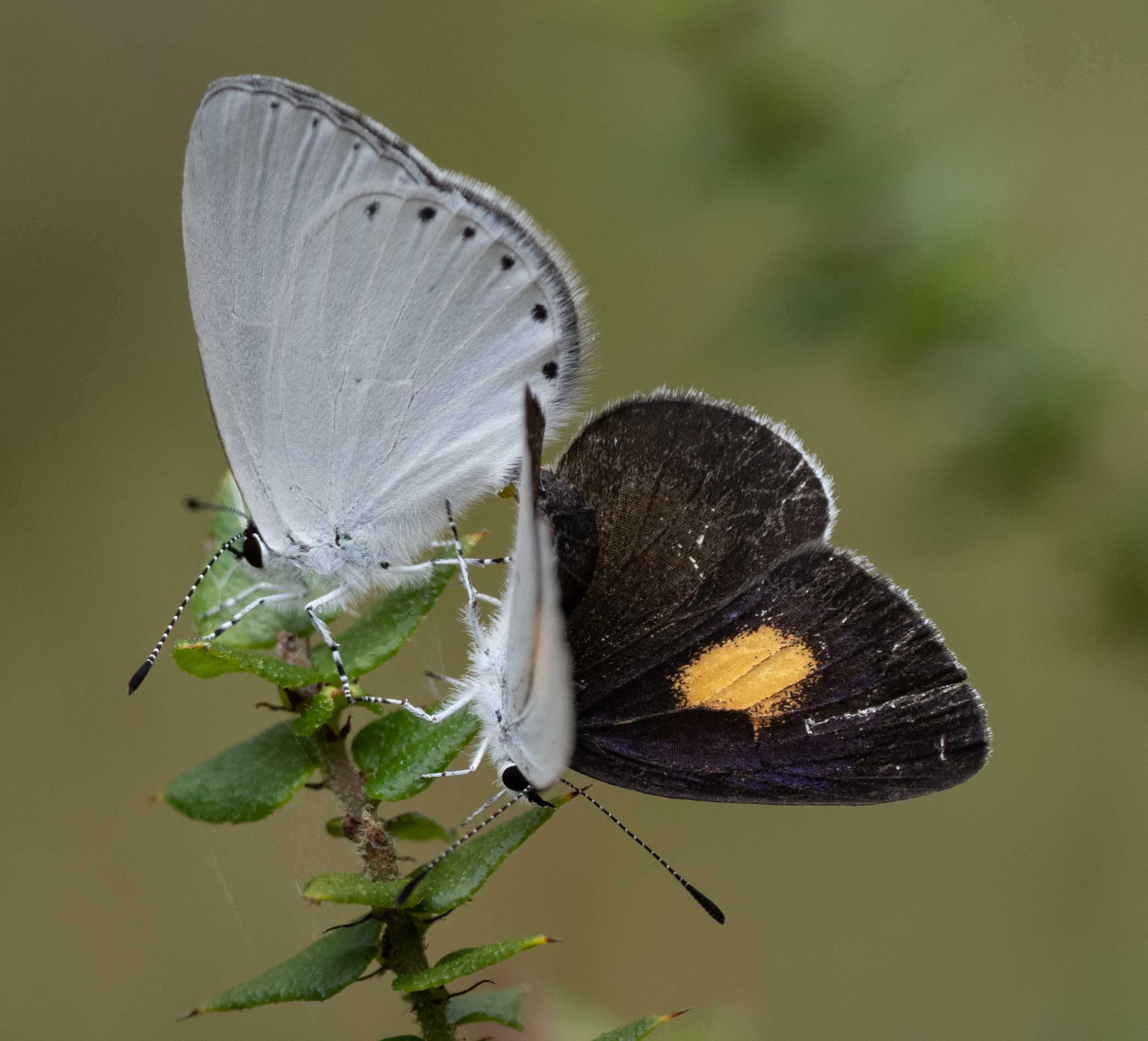
Yellow-spotted Blue
Candalides xanthospilos
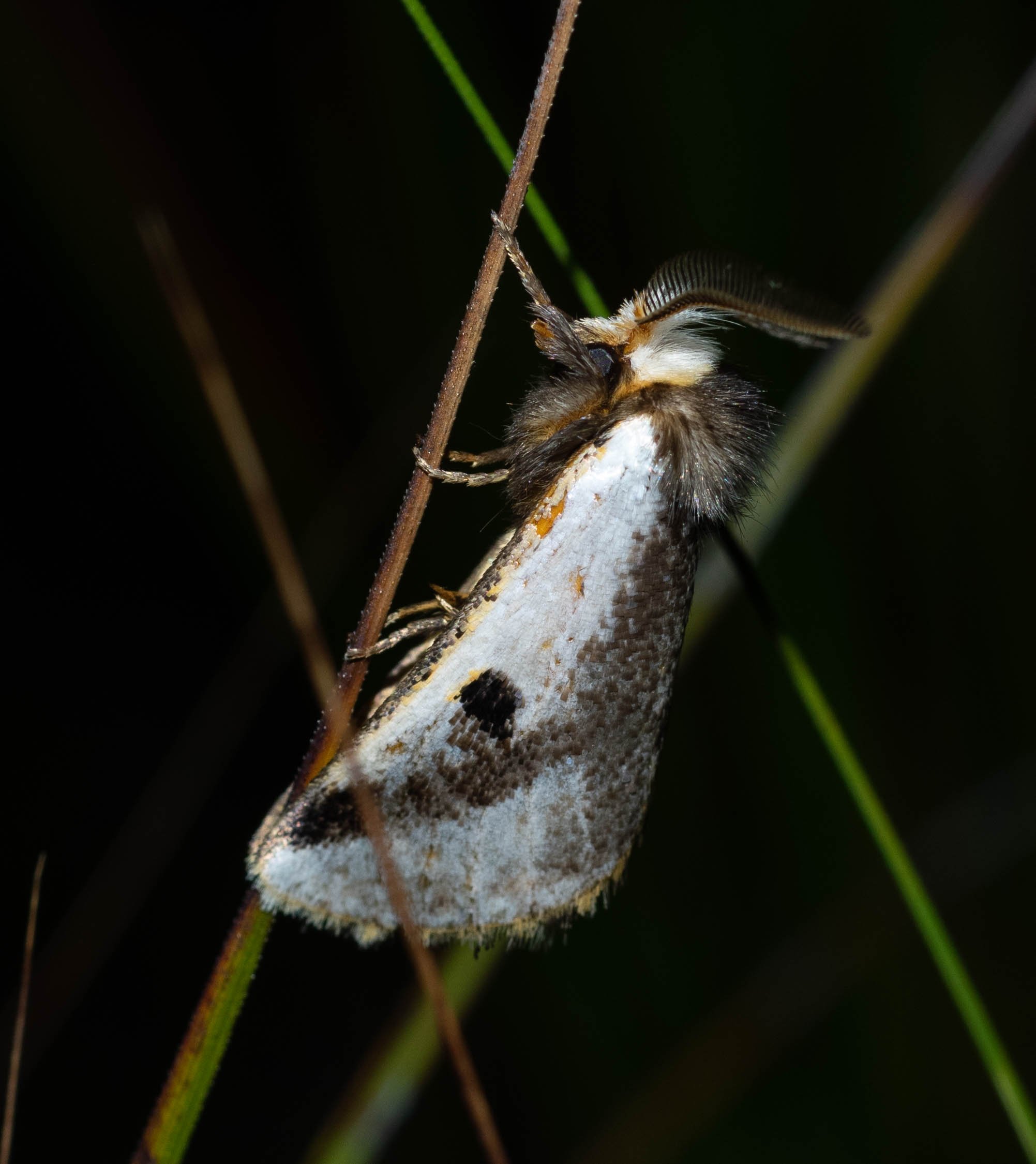
Black Spot Moth
Epicoma melanospila
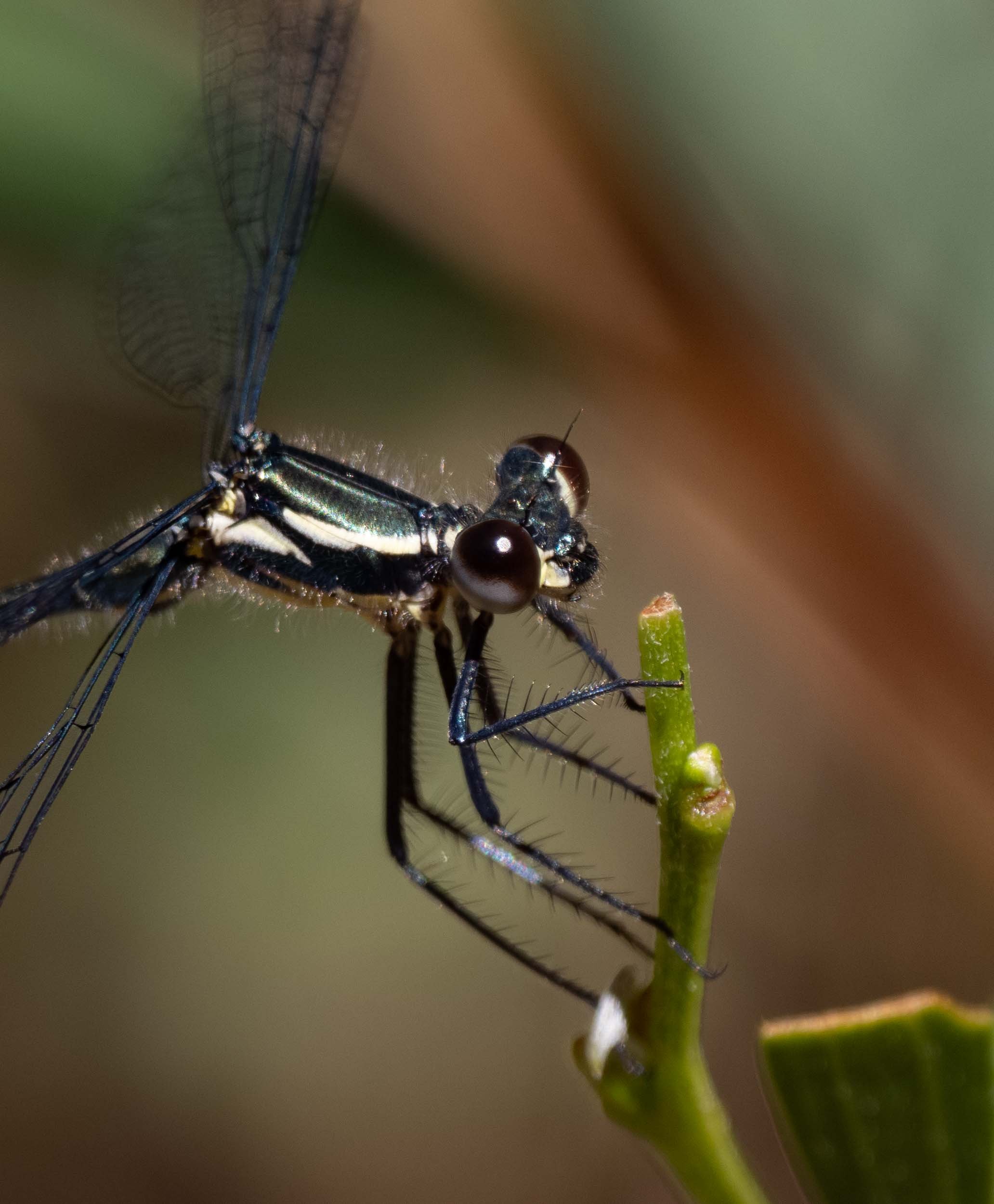
Common Flatwing
Austroargiolestes icteromelas
By far our most common damselfly.

Splendid Ochre
Trapezites symmomus
The largest skipper we see, and arguably the most attractive.

another Splendid Ochre
Trapezites symmomus
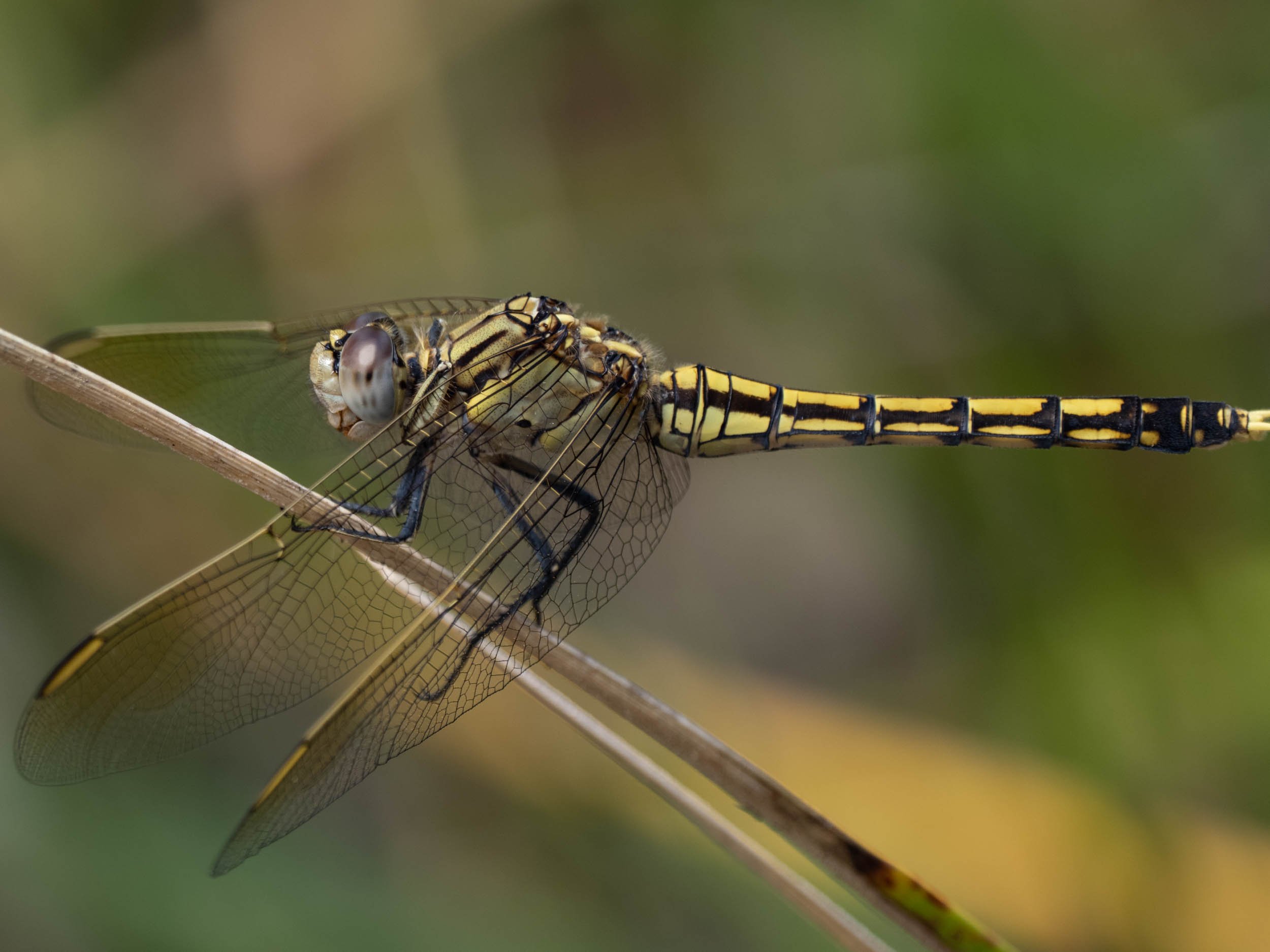
Blue Skimmer
Orthetrum caledonicum
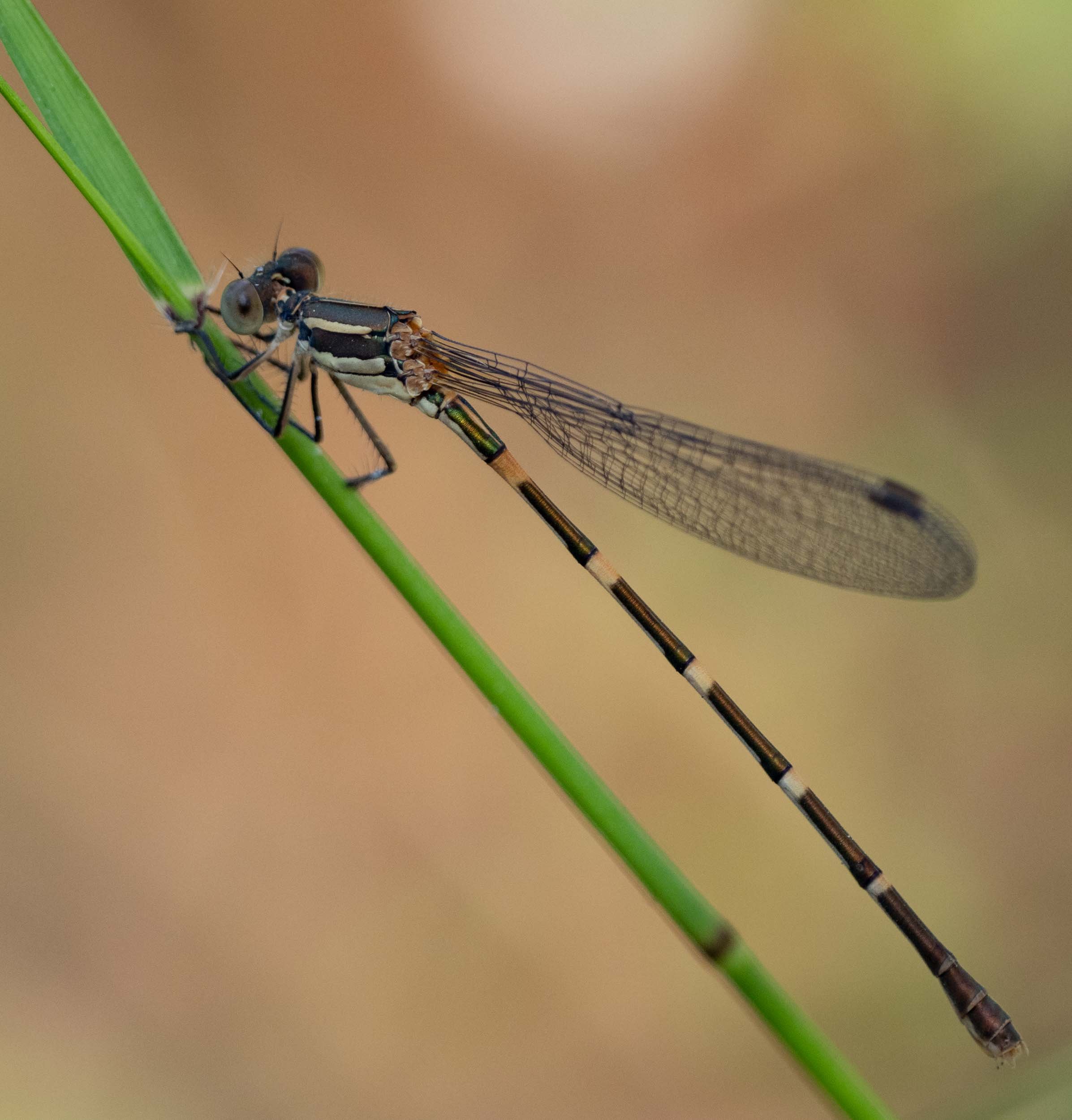
Wandering Ringtail
Austrolestes leda

Australian Emerald
Hemicordulia australiae
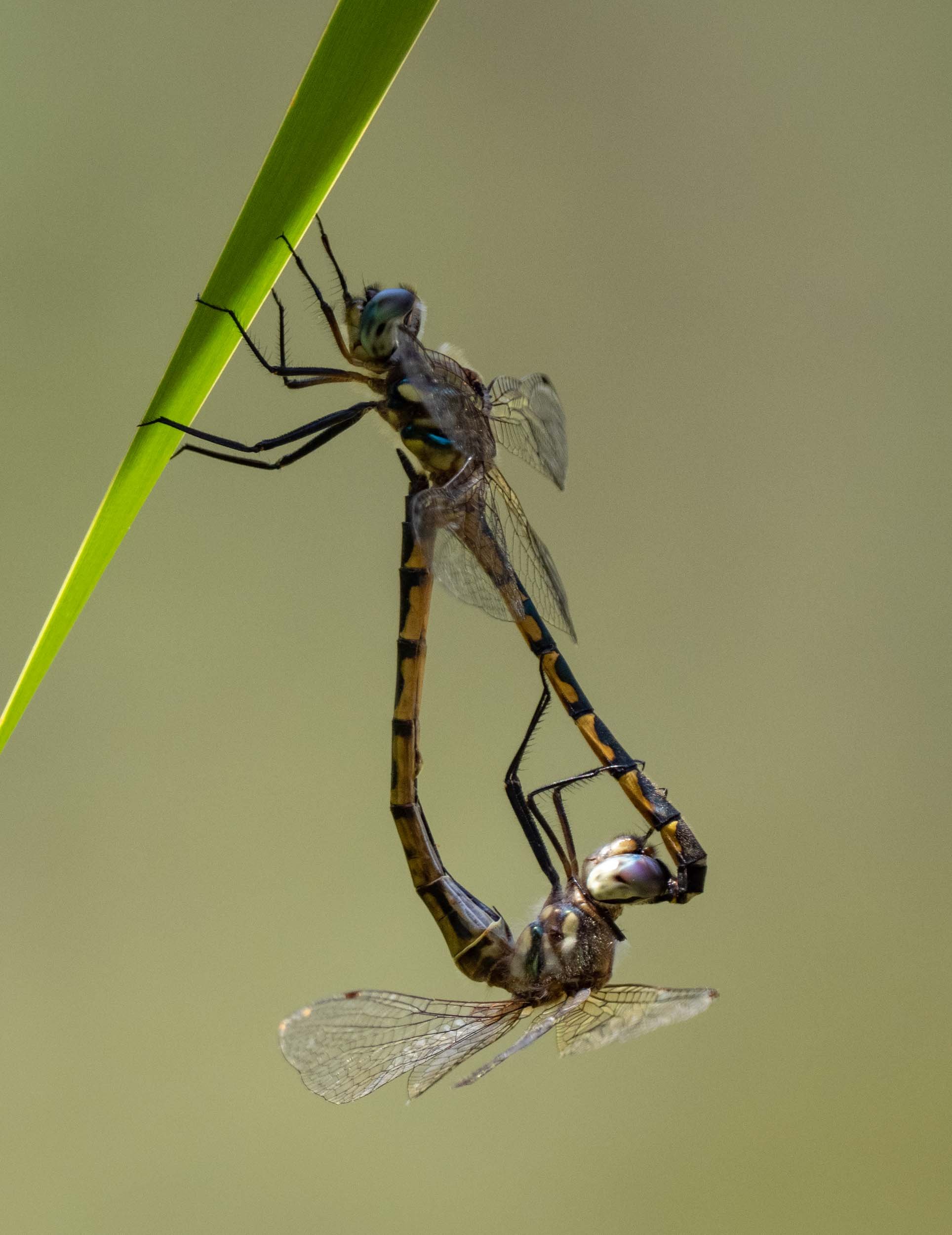
Australian Emerald
Hemicordulia australiae
The classic ‘wheel’ mating position.
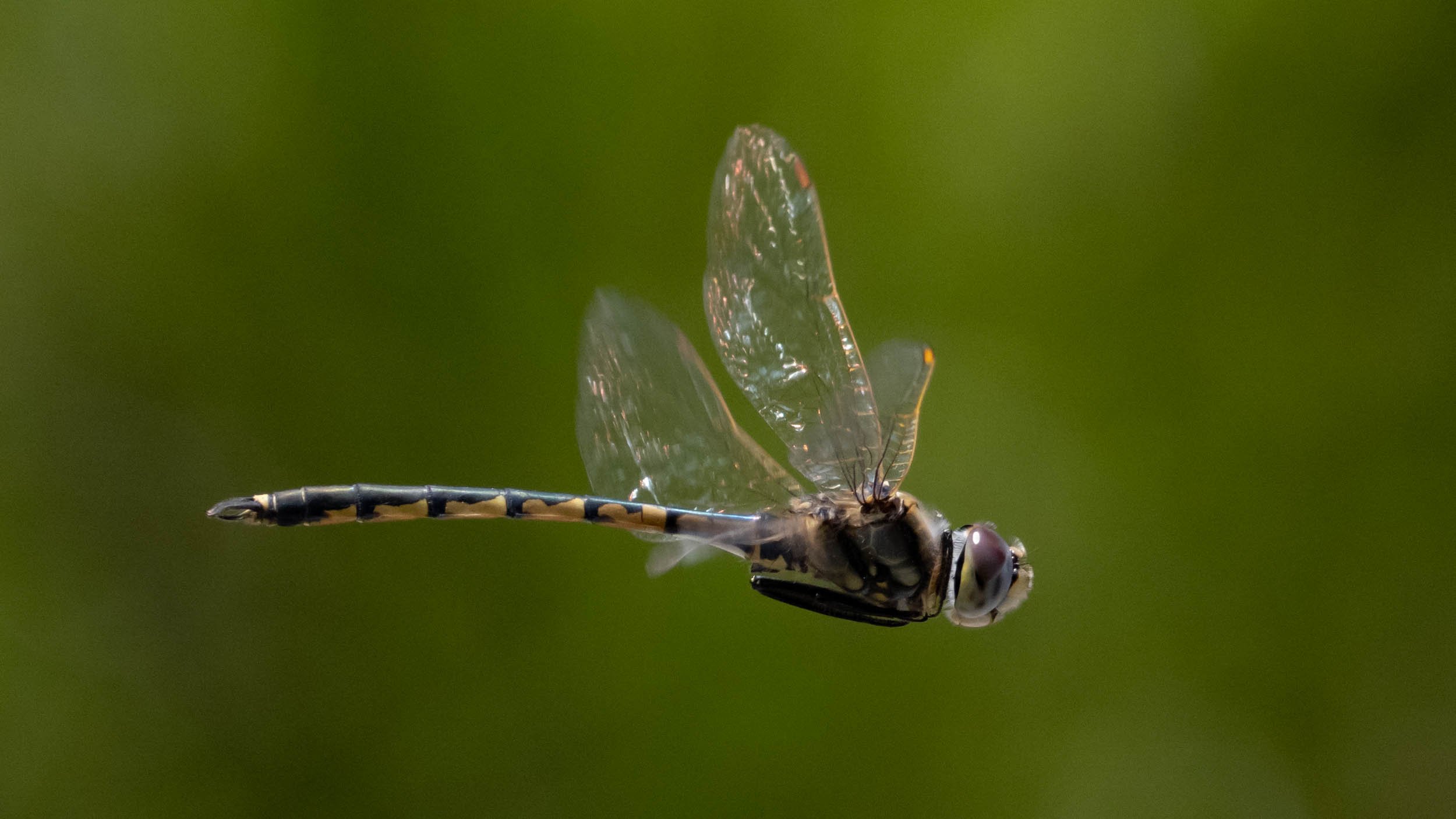
Tau Emerald
Hemicordulia tau
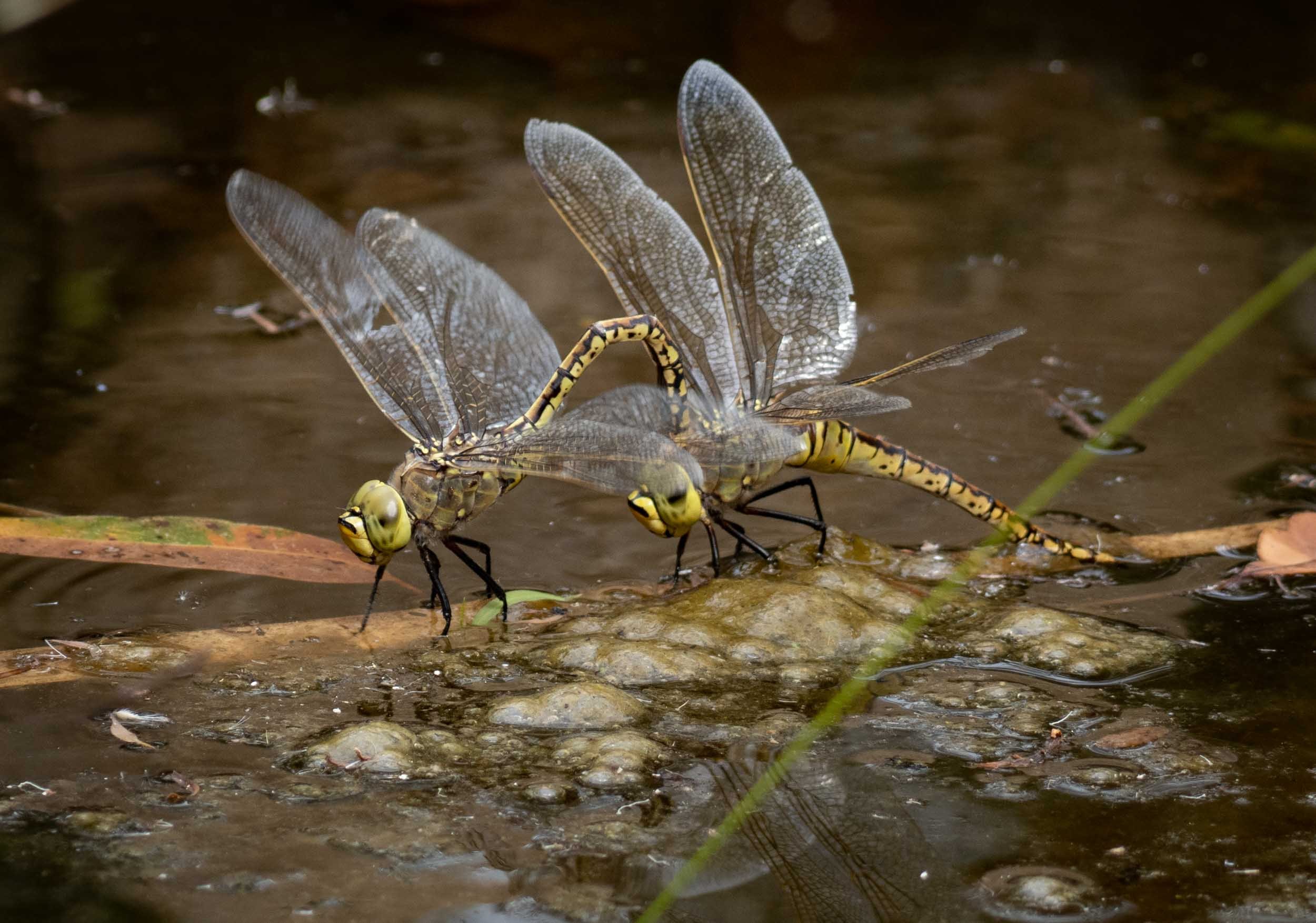
Australian Emperor
Anax papuensis
The female is inserting her eggs into floating vegetation, all the while gripped by the supporting (and possessive) male.

Black-faced Percher
Diplacodes melanopsis
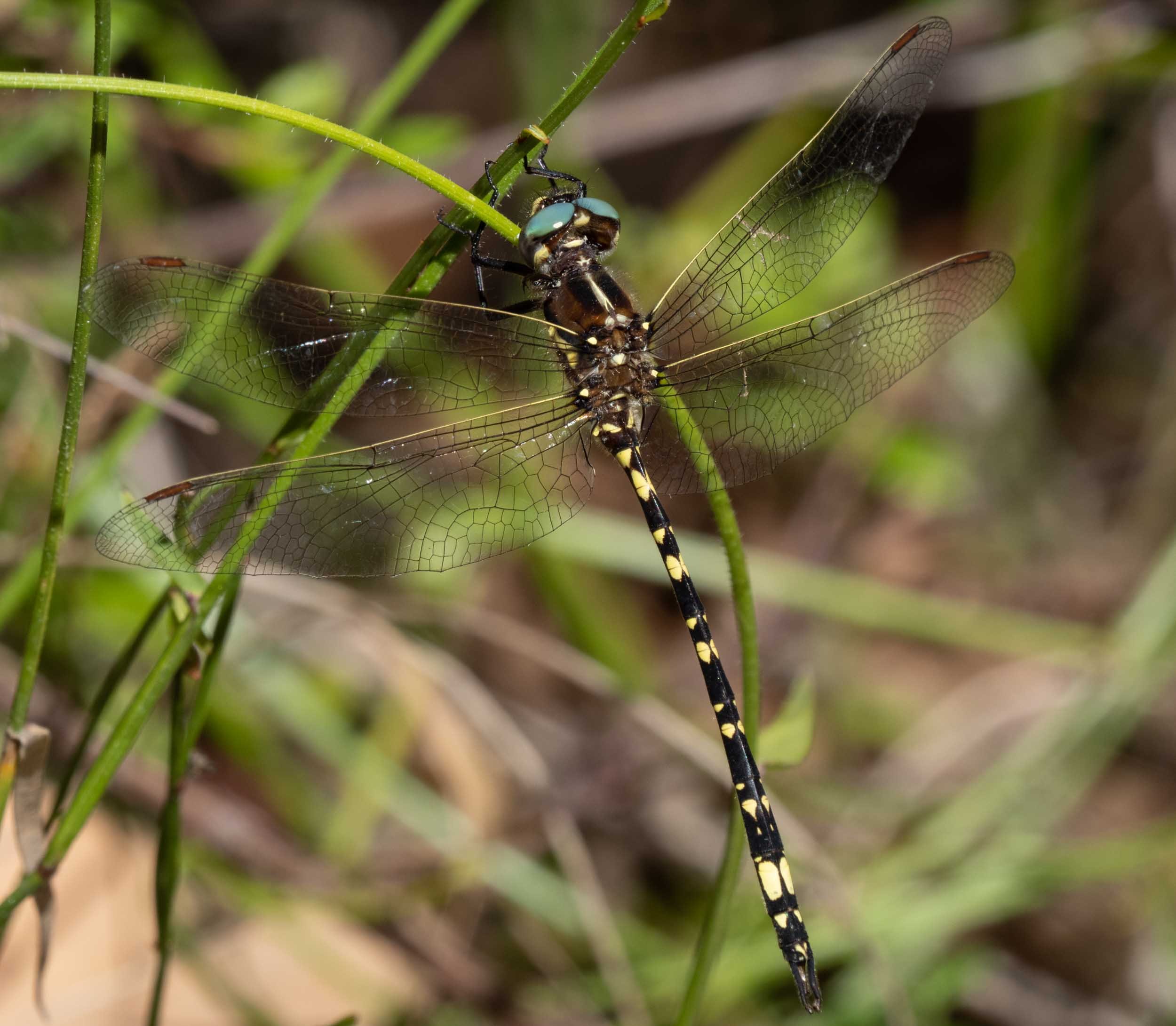
Swamp Tigertail
Synthemis eustalacta
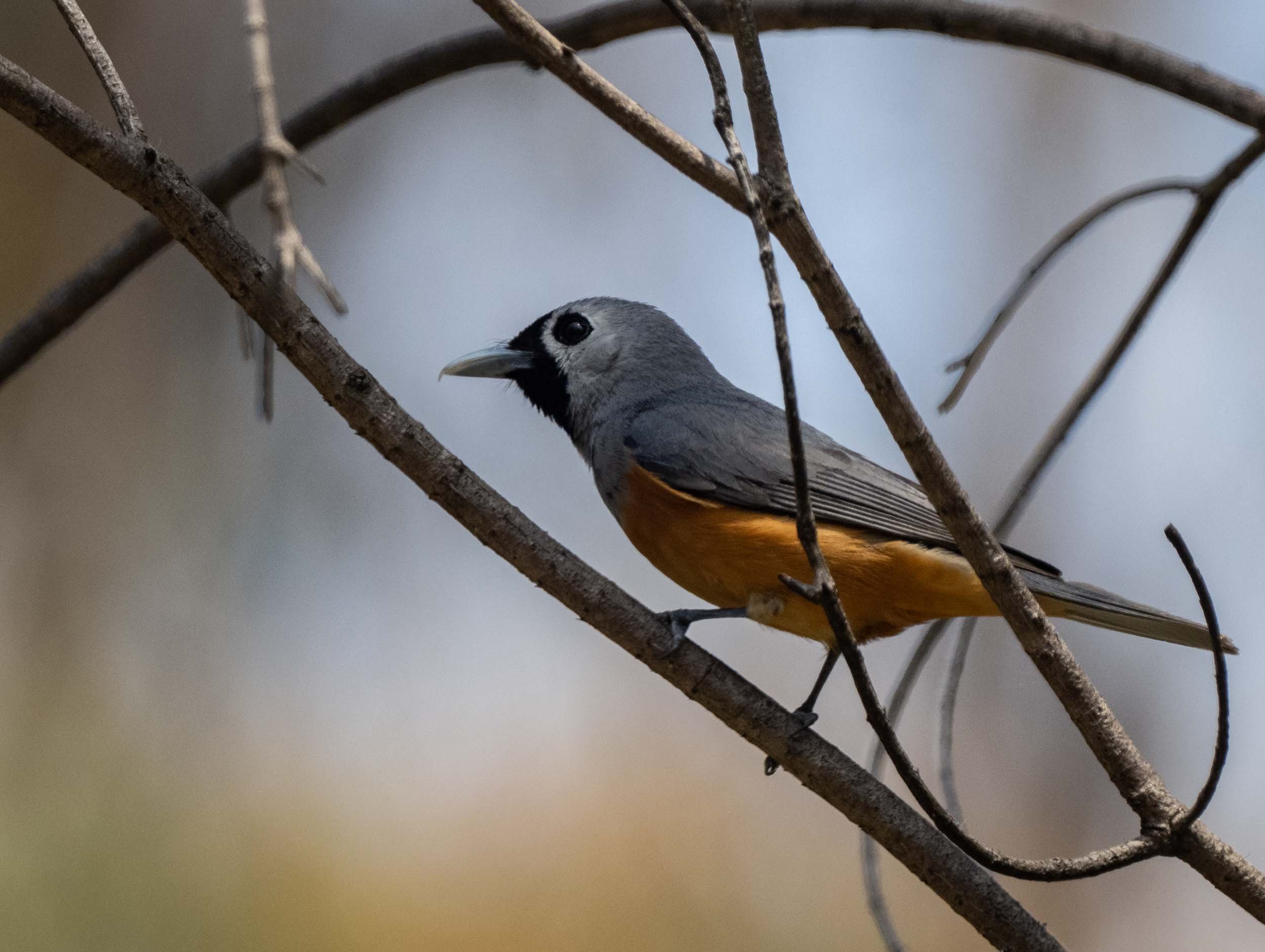
Black-faced Monarch
Monarcha melanopsis

Leaden Flycatcher
Myiagra rubecola
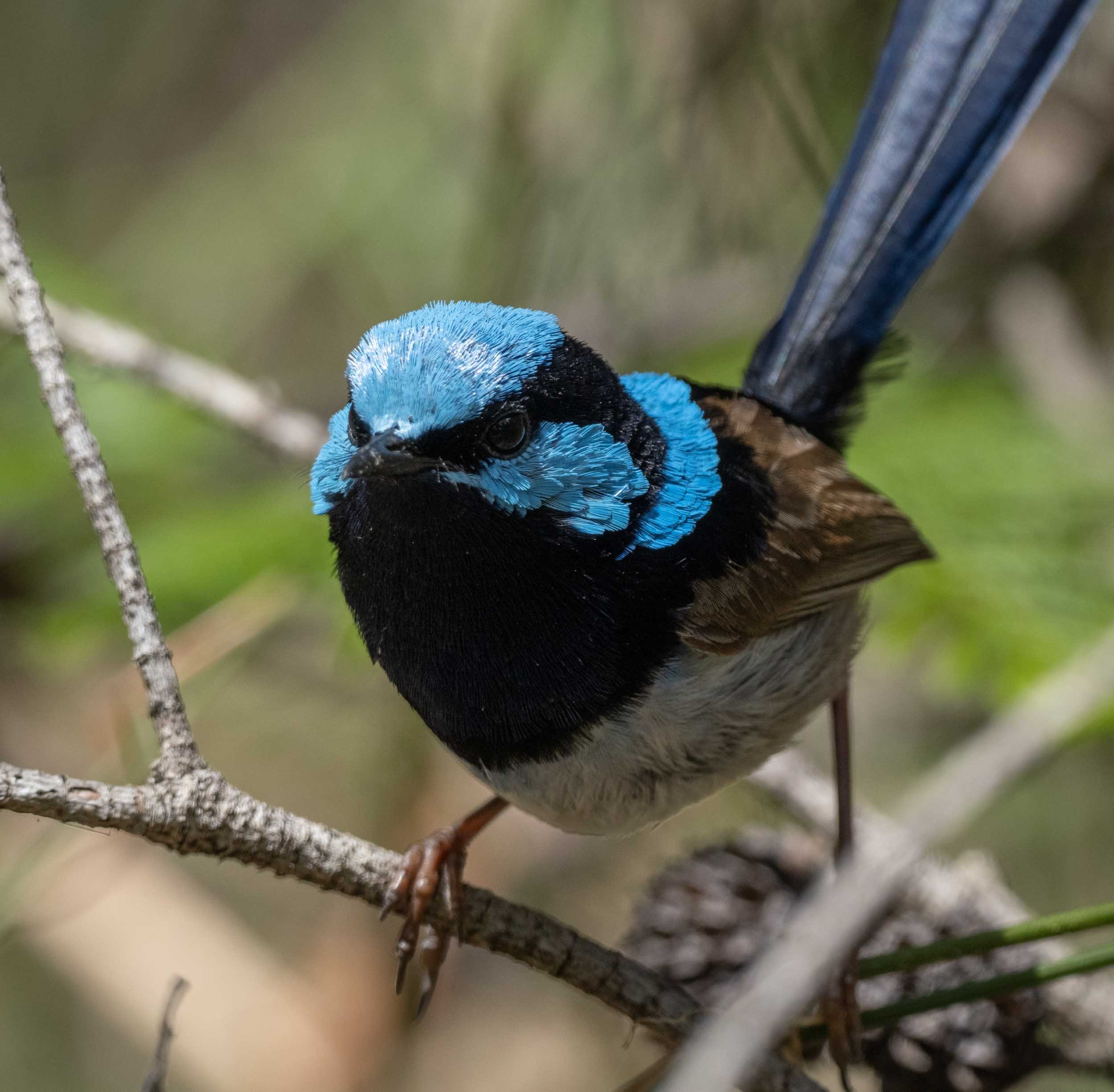
Superb Fairywren
Malurus cyaneus

White-winged Chough
Corcorax melanorhamphos
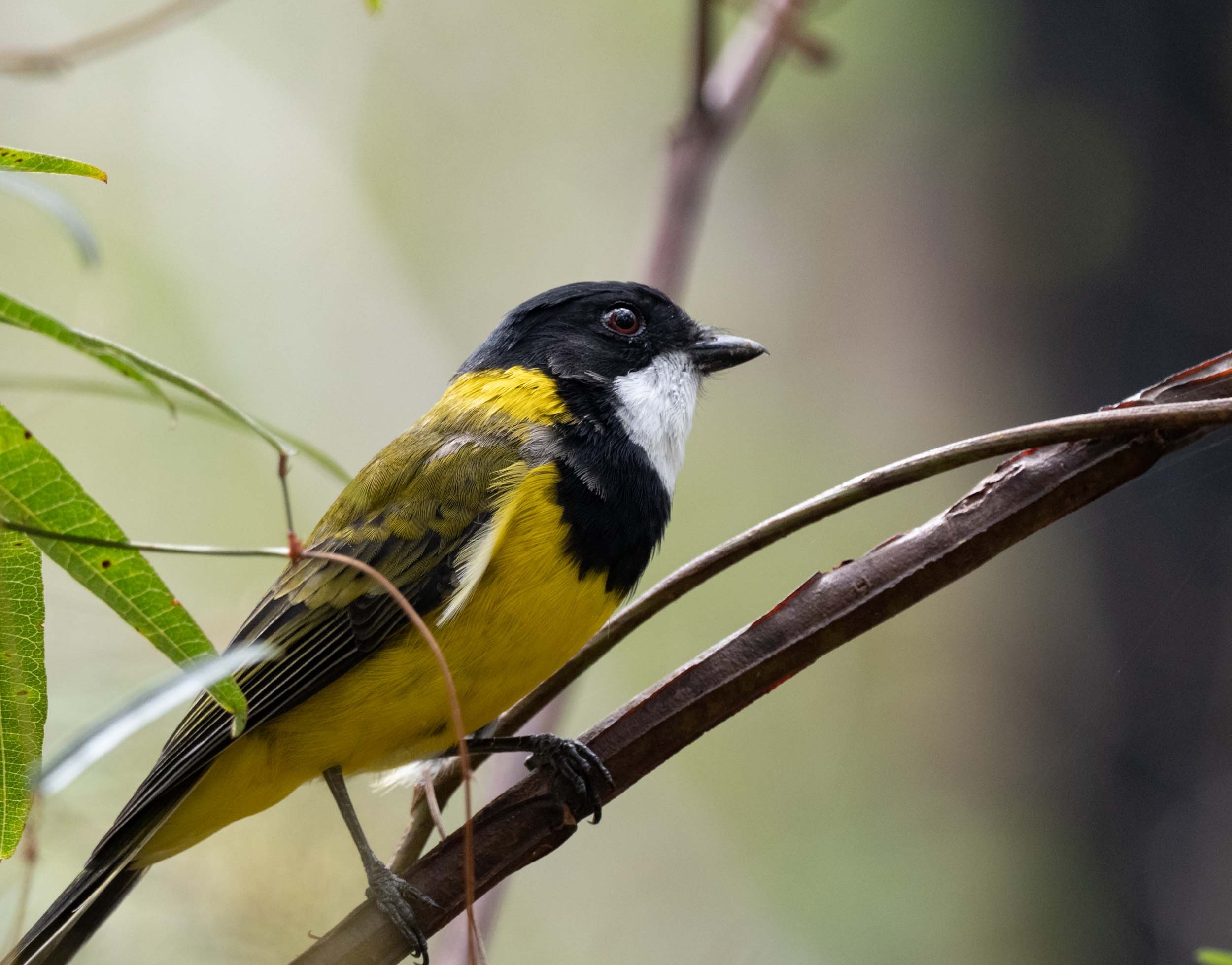
Golden Whistler
Pachycephala pectoralis

Leaden Flycatcher
Myiagra rubecola
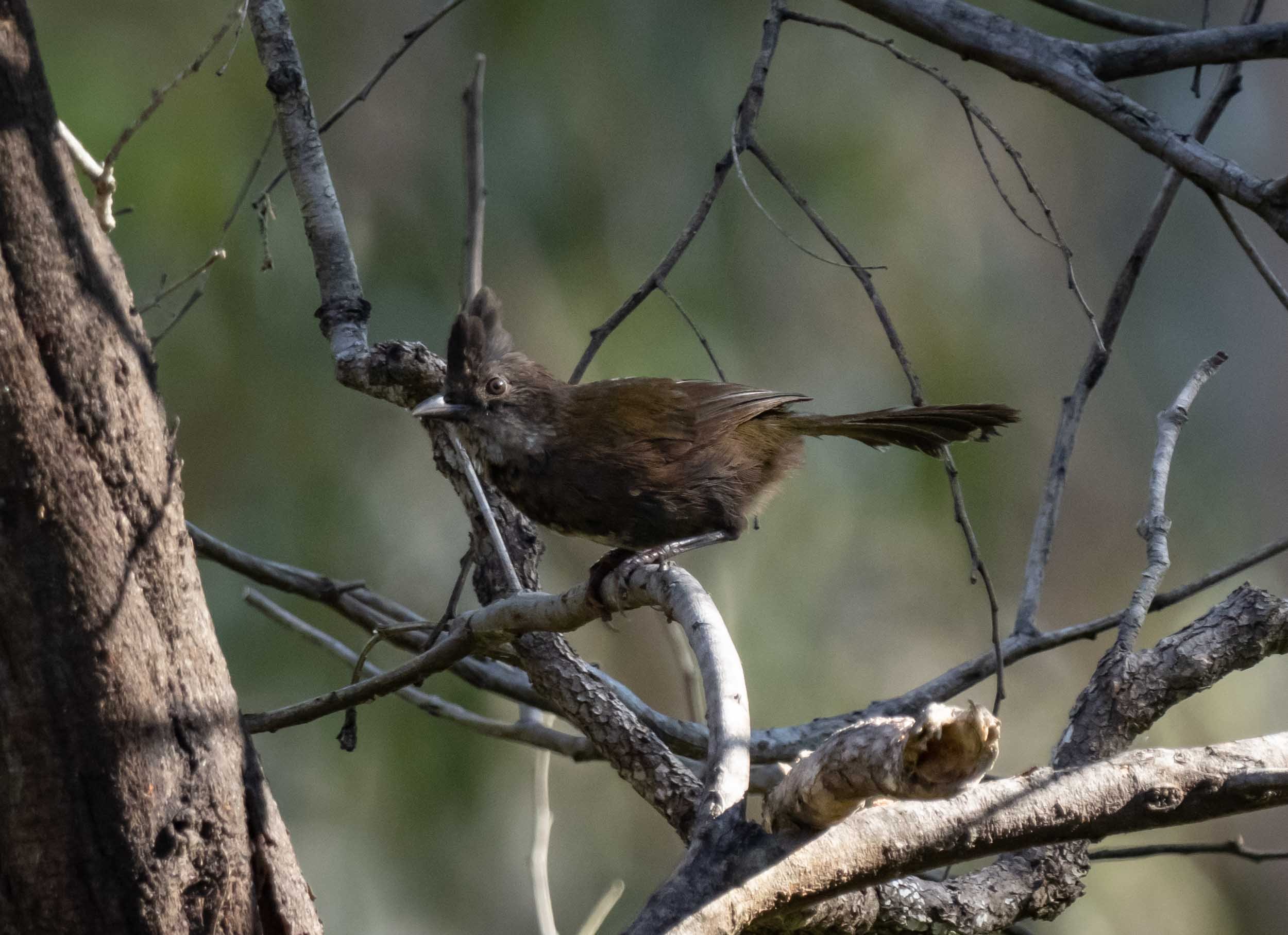
Eastern Whipbird
Phosphodes olivaceus
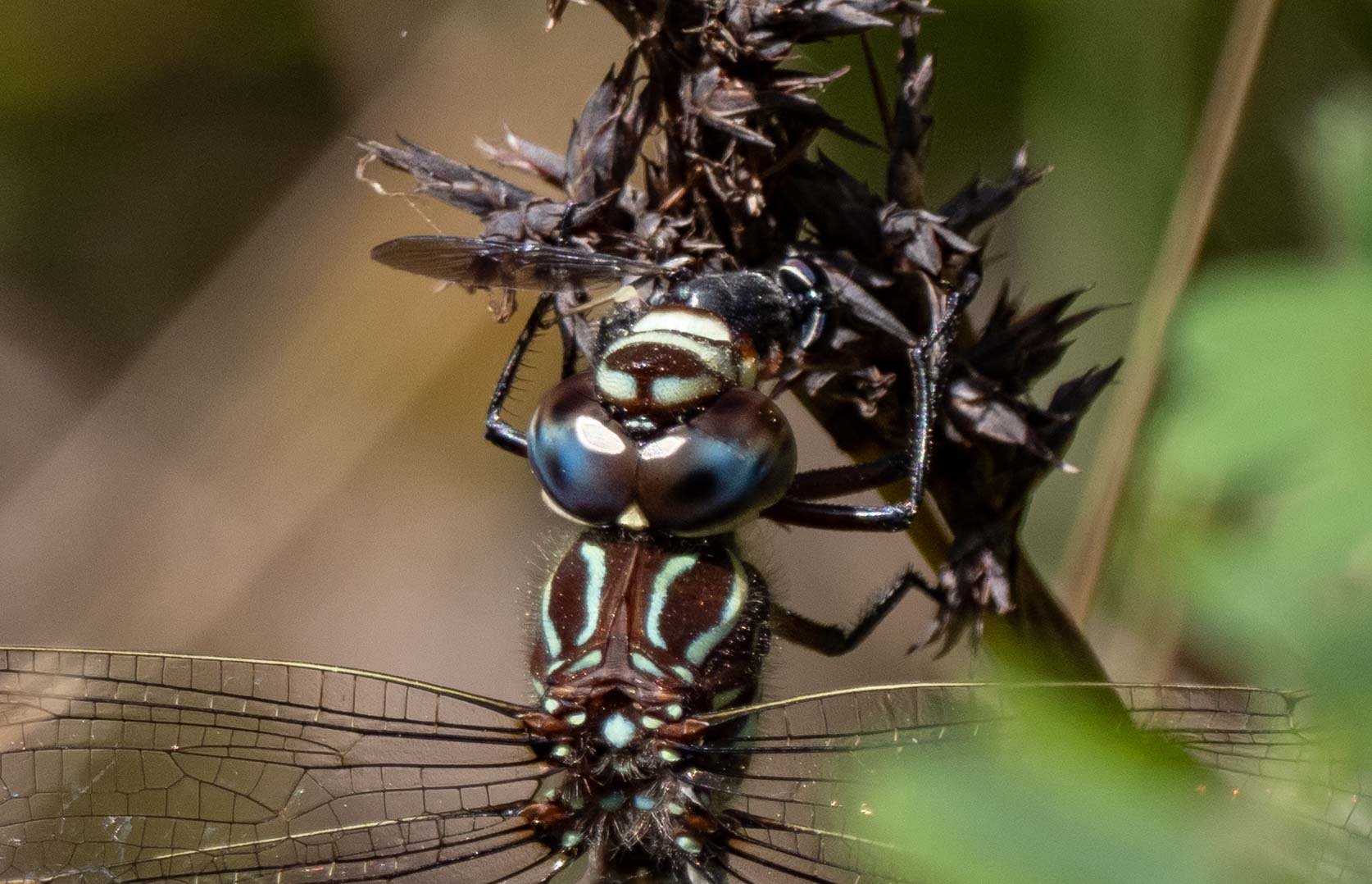
Blue-spotted Hawker
Adversaeschna brevistyla
Chewing on a freshly-caught fly … which looks rather like a march fly. There’s a reason dragonflies seem to follow me as I move about the forest. I’m attracting a smorgasbord of lunch snacks!

Yellow-bellied Water Skink
Eulamprus heatwolei
Nice to see it living up to its name, swimming across the frog pond.

Black Rock Skink
Egernia saxatilis
… surrounded by a cloud of small flies.
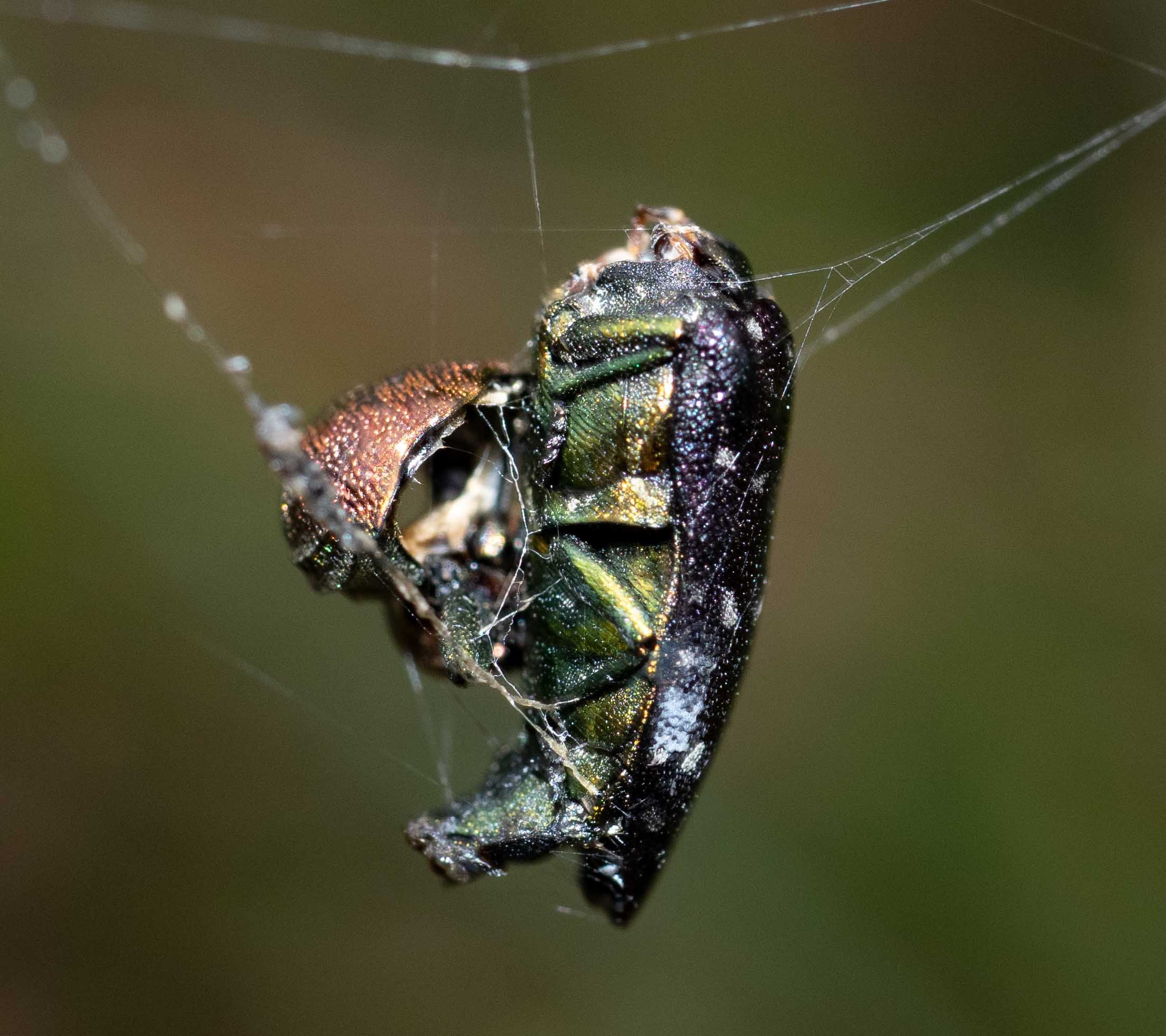
spider lunch remains
In the web of a leaf-curling spider hang the remains of a recent meal – a once-glorious jewel beetle, now just a shell.
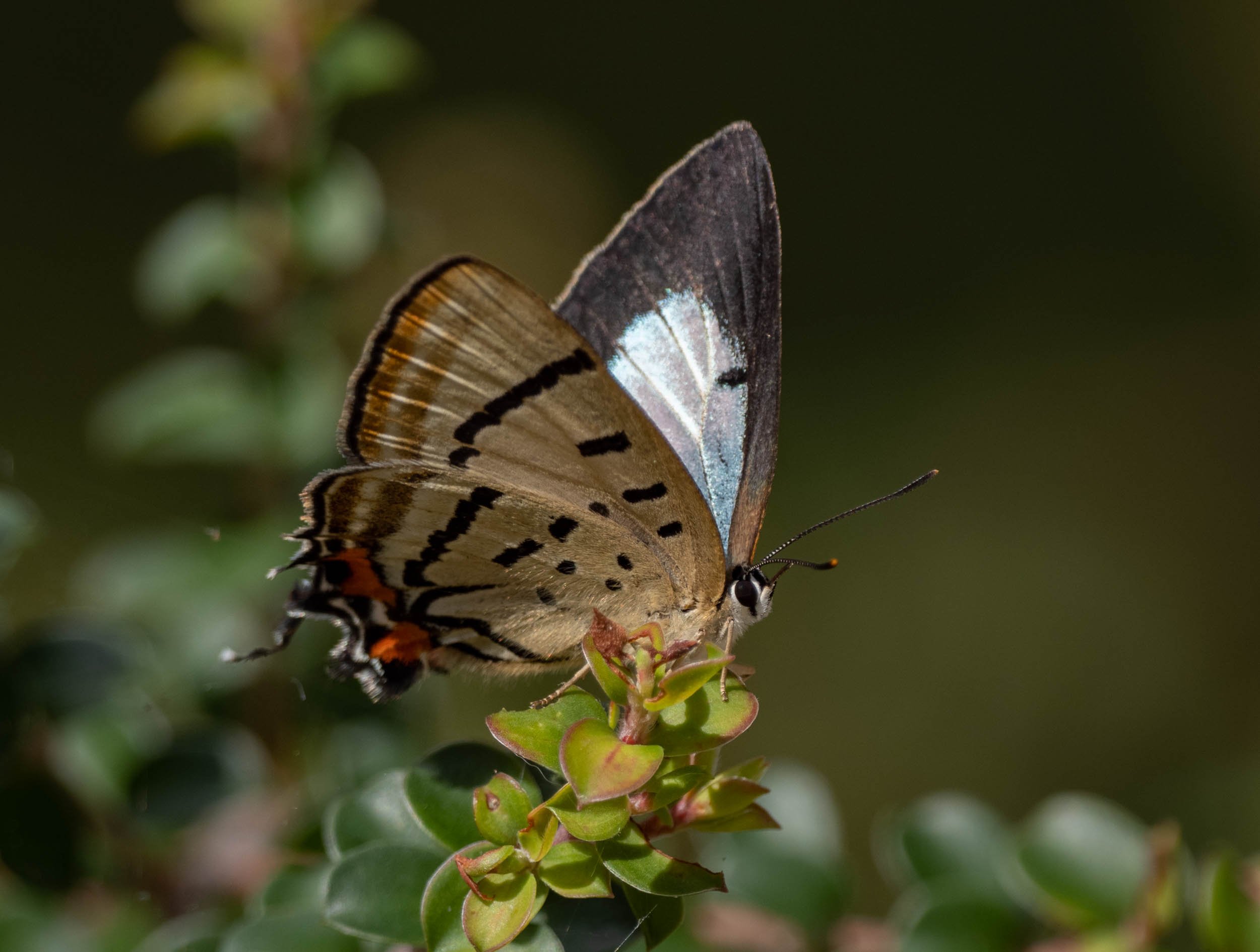
Imperial Hairstreak
Jalmenus evagoras
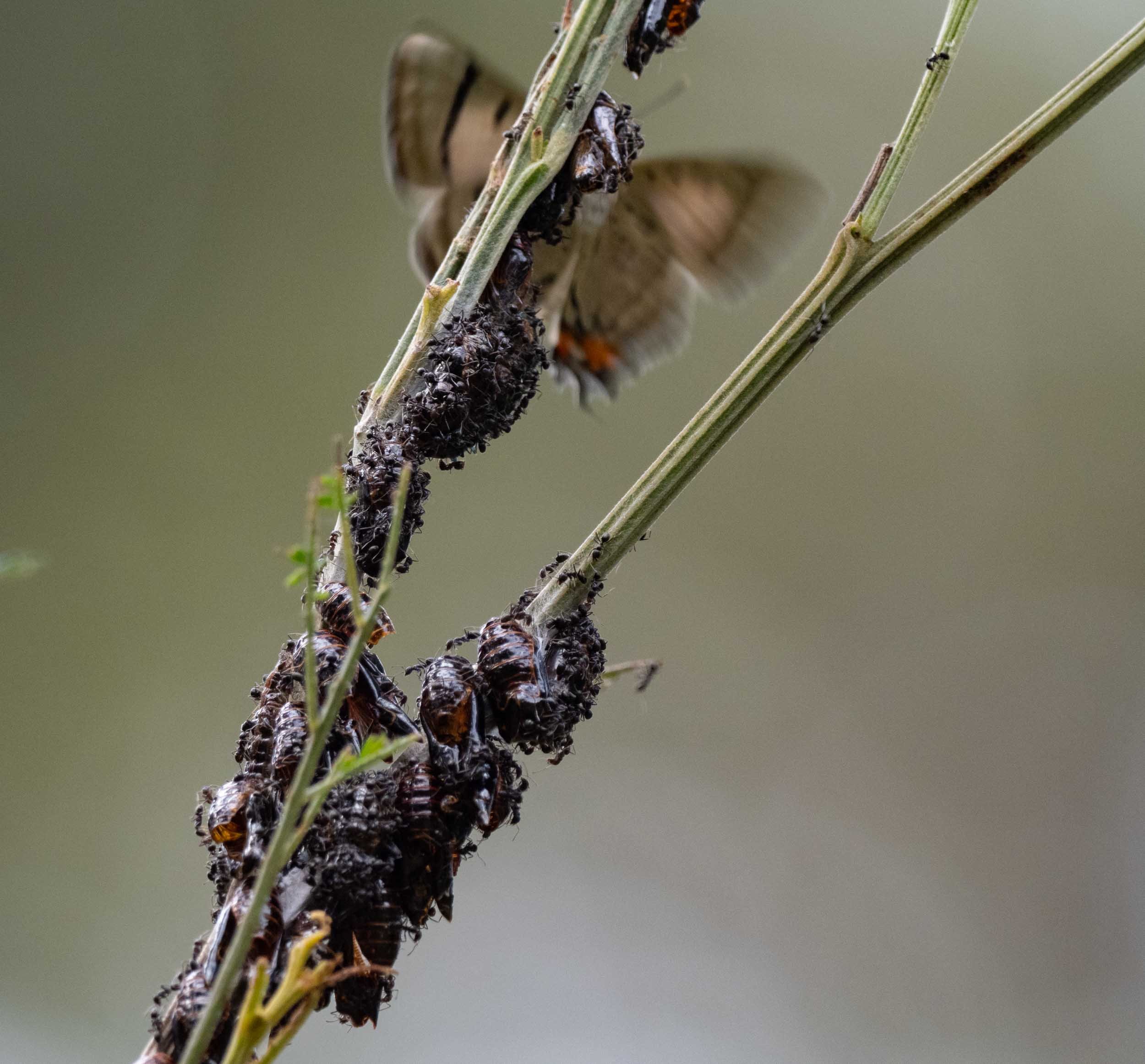
Imperial Hairstreak colony
Jalmenus evagorus
The caterpillars are making a meal of this ‘Black Wattle’, protected by large numbers of attendant ants. Many have pupated, and the oldest have eclosed … so the bush is surrounded by fluttering butterflies. We tend to prefer ‘butterfly bush’ as a common name for Acacia mearnsii.
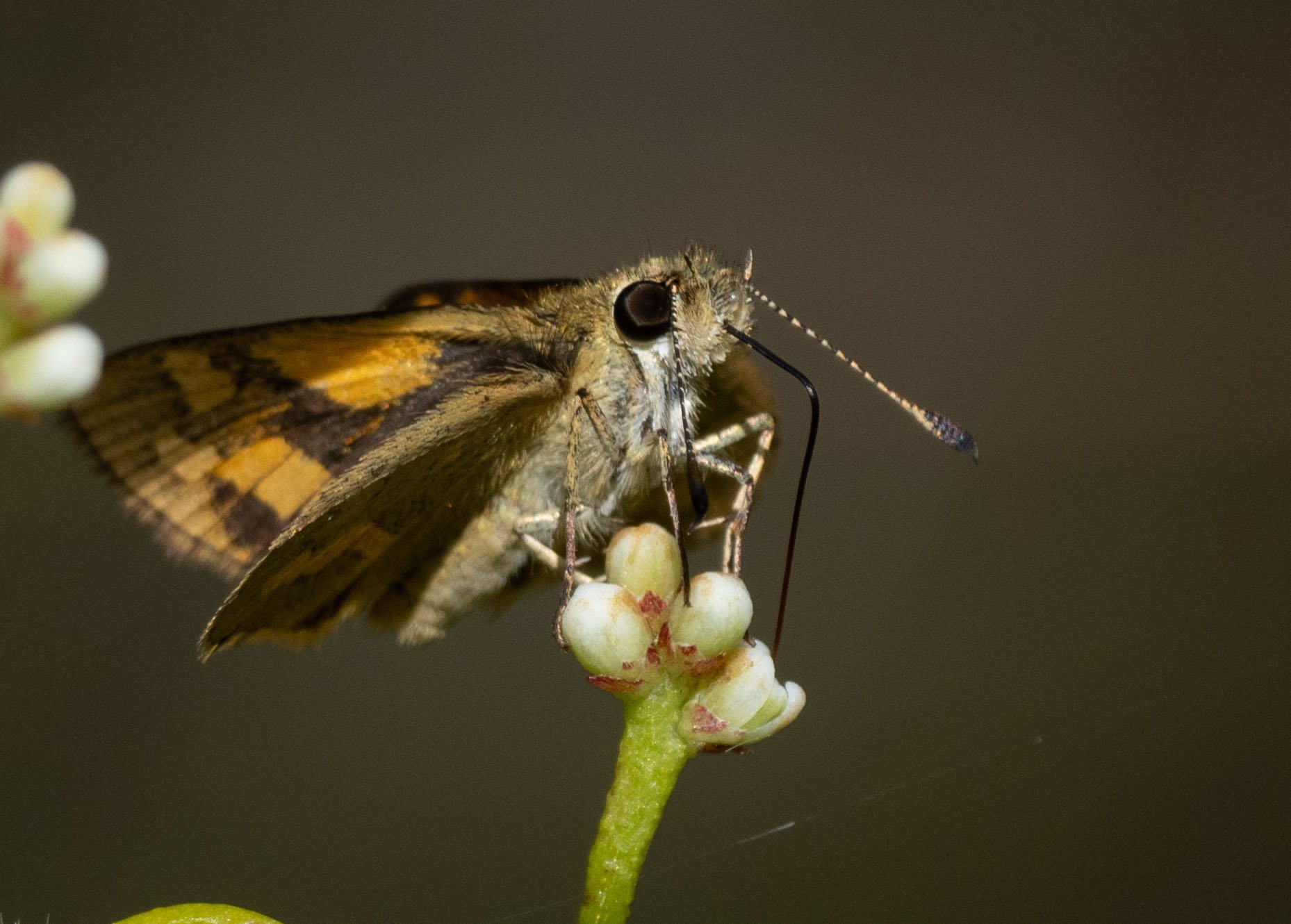
Green Grass-Dart
Ocybadistes walkeri
A common, very small butterfly feeding on the even smaller flowers of Cassytha.
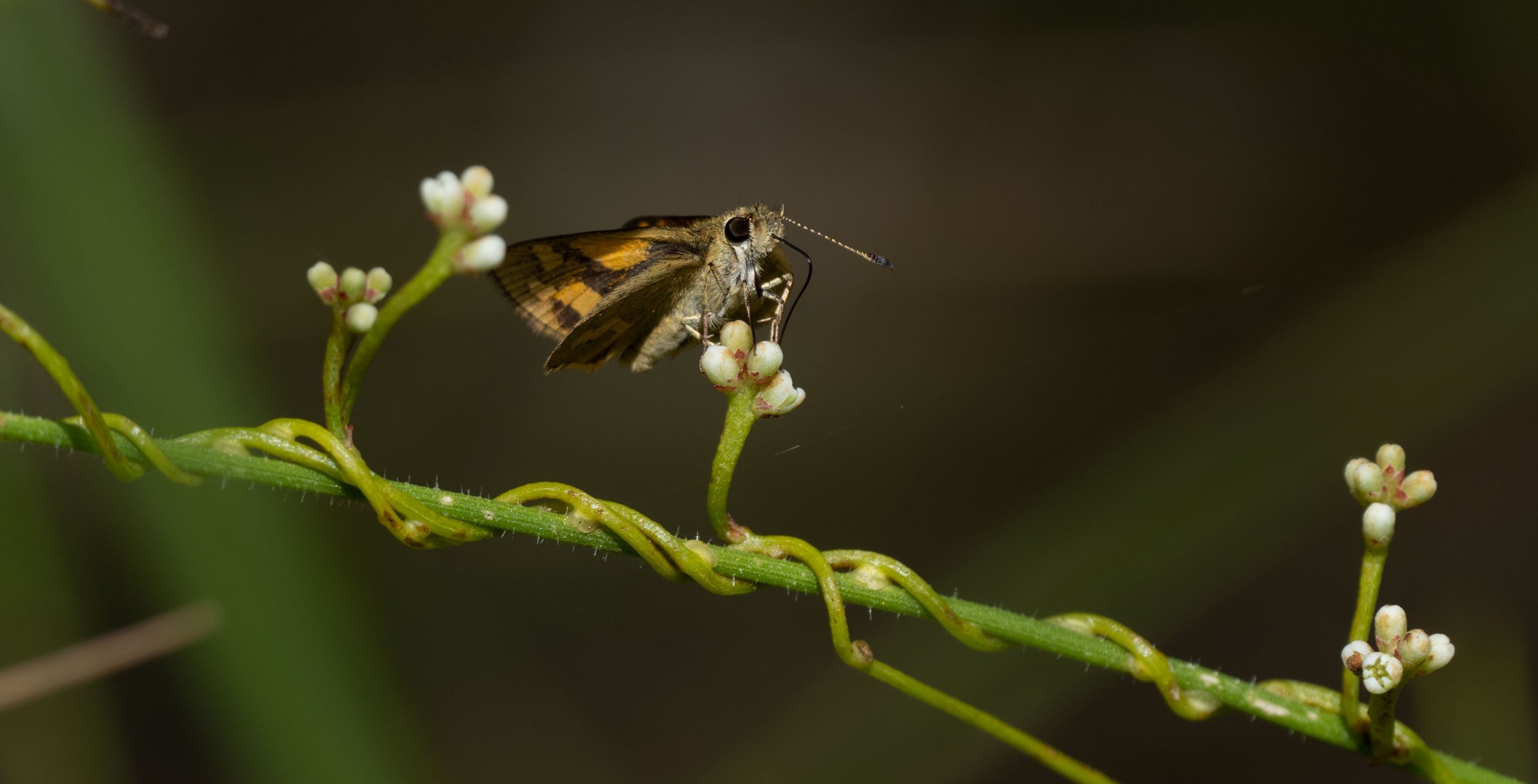
Devil's Twine
Cassytha pubescens
The photosynthetic stem of this hemi-parasitic plant twines around its host plant and uses disc shaped organs - haustoria, visible in this photo - to extract water and nutrients from the xylem of its host. It is one of the few plants flowering in late summer, providing a nectar feed for butterflies. Cassytha has only recently reappeared, a late post-fire recovery.
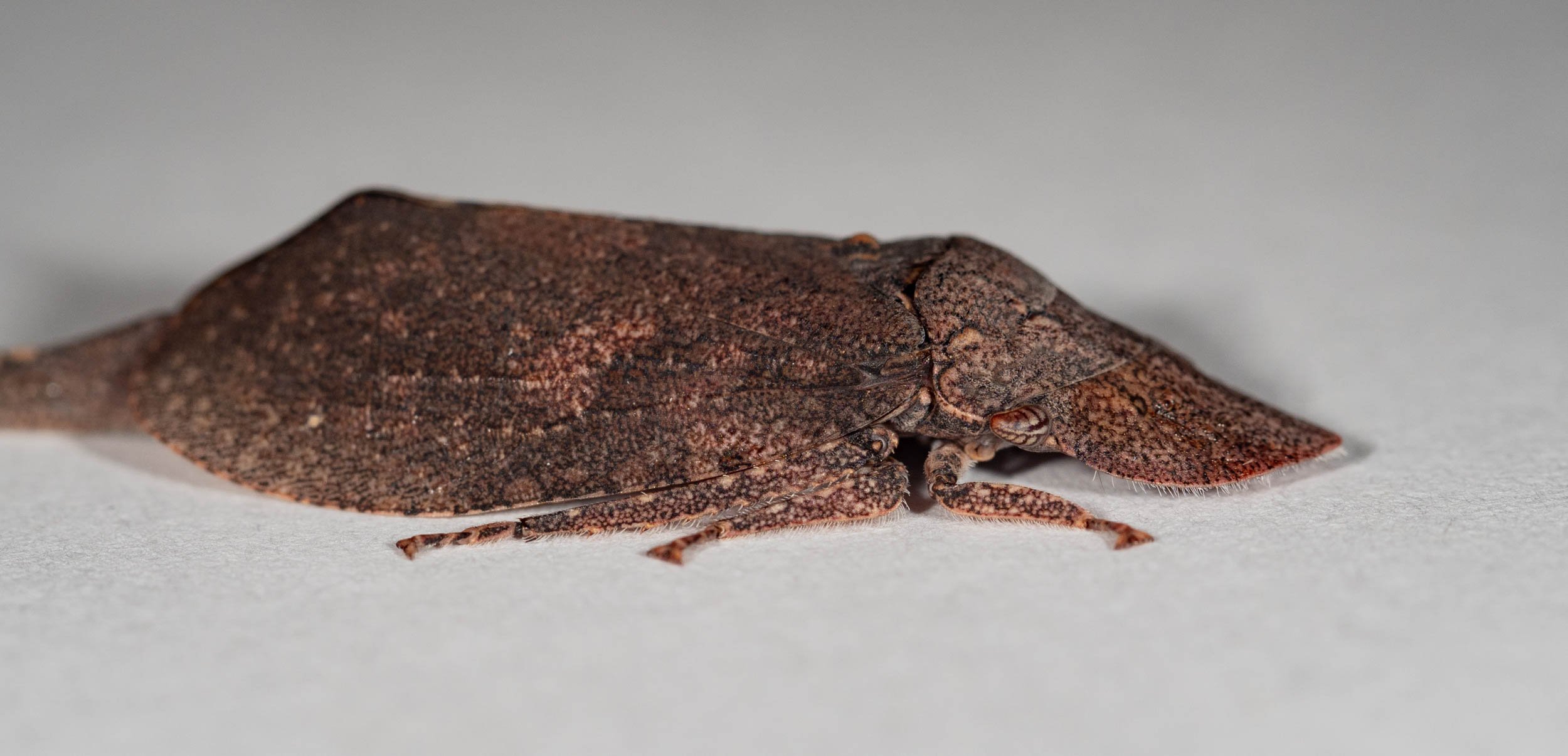
flat-headed leafhopper
Ledromorpha planirostris
A large and truly weird-looking bug!
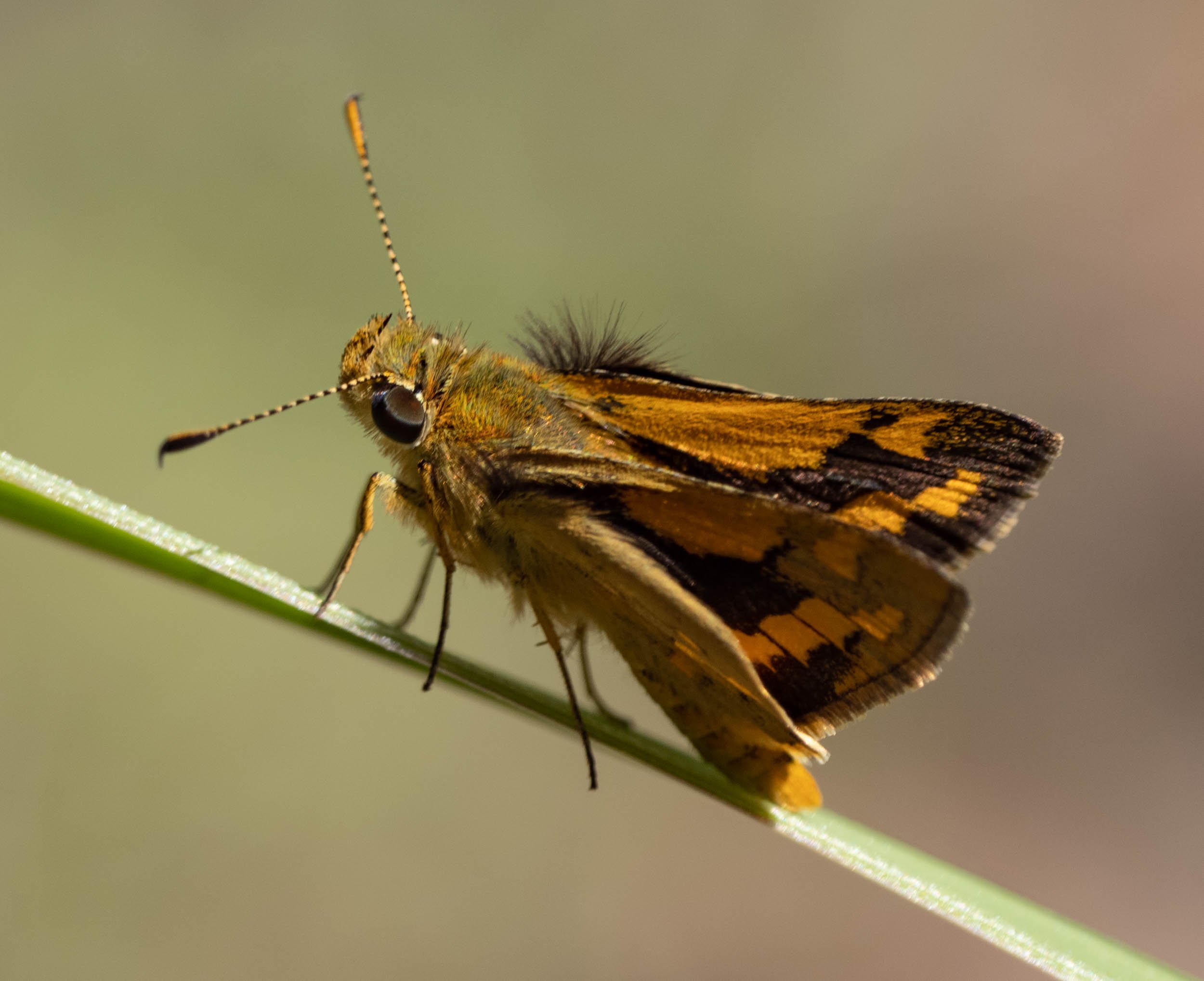
Green Grass-Dart
Ocybadistes walkeri
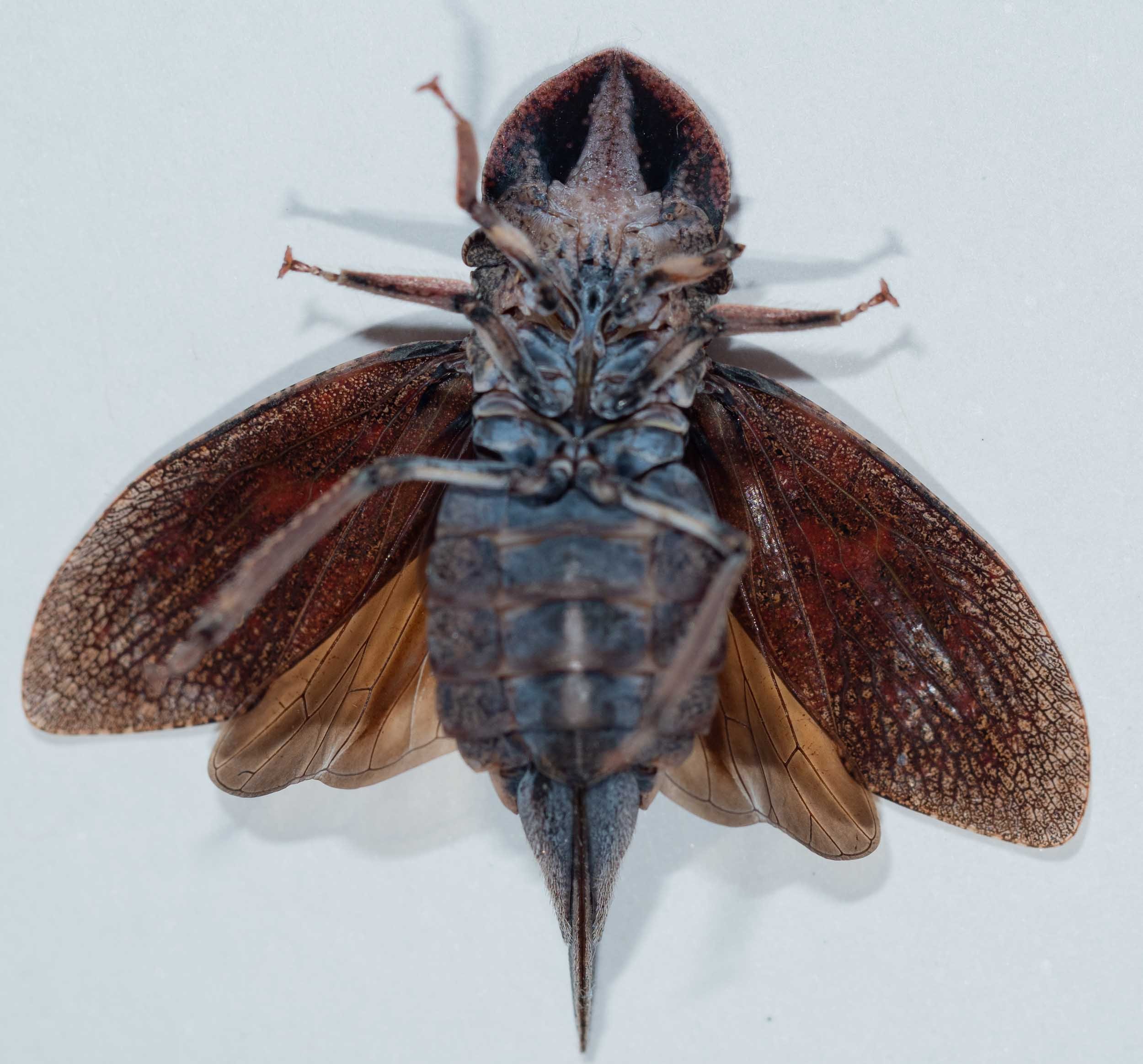
flat-headed leafhopper
Ledromorpha planirostris
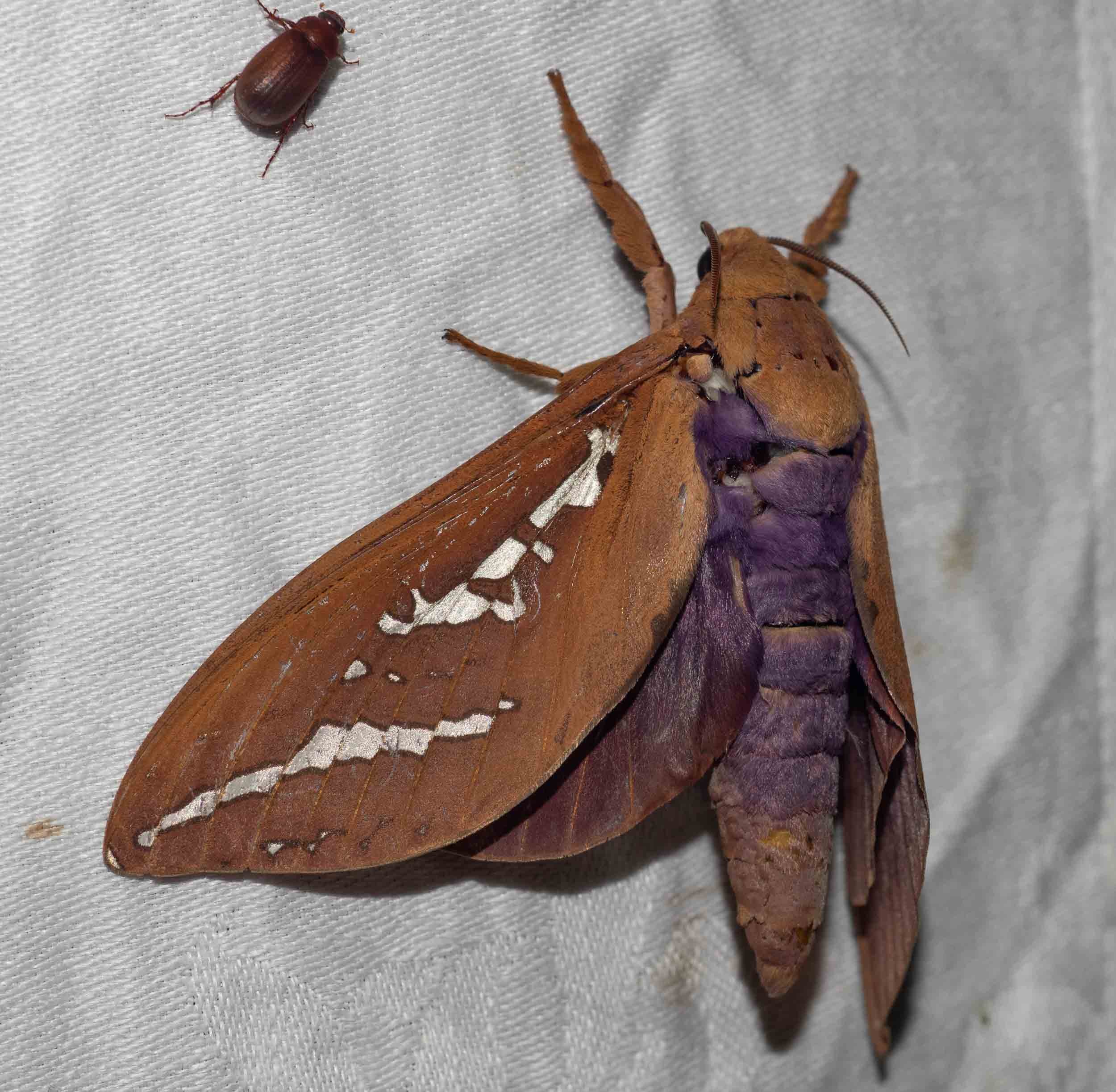
Mustard Ghost Moth
Abantiades hyalinatus
This lovely big moth made an appearance on our February light sheet. This shot shows its eponymously coloured hindwings.
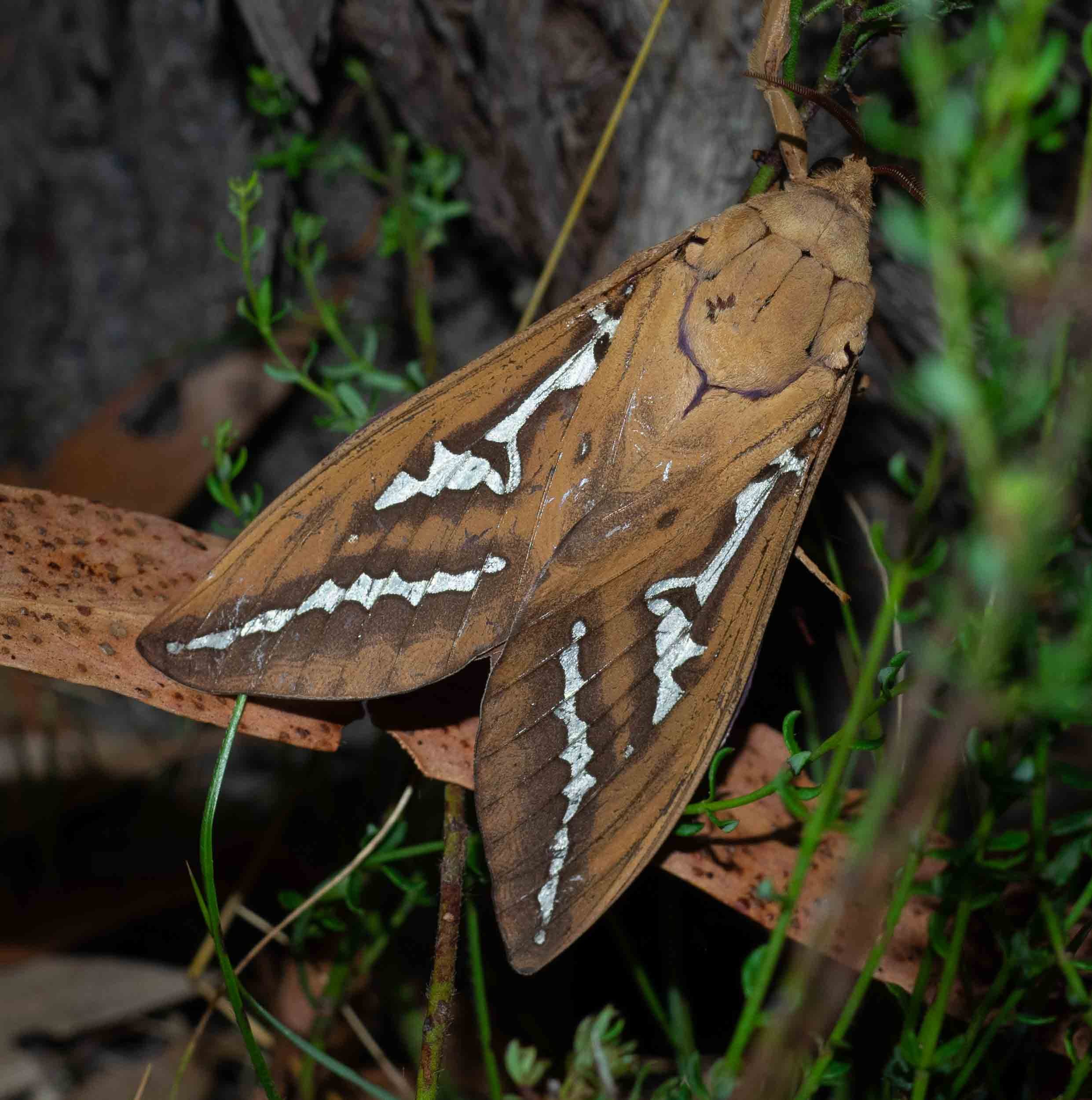
Mustard Ghost Moth
Abantiades hyalinatus
While it was attracted to the lightsheet, this moth also fluttered around in the vegetation nearby. It is one of the largest members of the ghost moth family (Hepidalidae).

Mustard Ghost Moth pupal case
Abantiades hyalinatus
We found this next to a large hole, from which we presume the adult emerged from its pupal case. The larvae of this moth probably bore vertical holes in the ground to feed on the roots of eucalypt saplings and pupate in that tunnel.

Gang-gang Cockatoo
Callocephalon fimbriatum
This male and accompanying female were investigating tree hollows in a tall, old Eucalyptus cypellocarpa (Mountain Grey Gum).
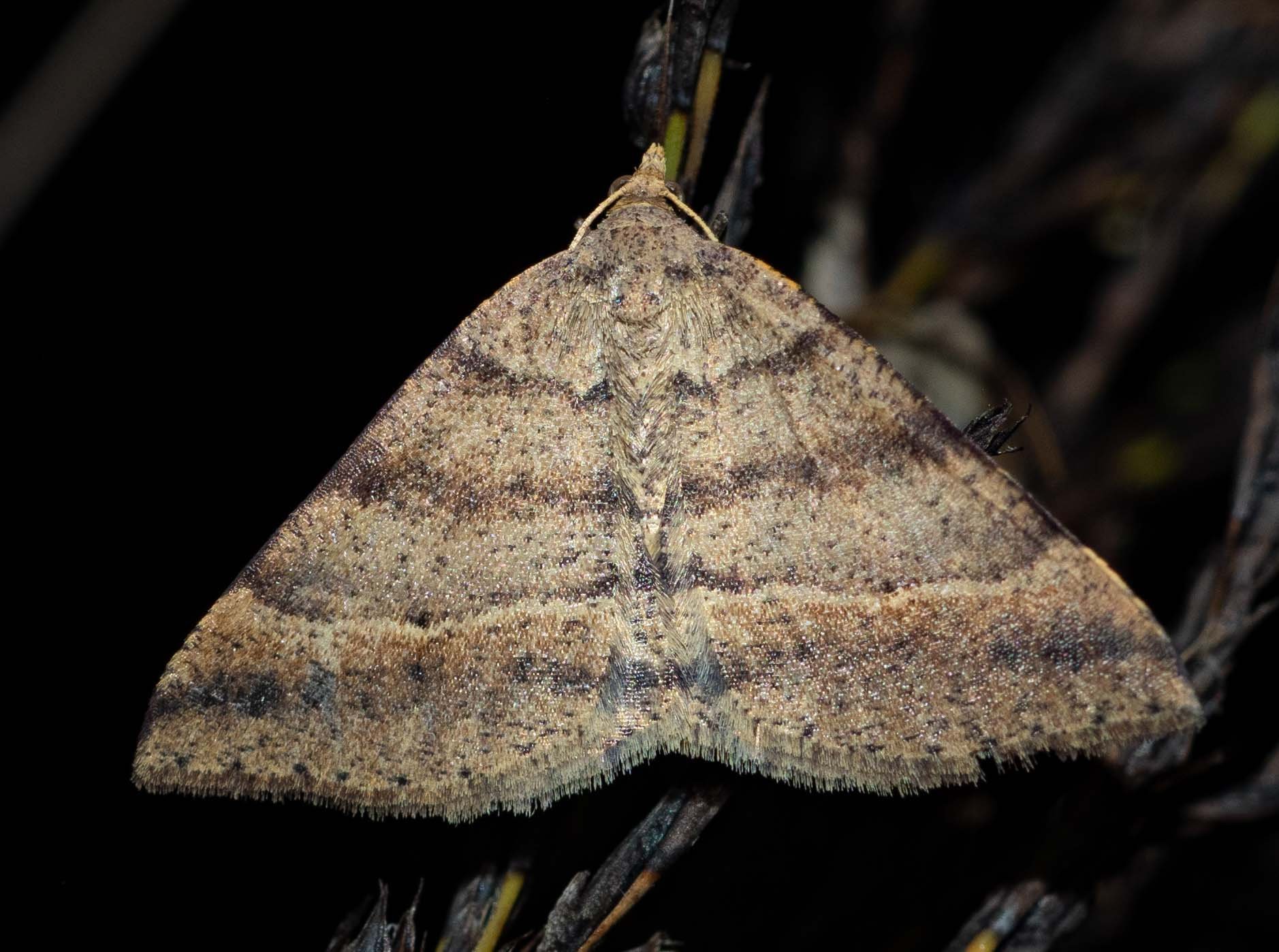
Dodonaea Moth
Parosteodes fictiliaria
The food plant for the caterpillar of this species is Dodonaea which just happens to be one of the most common shrubs in our forest. Probably no coincidence!
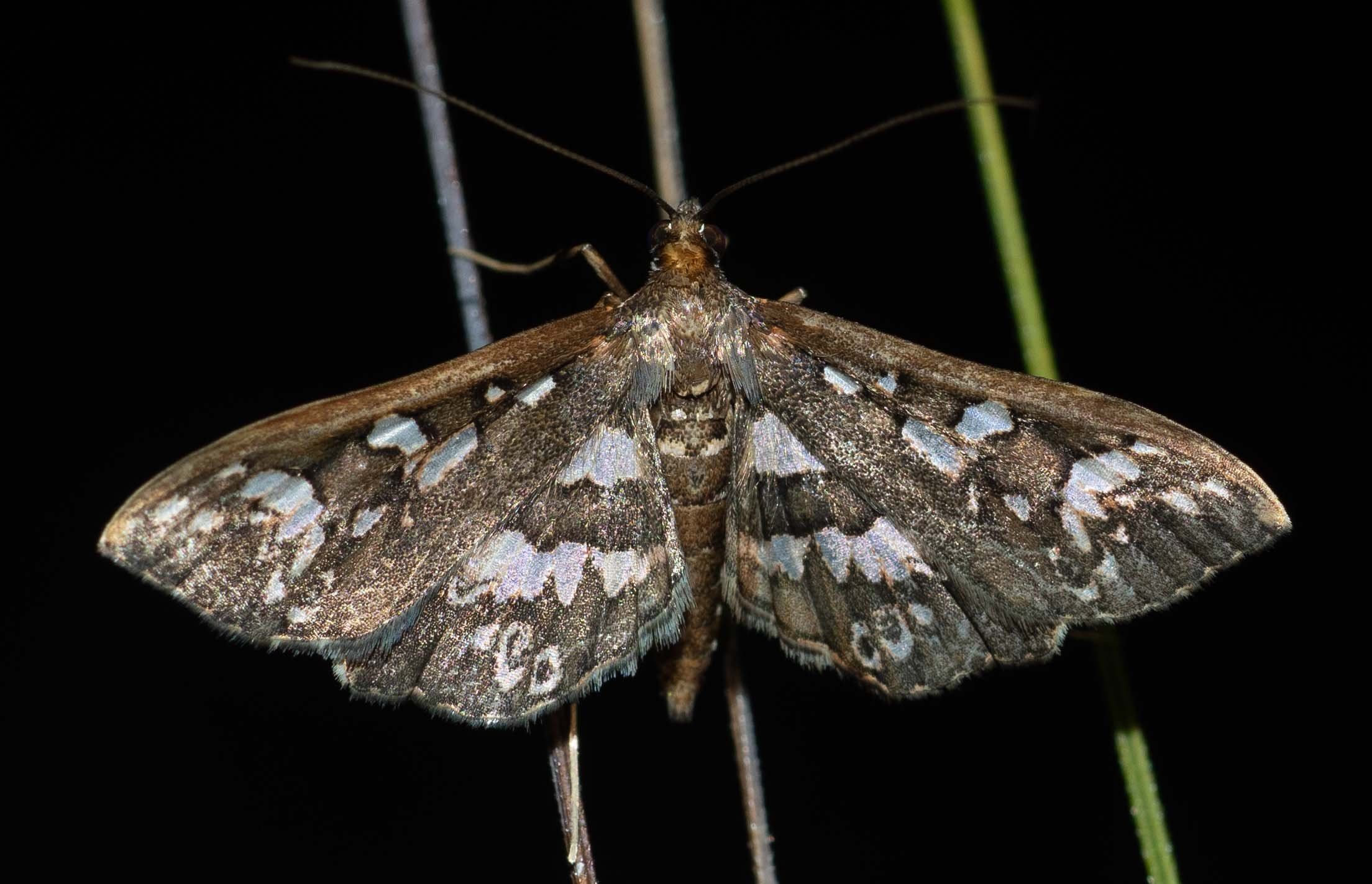
Pearl Moth
Ischnurges illustralis
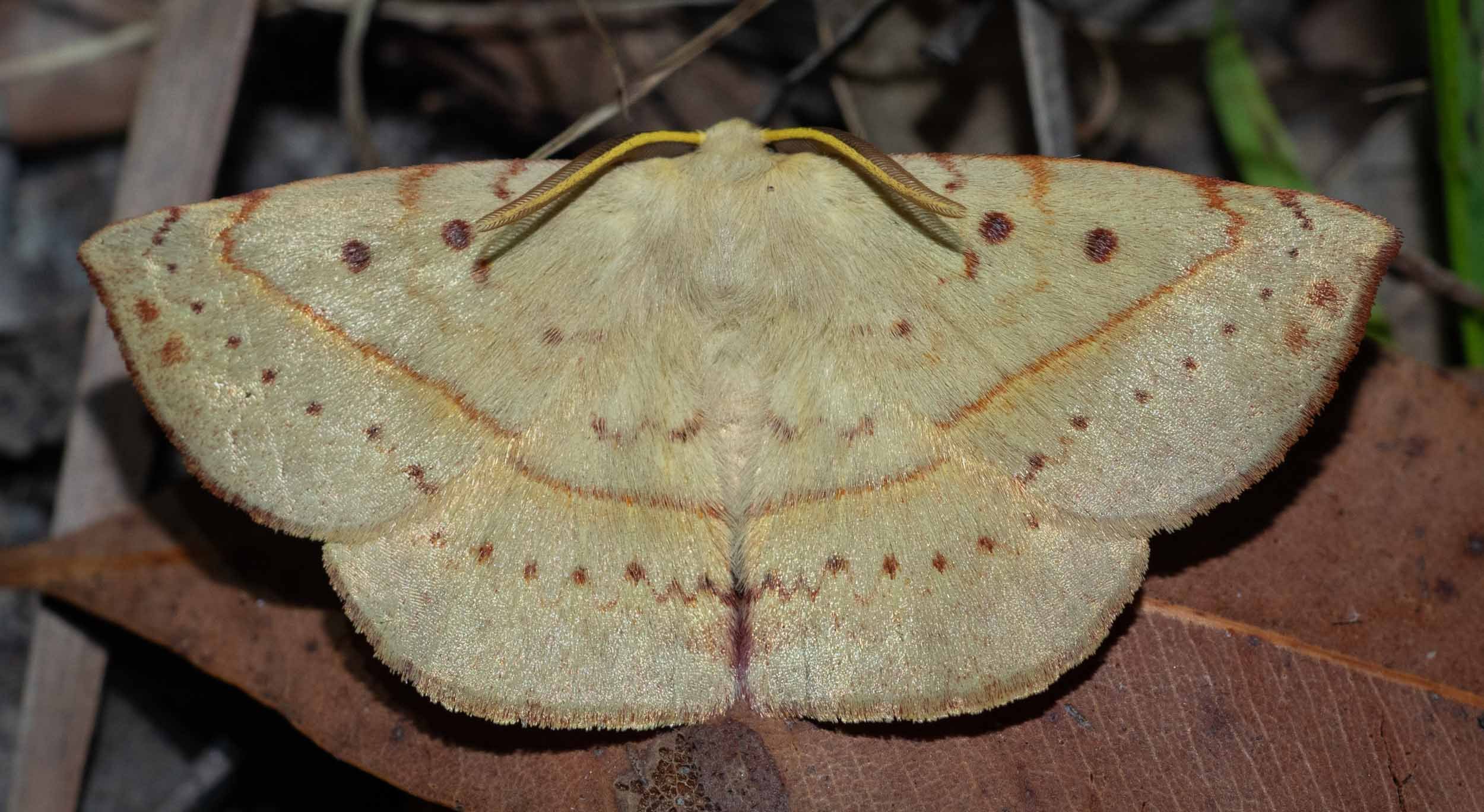
Common Anthelid Moth
Anthela acuta
This moth often comes to lightsheets - seen between August and March. It comes in a variety of colours, from the yellowish shown here to whitish to reddish brown.
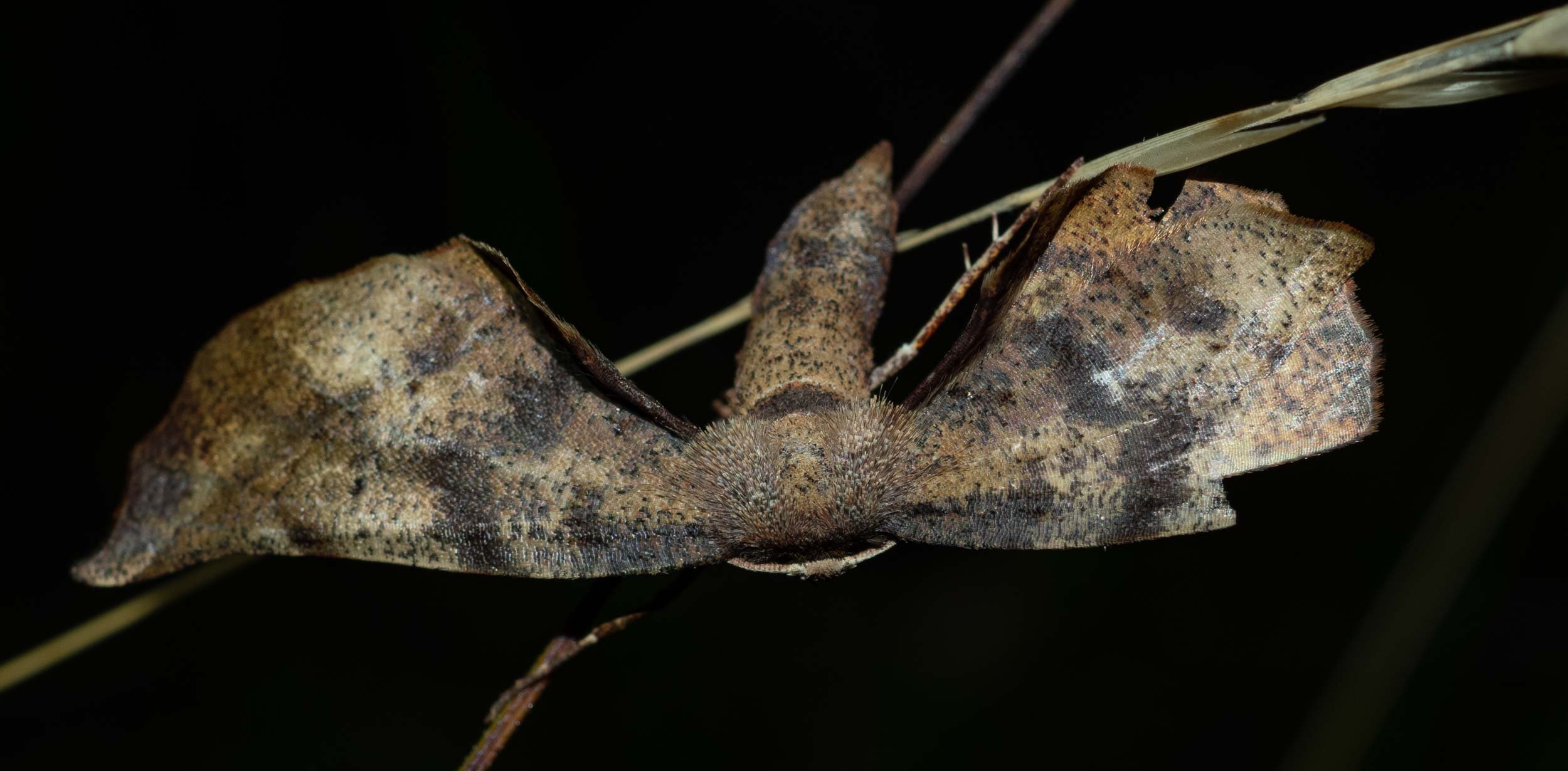
Geometer moth
Parepisparis excusata
This species often rests as shown here - with its abdomen twisted to the side and its hindwings hidden behind outstretched forewings. Its larvae feed on Eucalyptus spp.
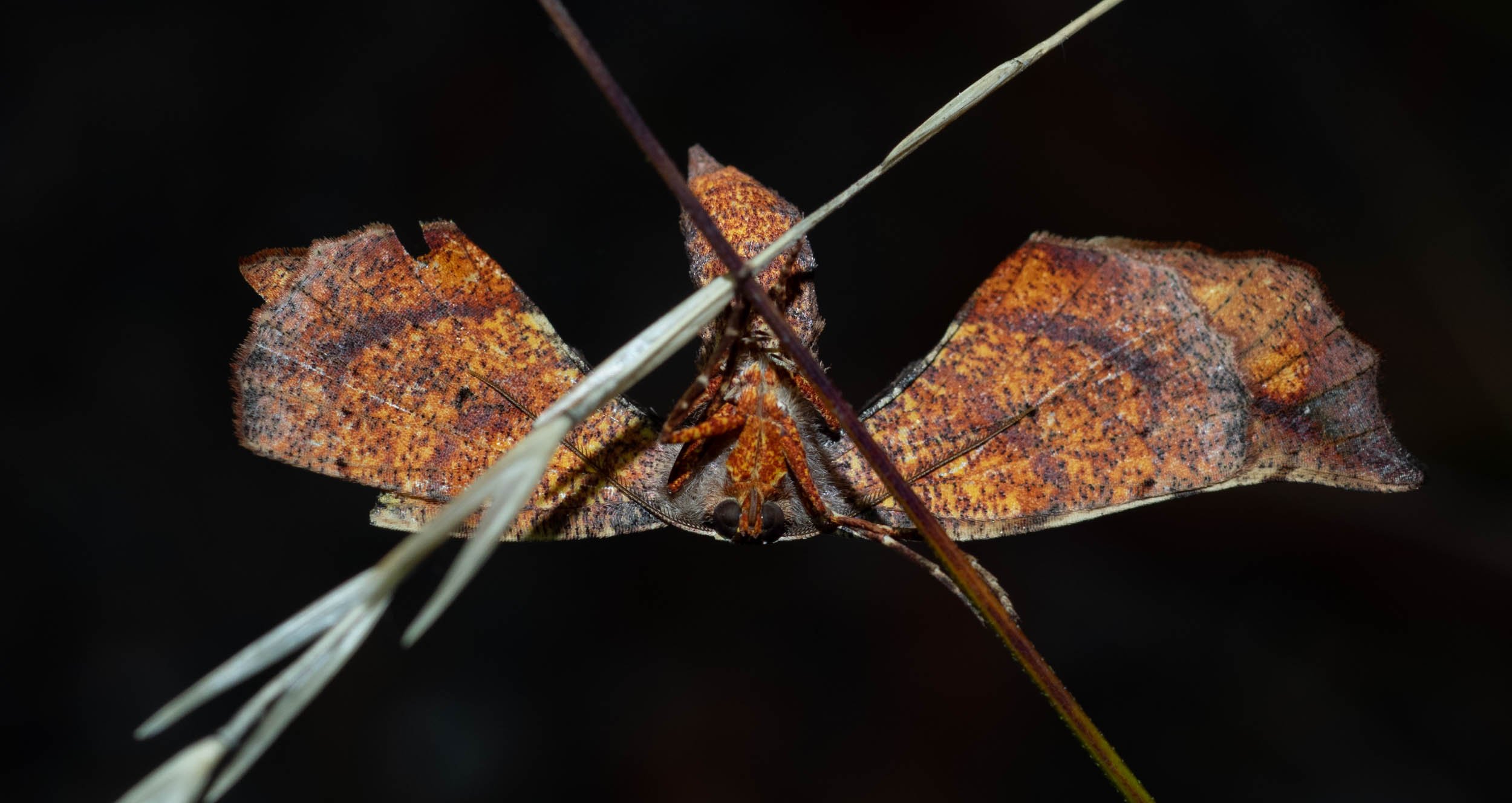
Geometer moth
Parepisparis excusata
This view from beneath shows the hindwings neatly placed directly behind the forewings.
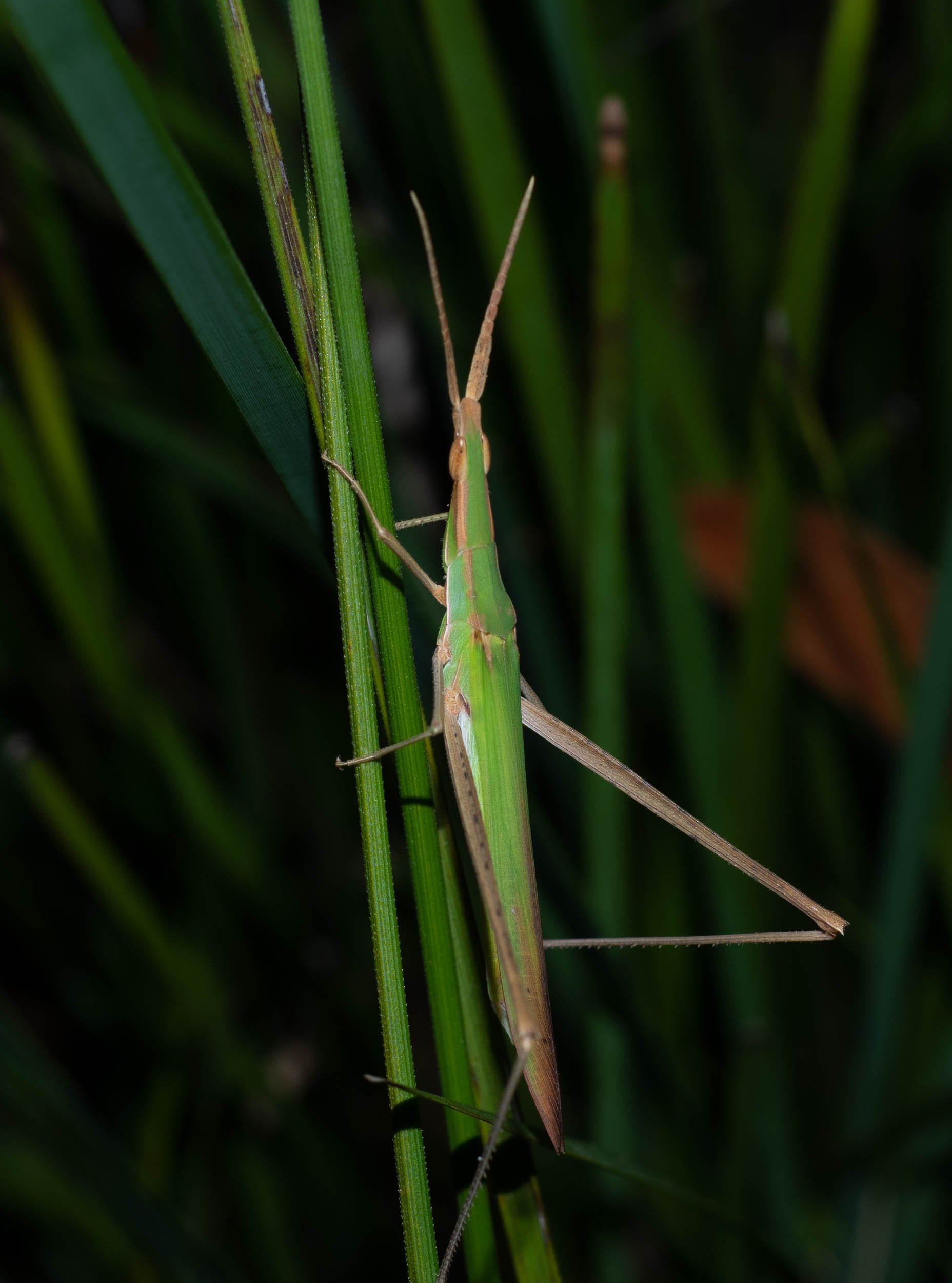
Giant Green Slantface
Acrida conica
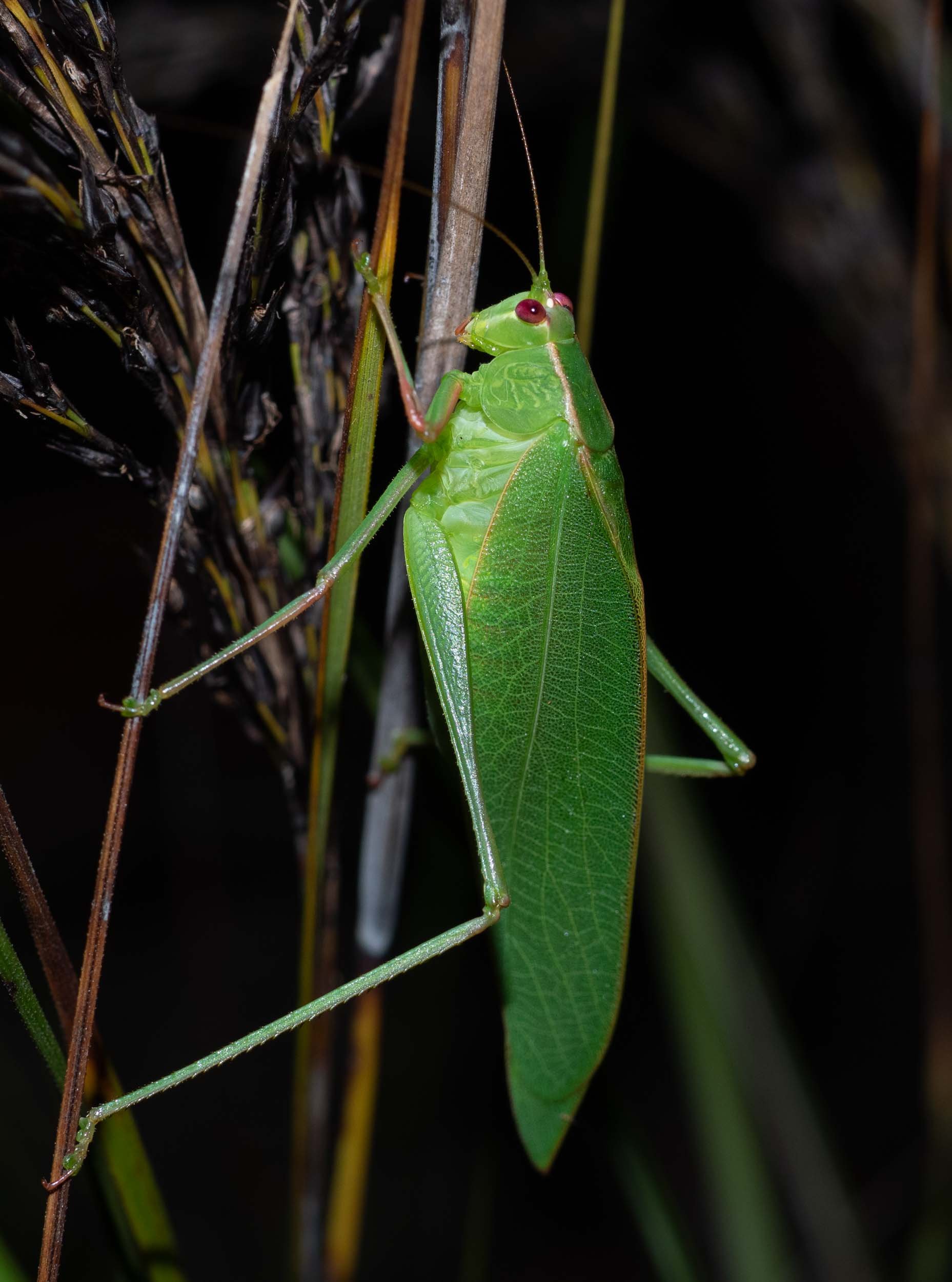
katydid
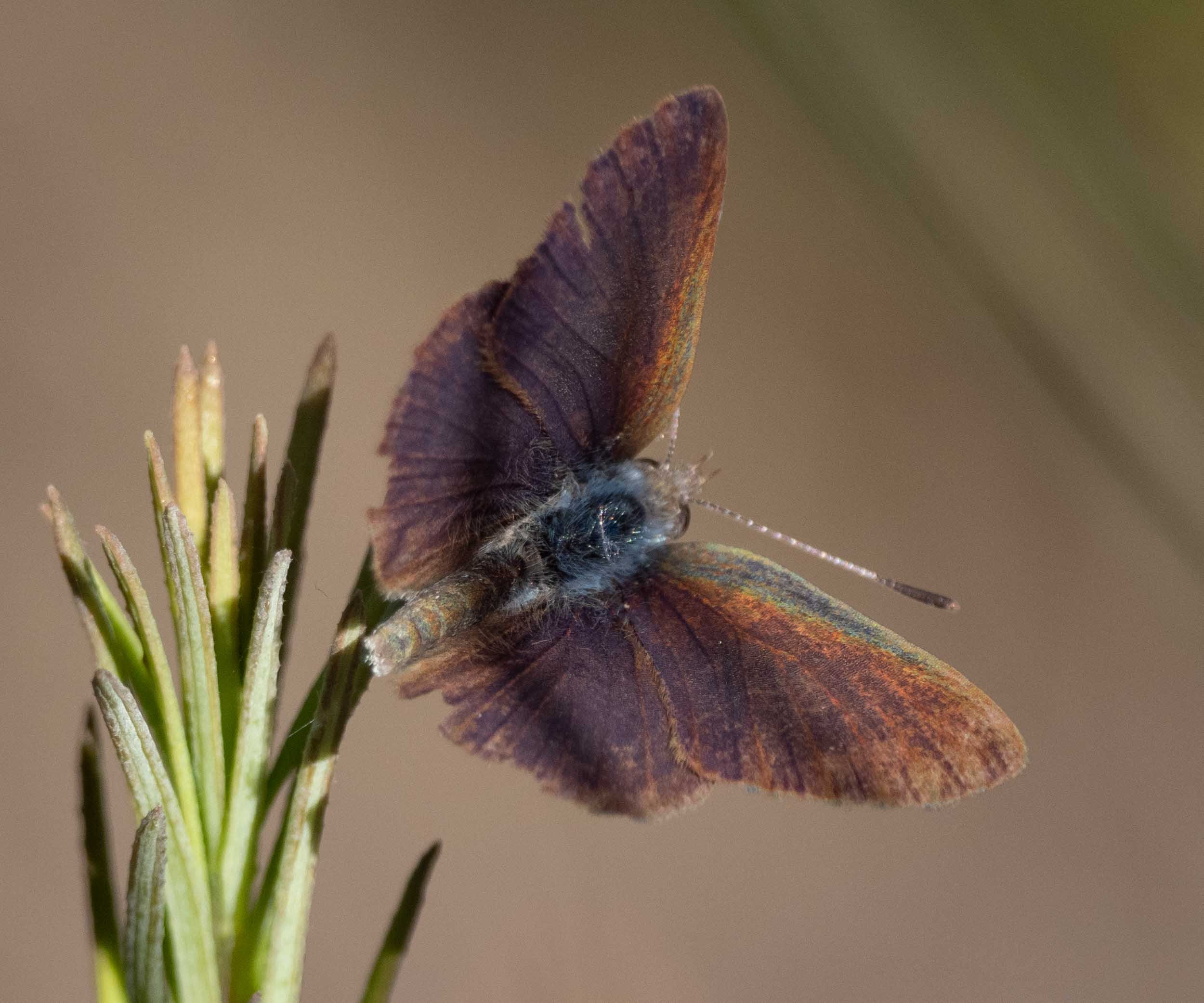
Blotched Dusky-Blue
Erina acasta
At first glance this looked like our common blue (Erina hyacinthina), but it’s actually a species we’ve not seen here before. Larval food plant? Cassytha. And that’s a plant we currently have rather a lot of!
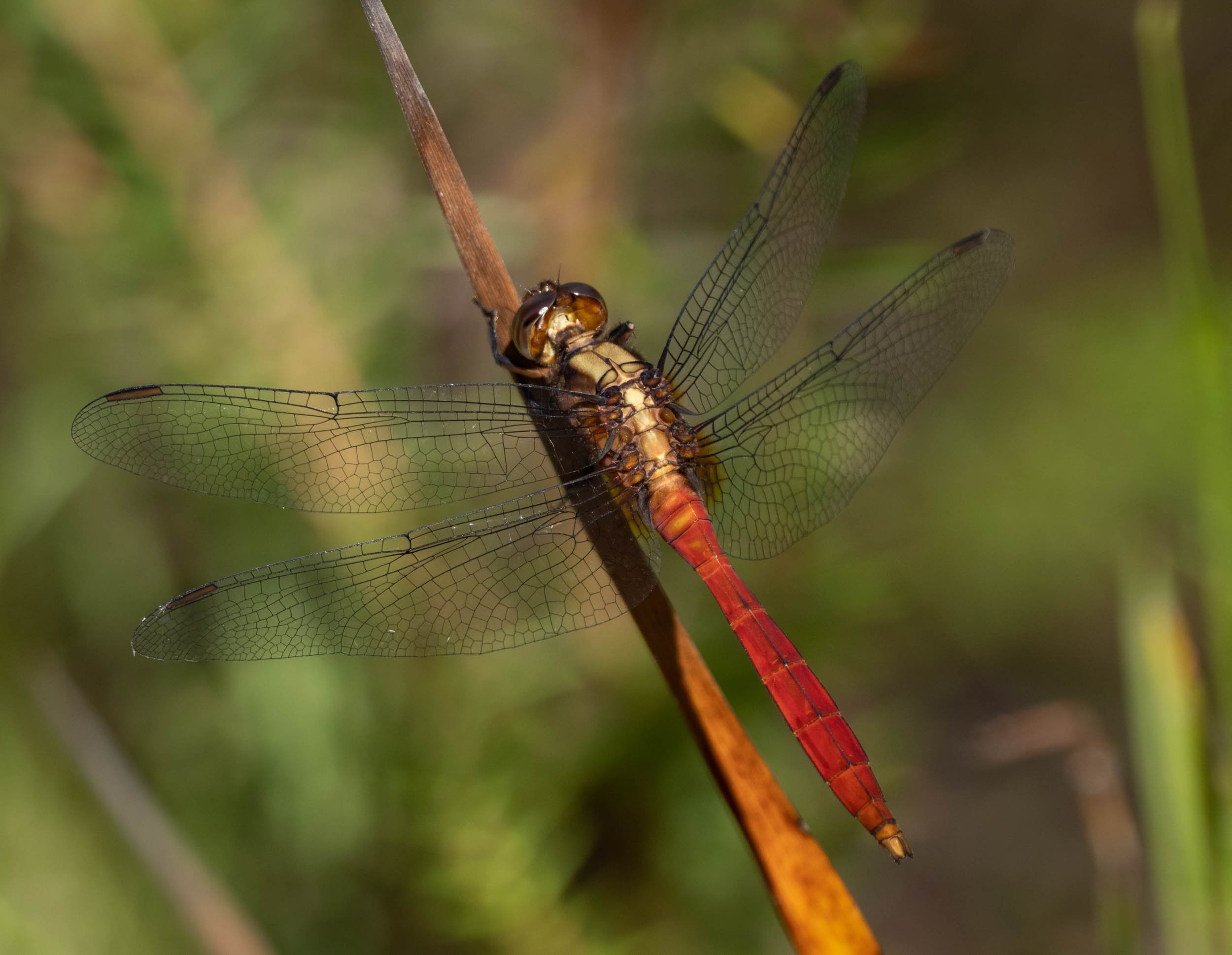
Fiery Skimmer
Orthetrum villosovittatum
A species we see here only rarely.
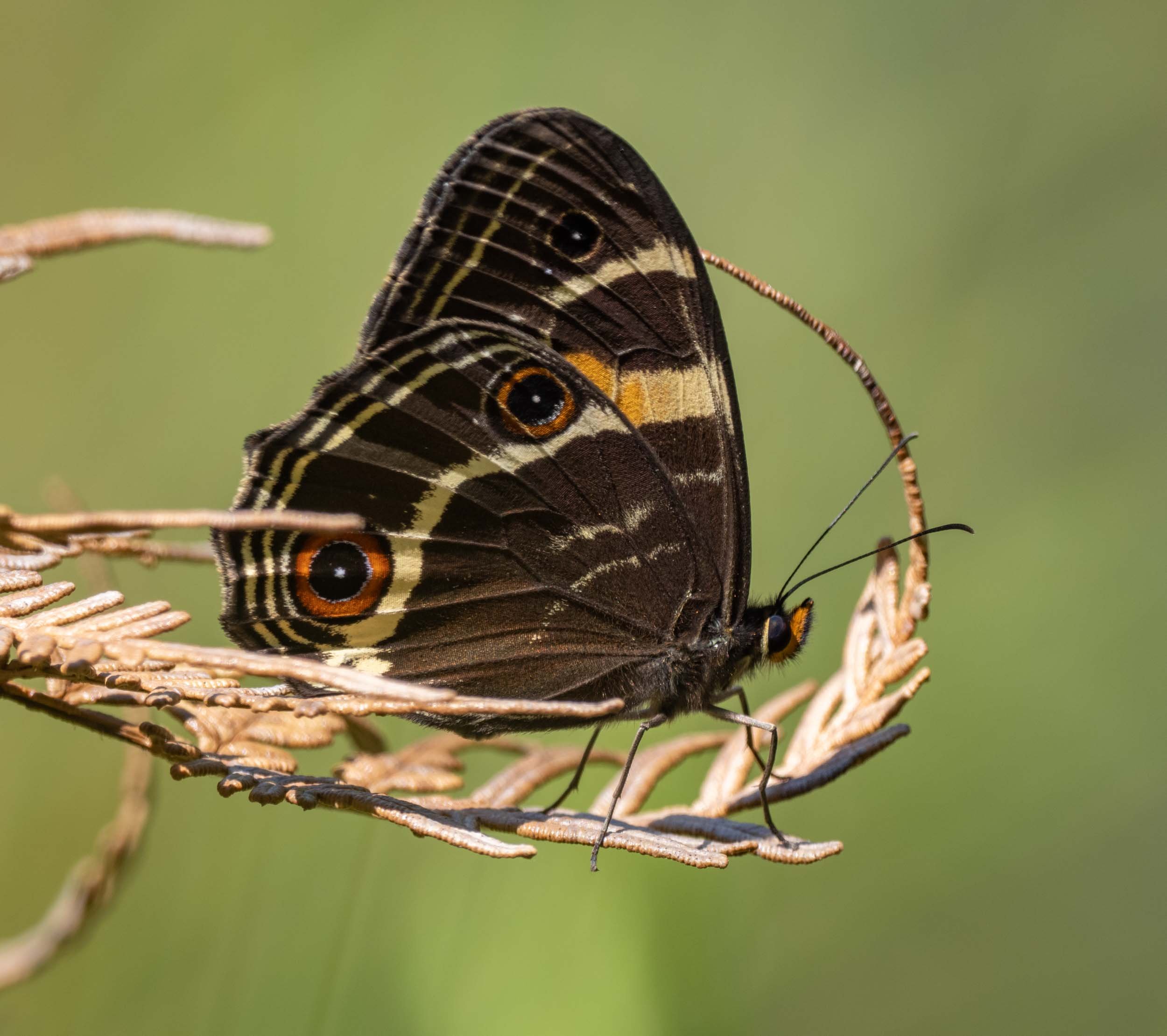
Varied Sword-grass Brown
Tisiphone abeona
More common than usual this year, perhaps due to the healthy crop of Gahnia that has established in the past few, wet years.
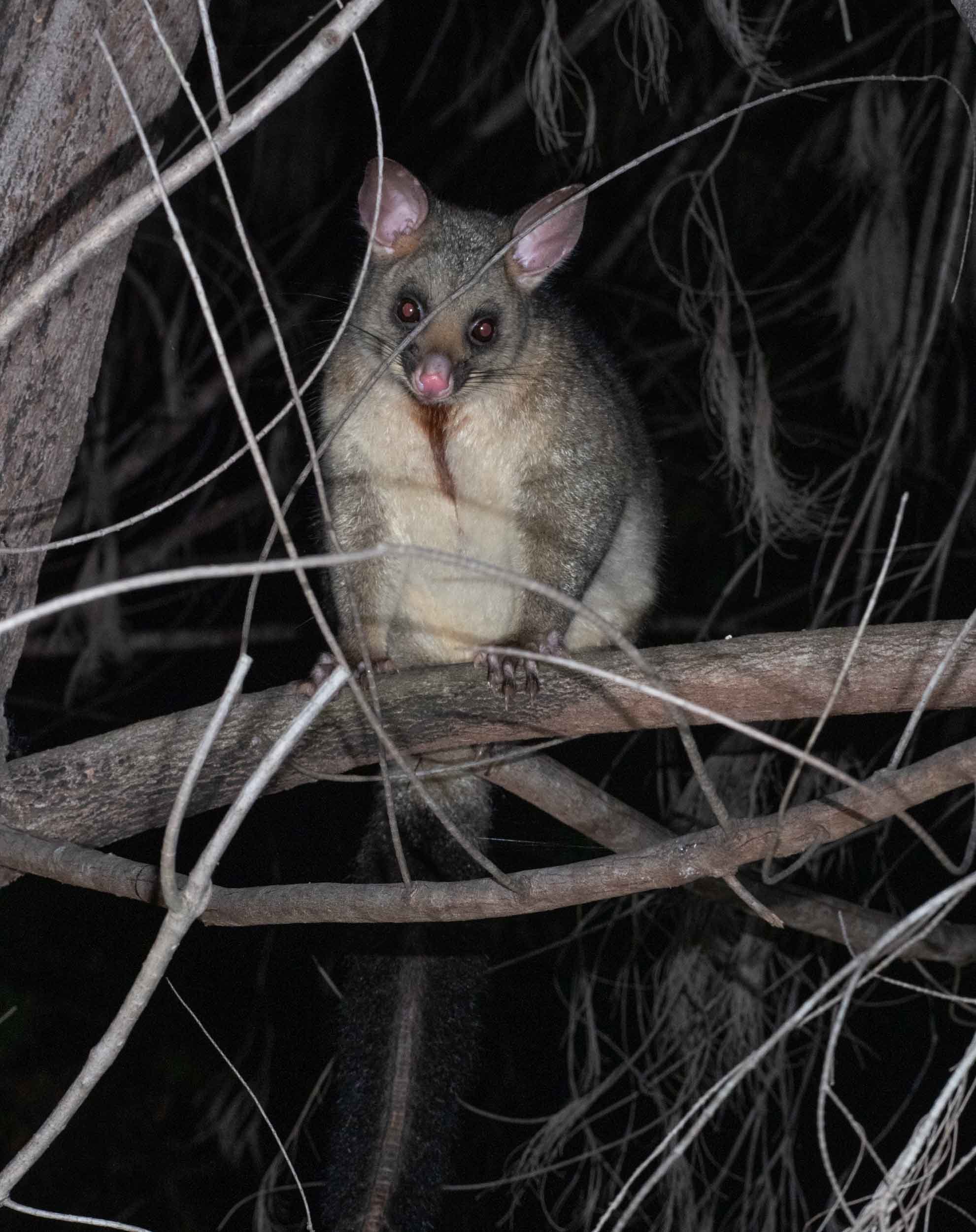
Common Brushtail Possum
Trichosorus vulpecula

Red-browed Finch
Neochmia temporalis
… with nesting material.
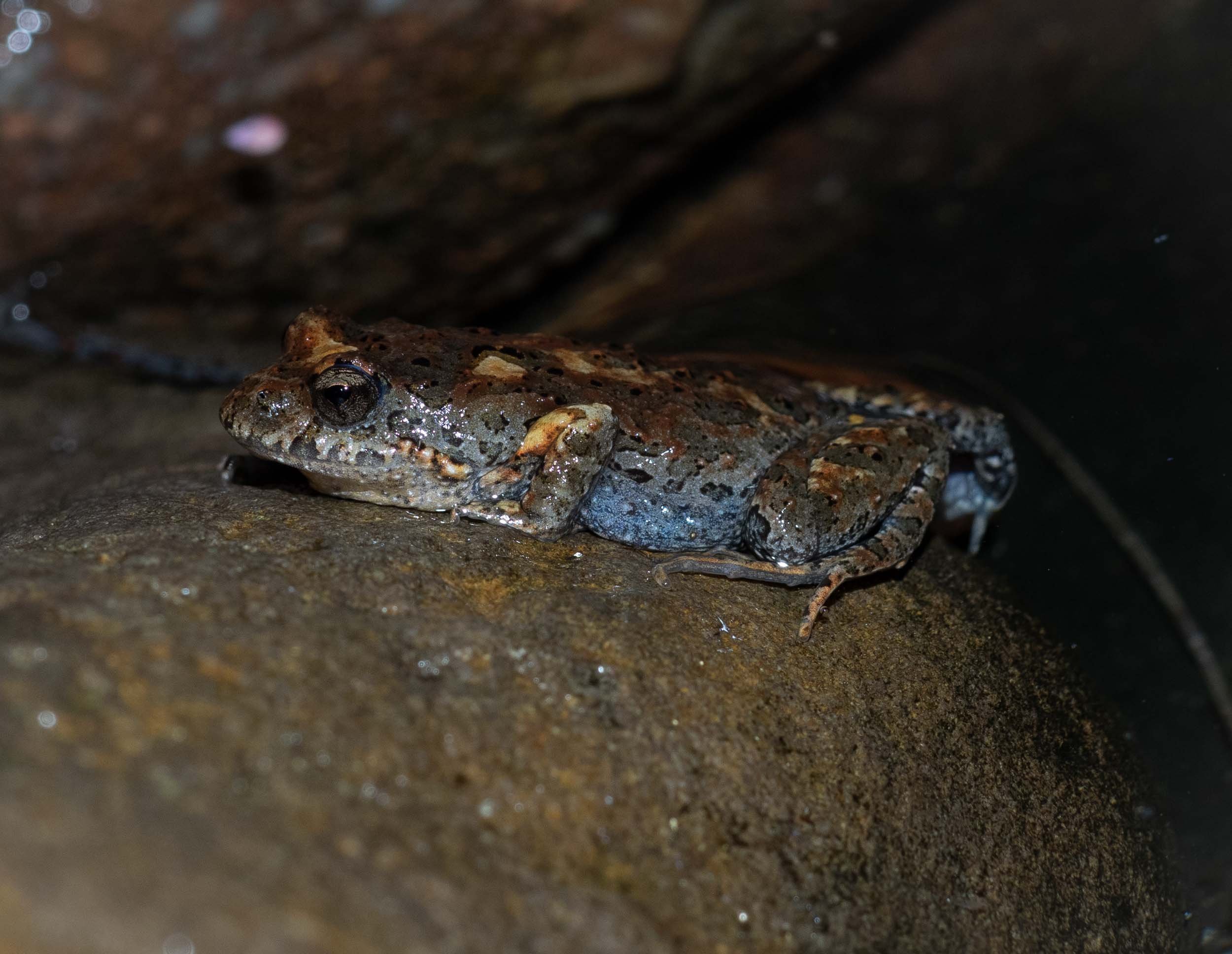
ground frog
There is some discussion about the identity of this small frog. I assumed it was Crinia signifera, the most common species in and around our little frog pond. But there’s a chance it is Uperoleia … I should try to record its calls amid the general cacophony of clicking, clacking, grunts and chuckles.
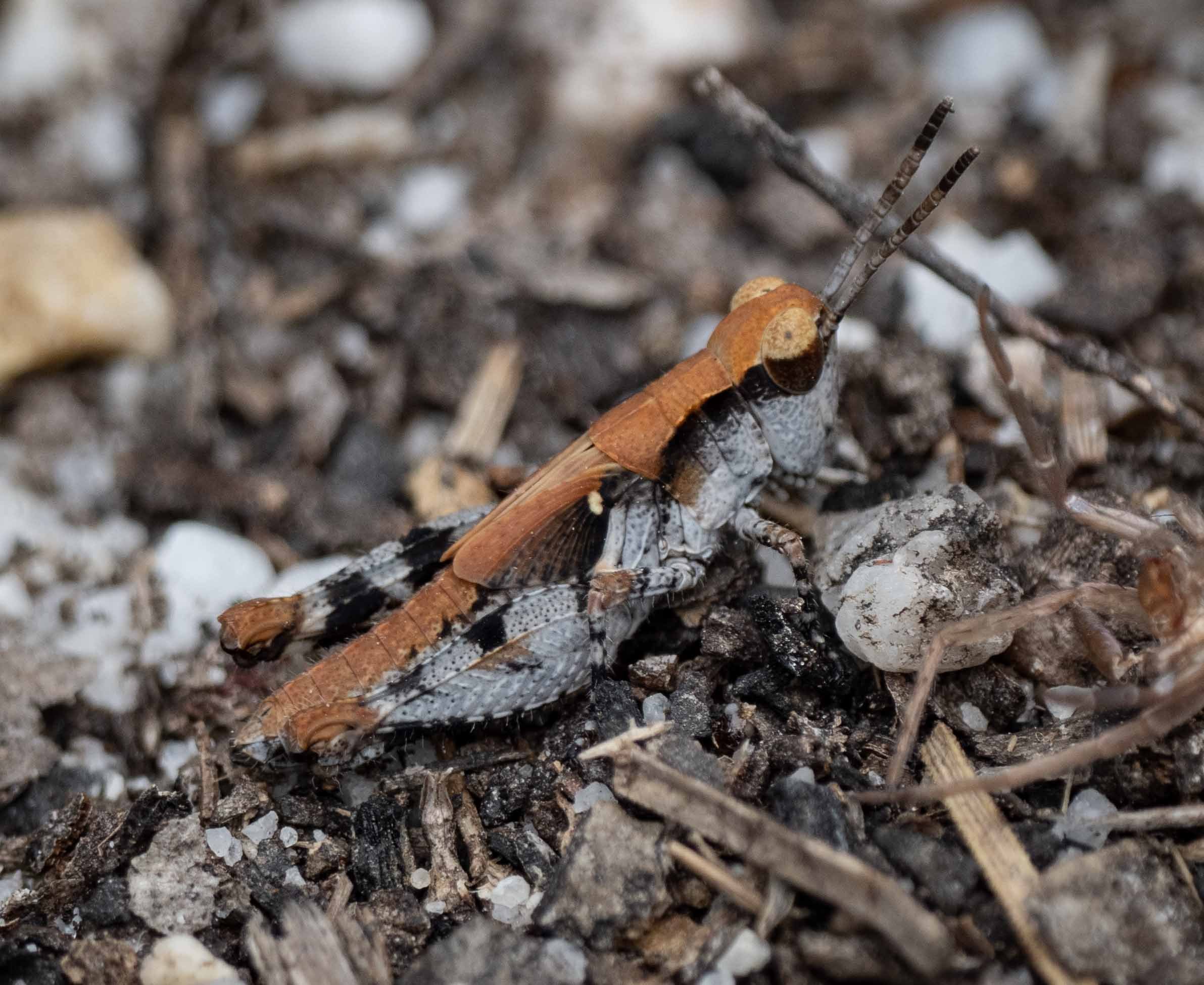
Wingless Grasshopper
Phaulacridium vittatum
Common, numerous, and sporting a striking variety of colours and patterns.
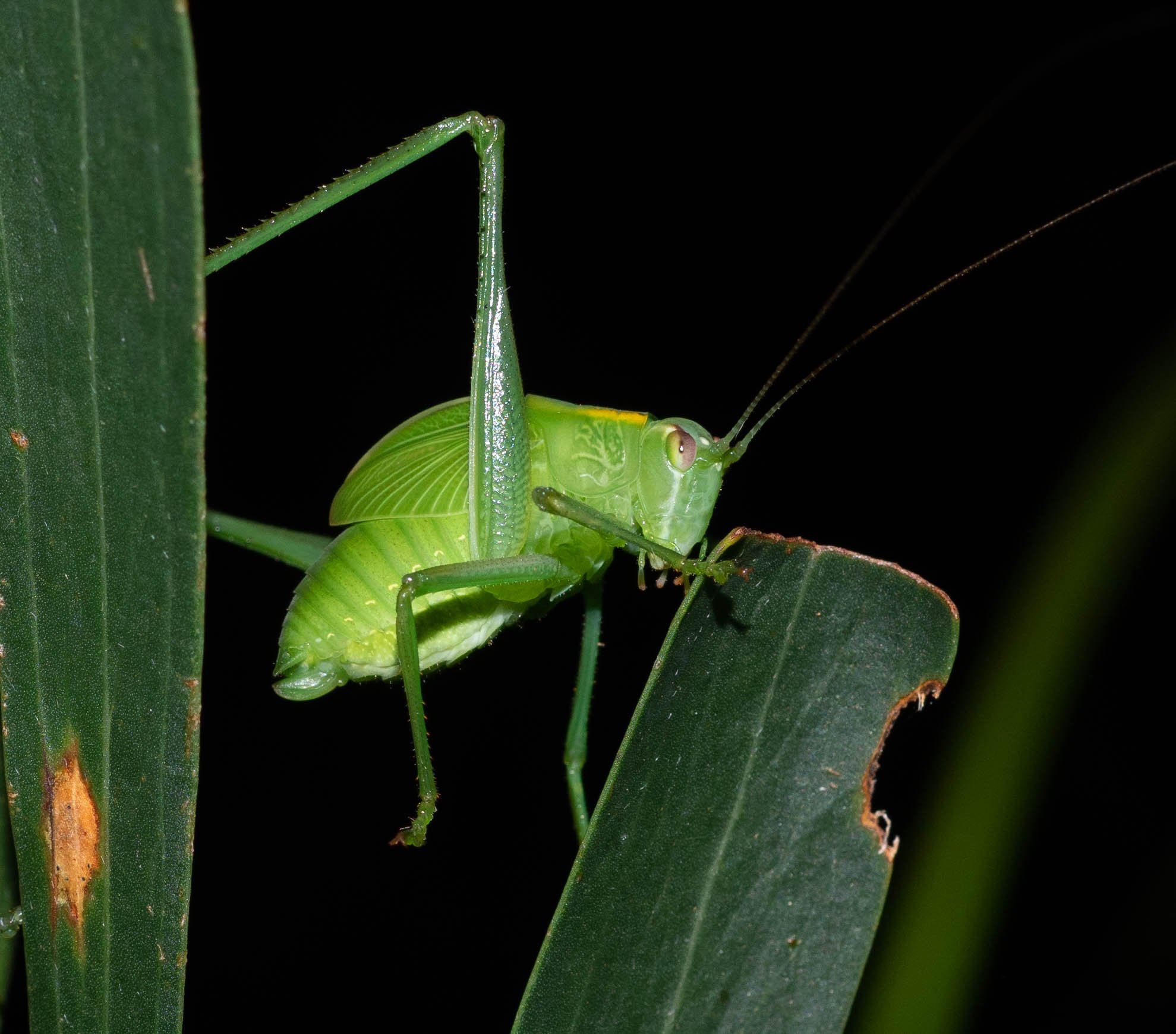
katydid nymph
Caedicia simplex
Perhaps our most common katydid.
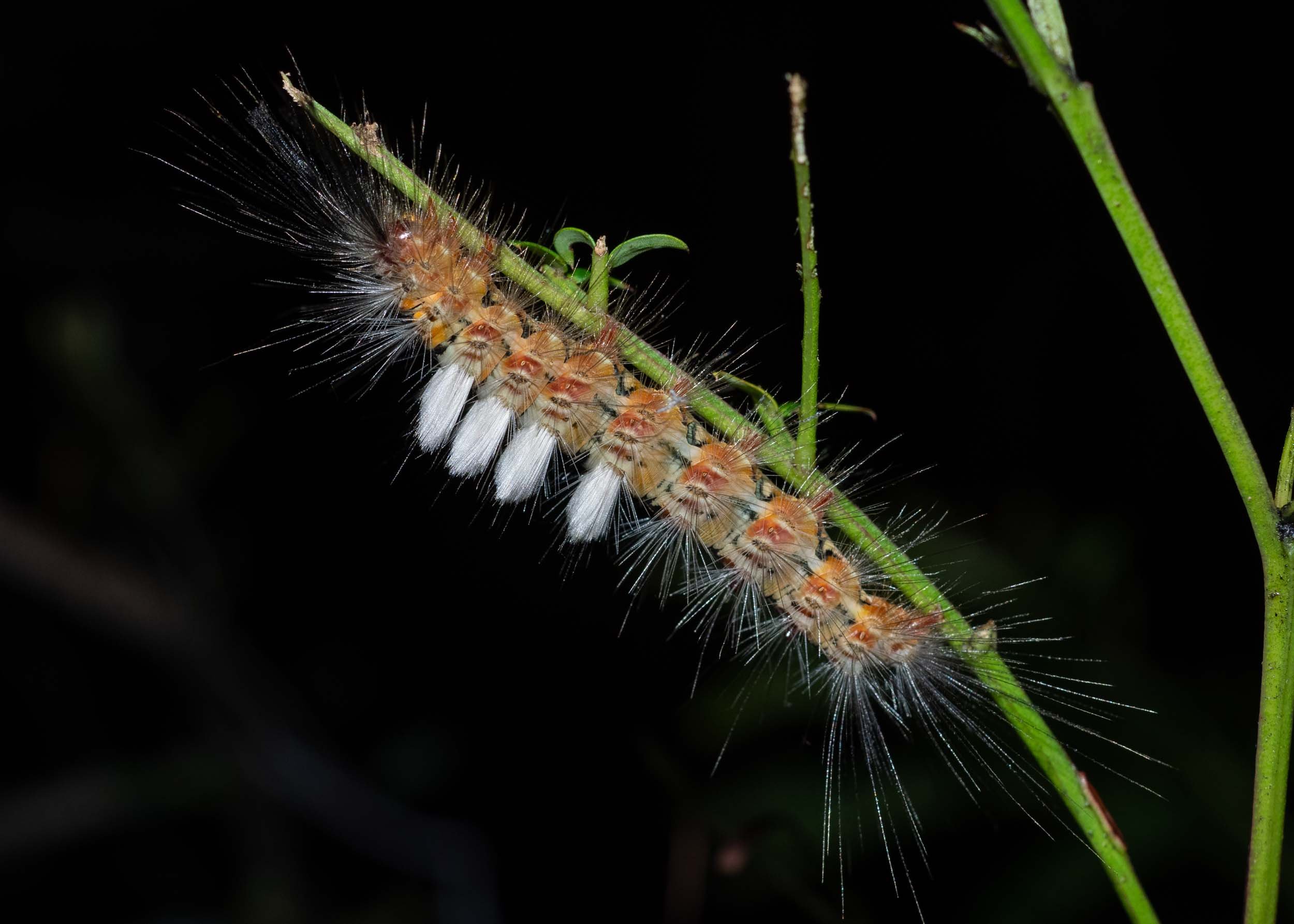
Painted Apple Moth
Orgyia anartoides
Feeding on the wattle Acacia terminalis. Many of the thousands of these wattle bushes which sprang up after the fire are now showing the ill effects of attention from herbivores like this.

Ringed Xenica
Geitoneura acantha
Not a common species here, perhaps due to our elevation. They are generally found in foothills of mountain ranges.
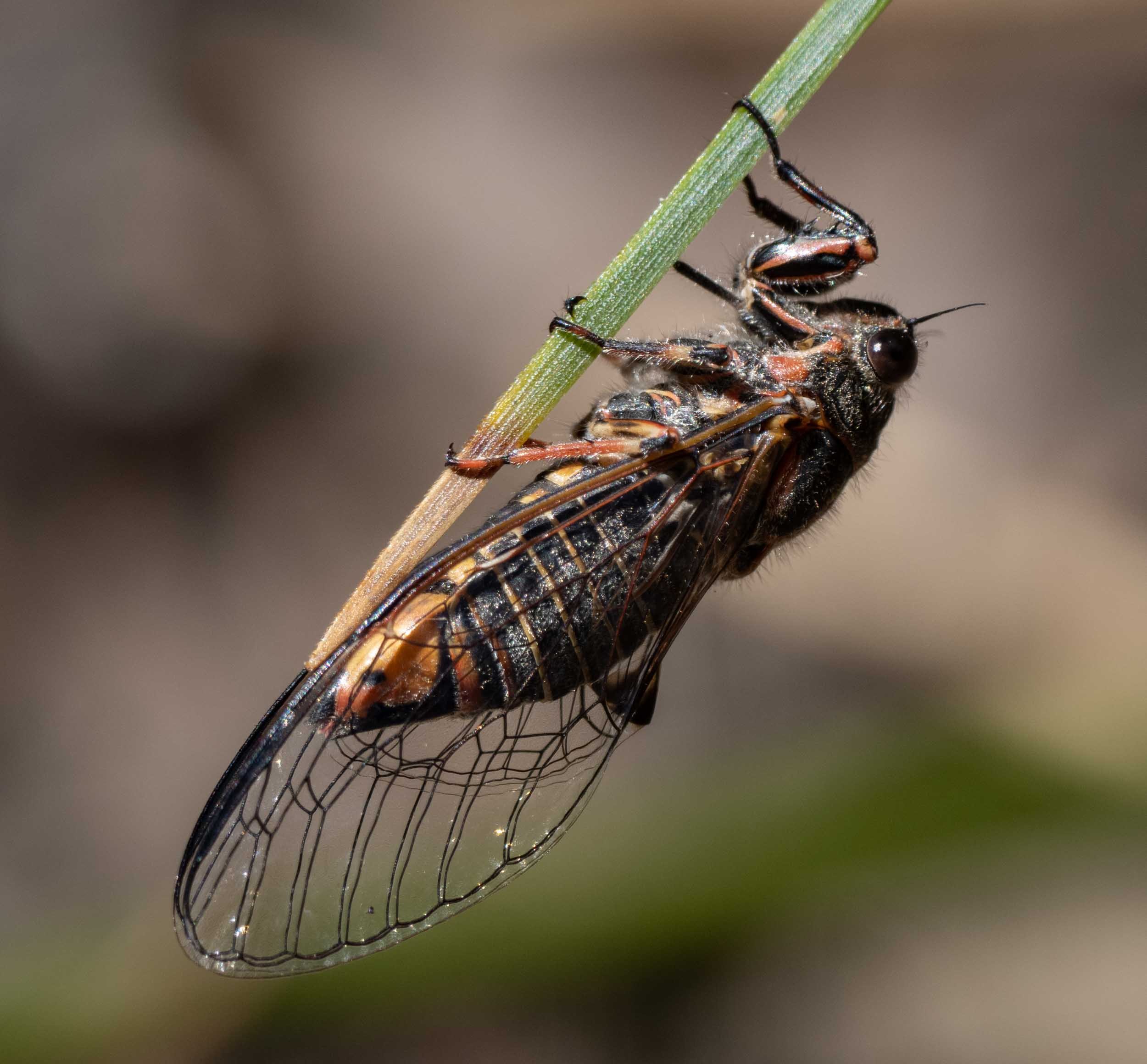
Black Squeaker
Atrapsalta encaustica

Raspy Cricket
Apotrechus sp.
This fellow had made a home in the cap of our wood-fired oven flue. Not the safest place to hang out!
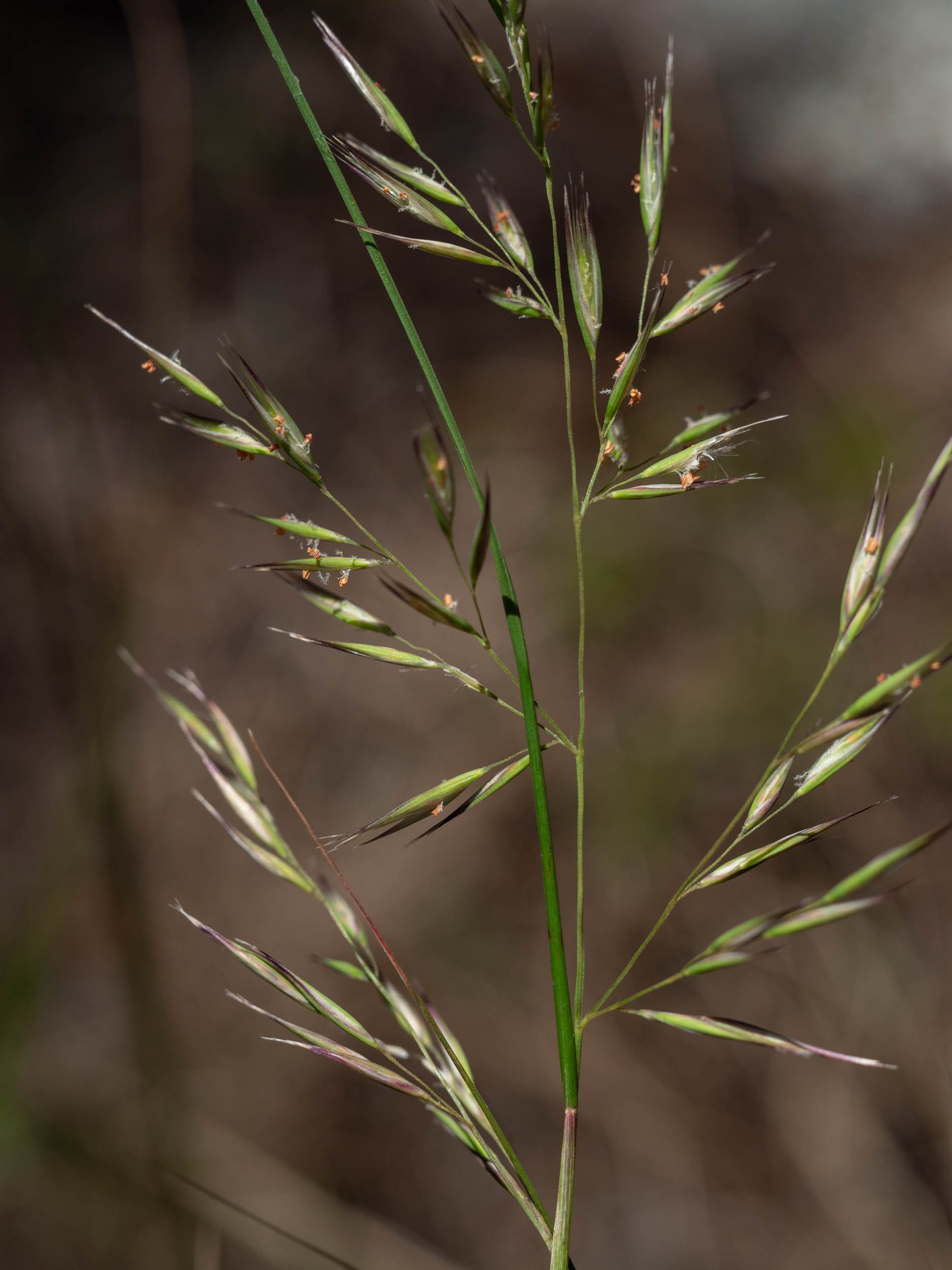
Long-leaved Wallaby Grass
Rytidosperma longifolium
This grass has grown and flowered profusely this summer, particularly on the track leading to the river. As the inflorescence matures, it forms a fuzzy head.
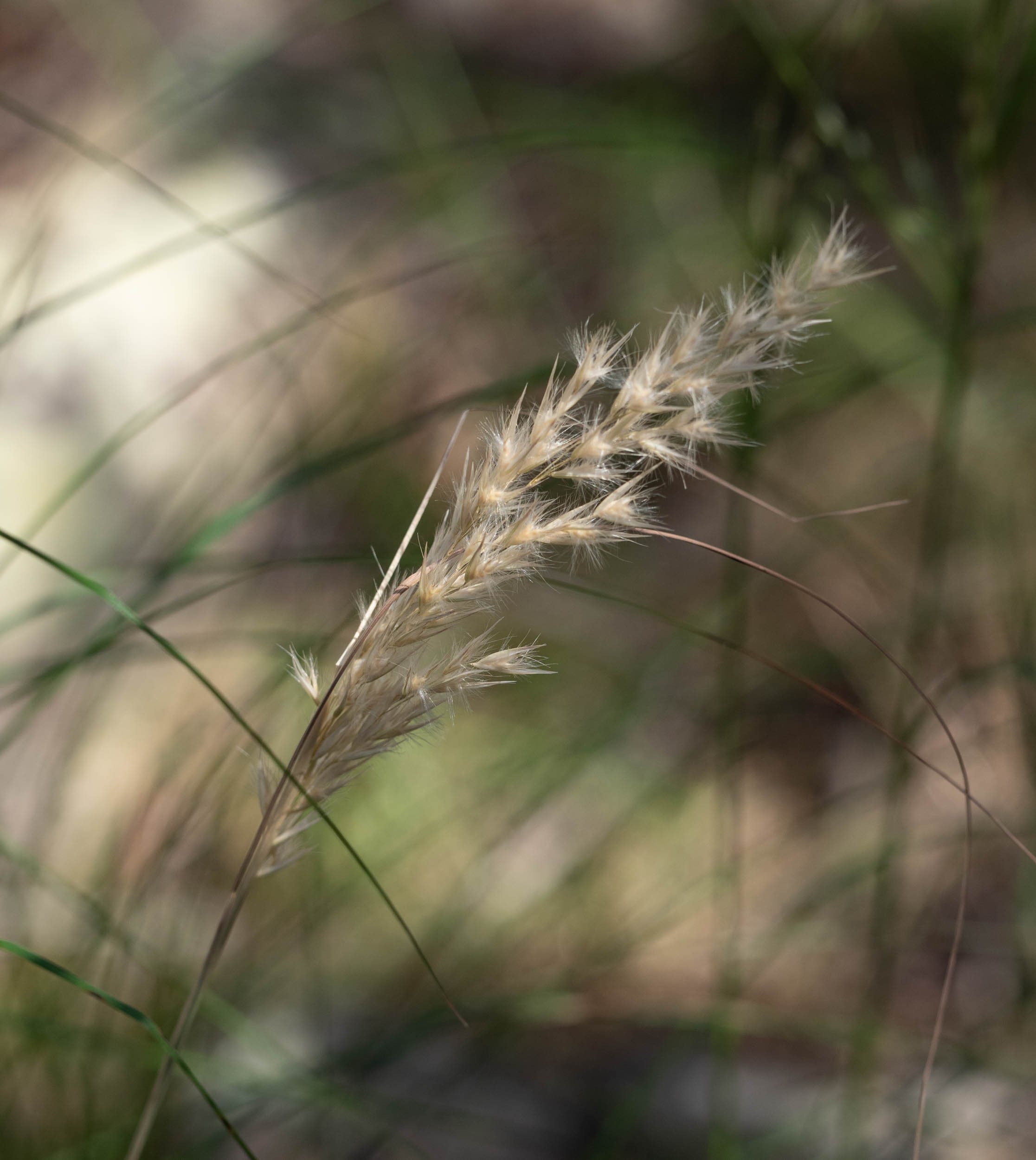
Long-leaved Wallaby Grass
Rytidosperma longifolium
The fuzzy mature inflorescence of this grass.
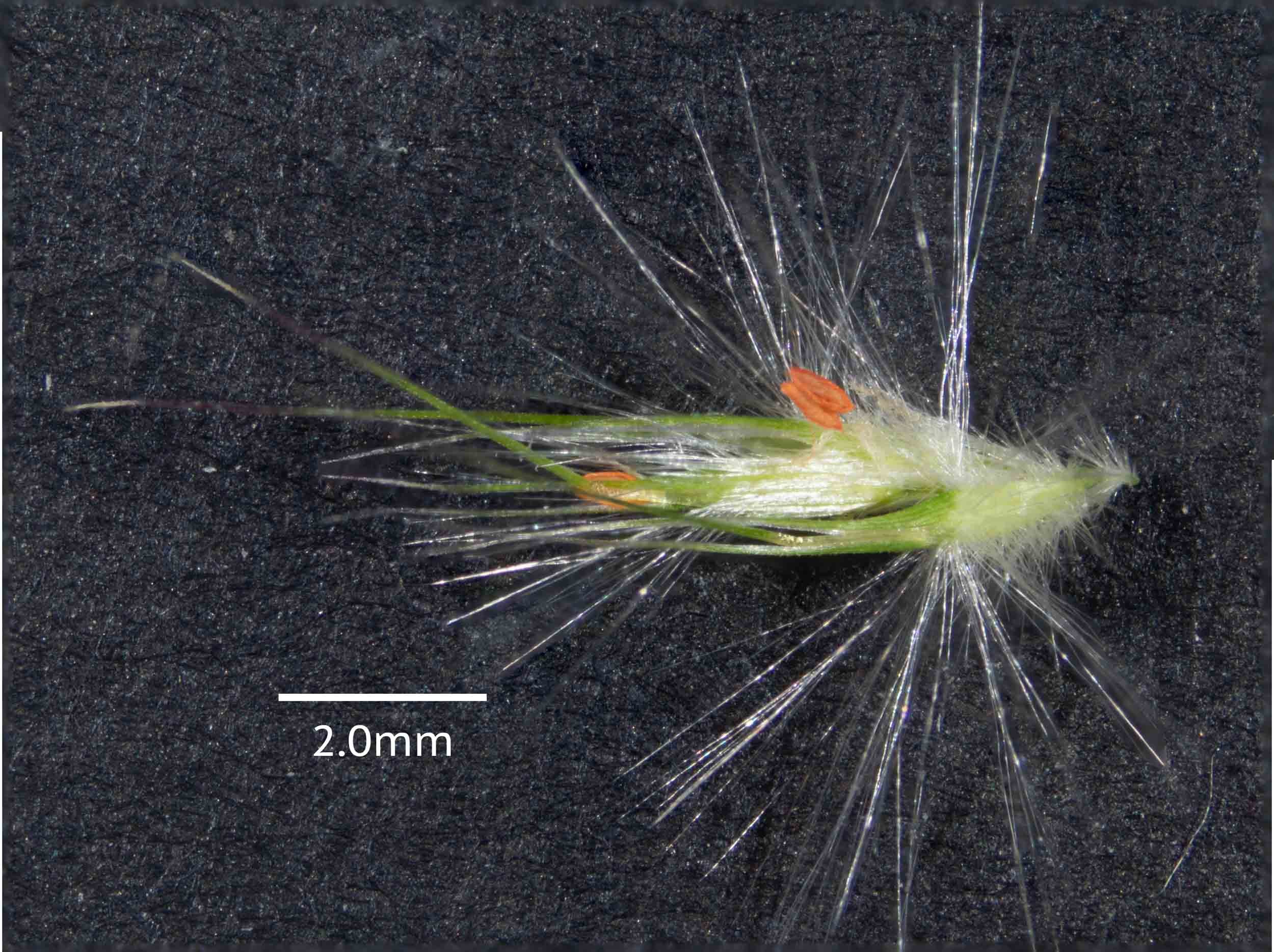
Long-leaved Wallaby Grass
Rytidosperma longifolium
A single spikelet of this grass, showing the long, expanded hairs on the lemma of each floret which give the inflorescence its fuzzy appearance.
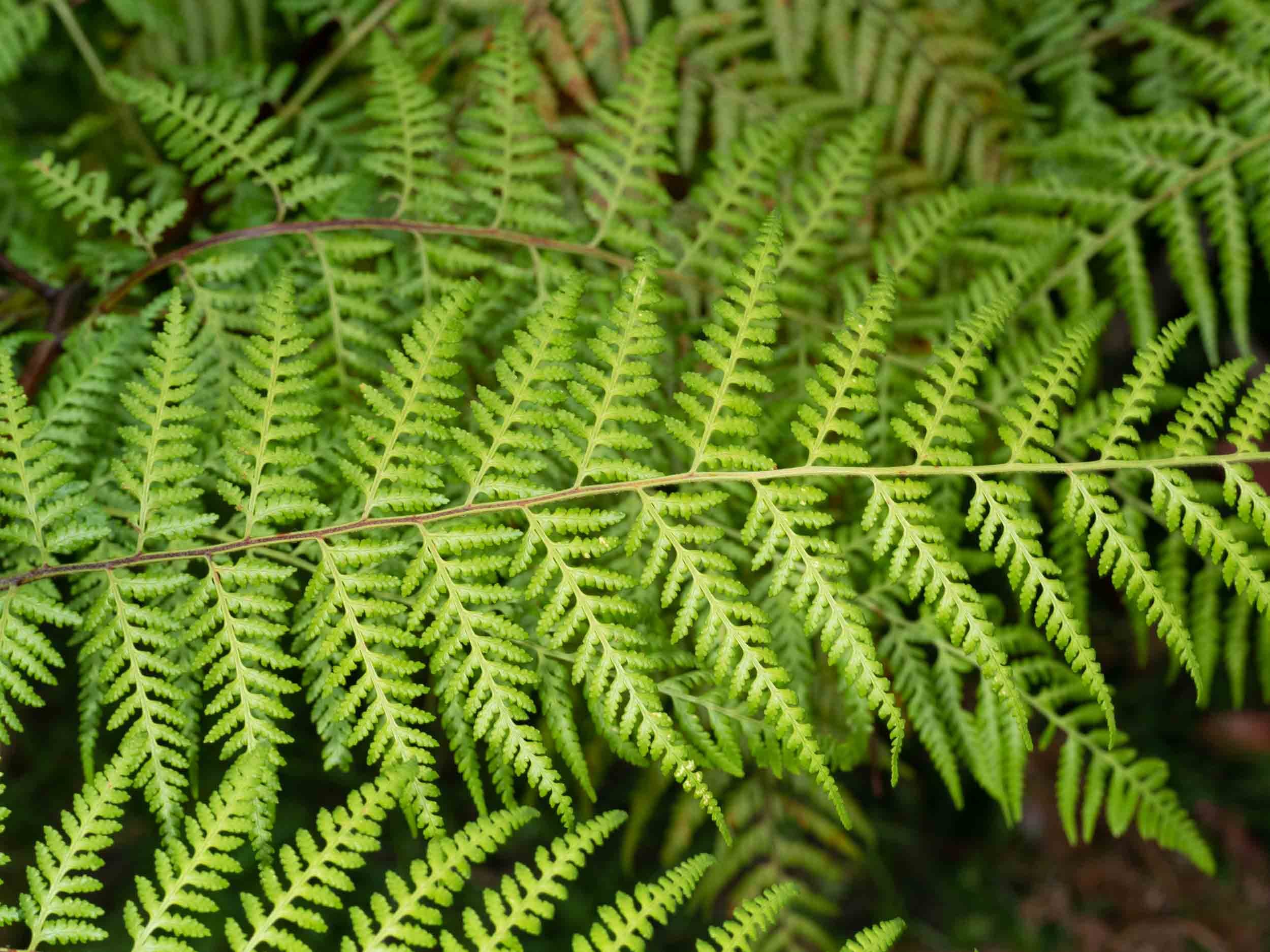
Rainbow Fern
Calochlaena dubia
Not bracken, but rather a close relative of tree ferns.
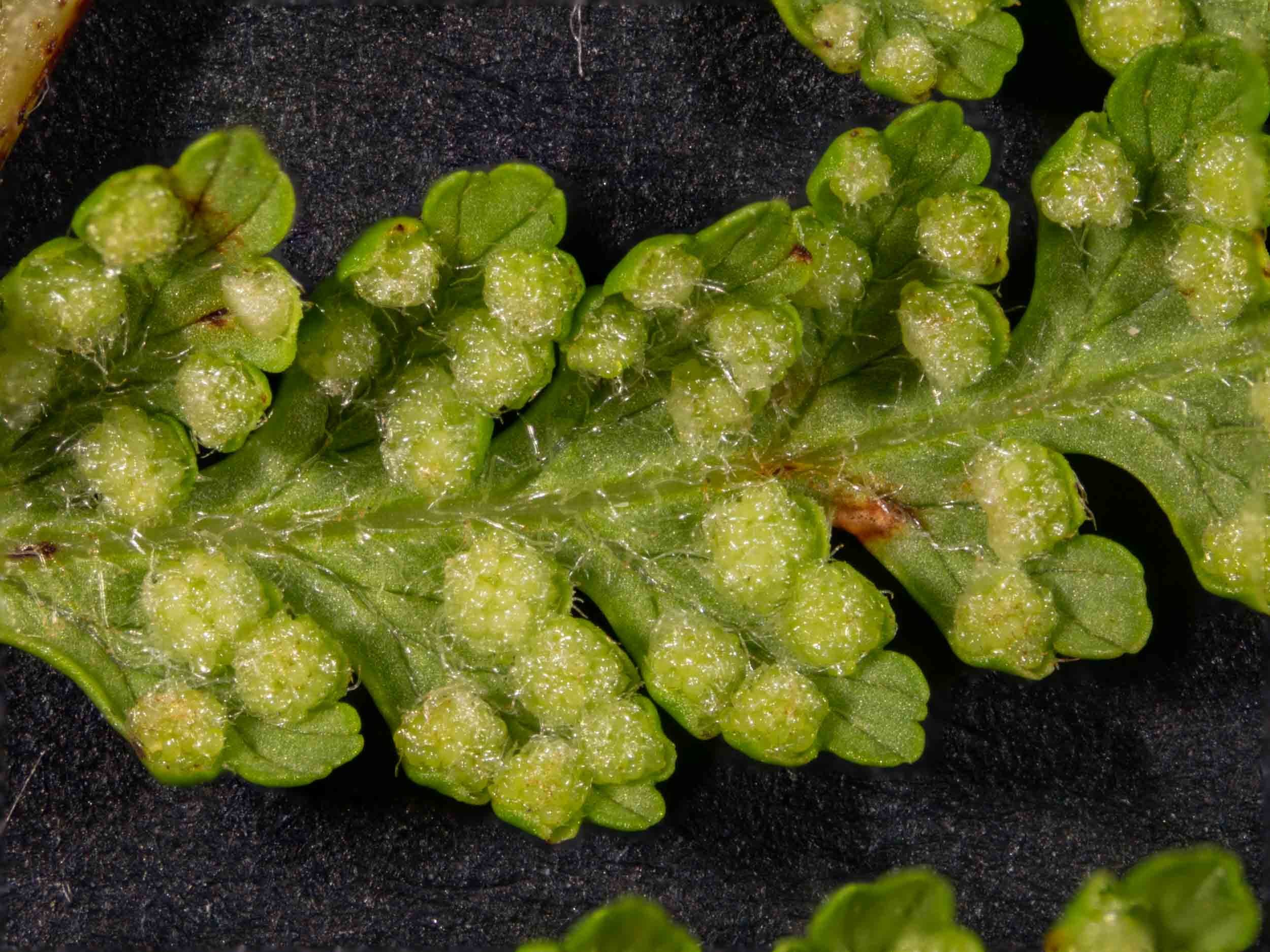
Rainbow Fern
Calochlaena dubia
The small, light green balls under the fronds of this fern are sori, which consist of clusters of sporangia – the sites of spore production.

Narrow-leaf Geebung
Persoonia linearis
A favourite of bees, especially pollen-gathering Leioproctus … species that tend to dominate the bee fauna during late summer.
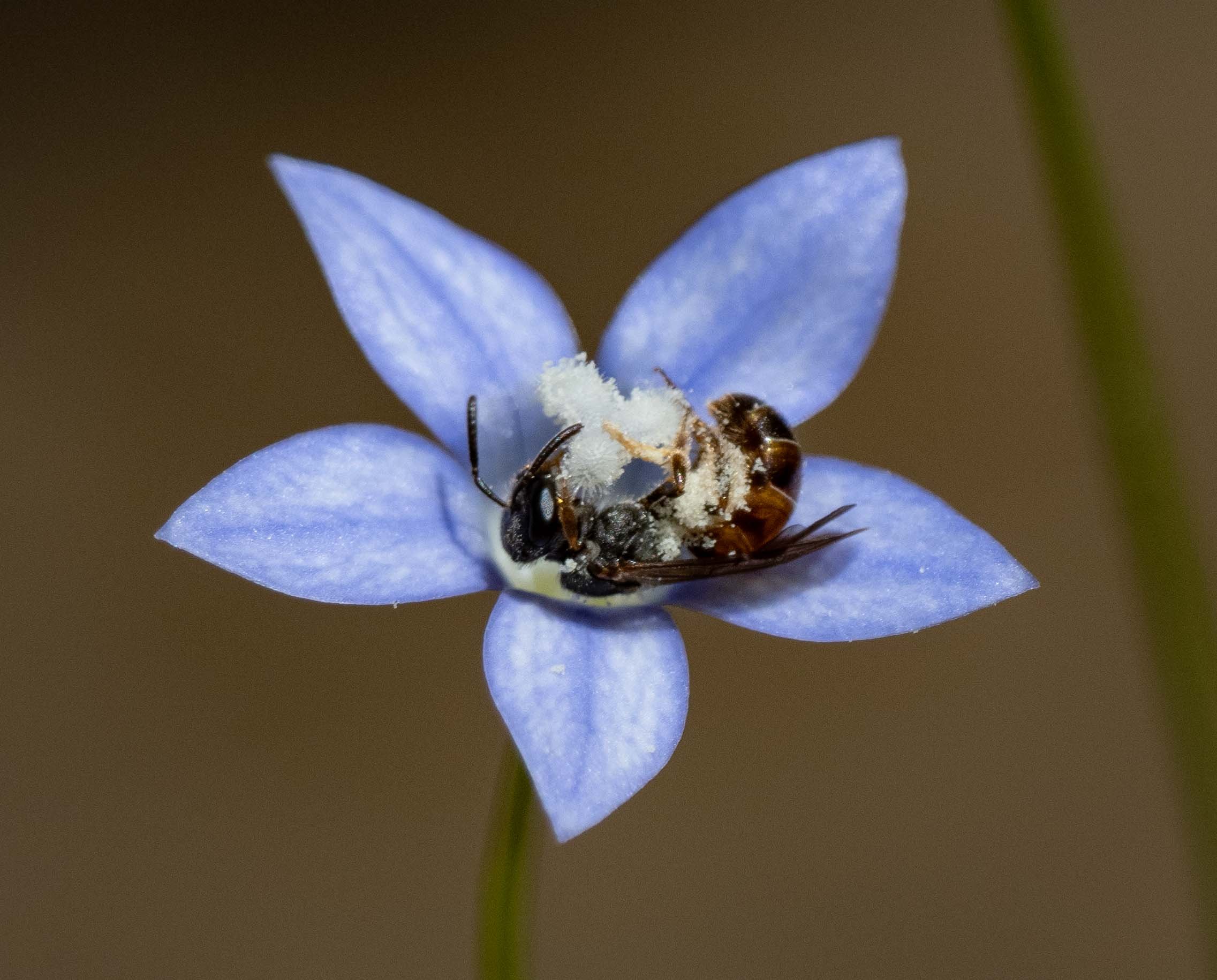
Blue bell
Wahlengbergia
Another flower most common in spring, with a few late bloomers persisting through summer.
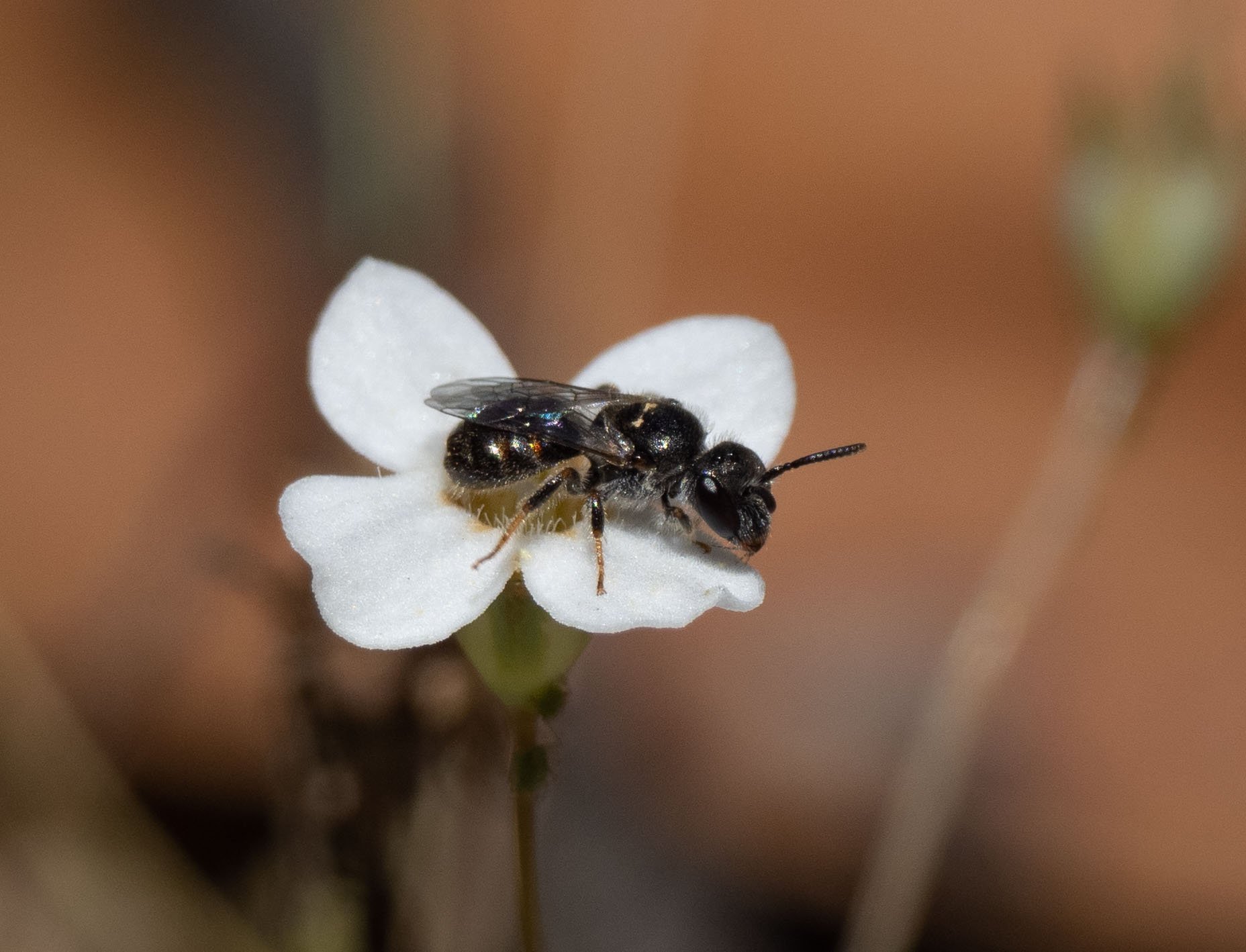
Mitrasacme
Mitrasacme polymorpha
Tiny white flowers are most numerous in spring, but some bloom throughout the year. They attract bees, butterflies and bee flies … so they’re apparently a useful nectar source, despite their small size.
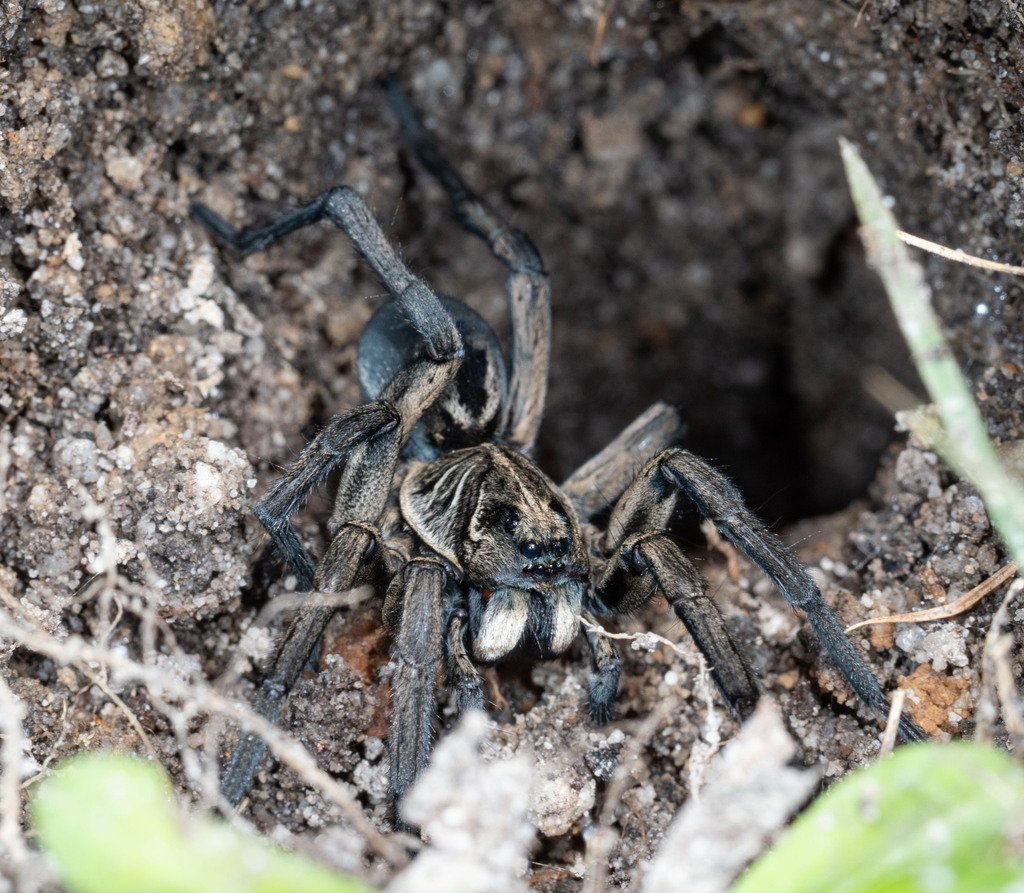
23rd Oct: The female next to a hole made by a bandicoot, which is about 7cm deep.

She inspects the hole as a potential burrow
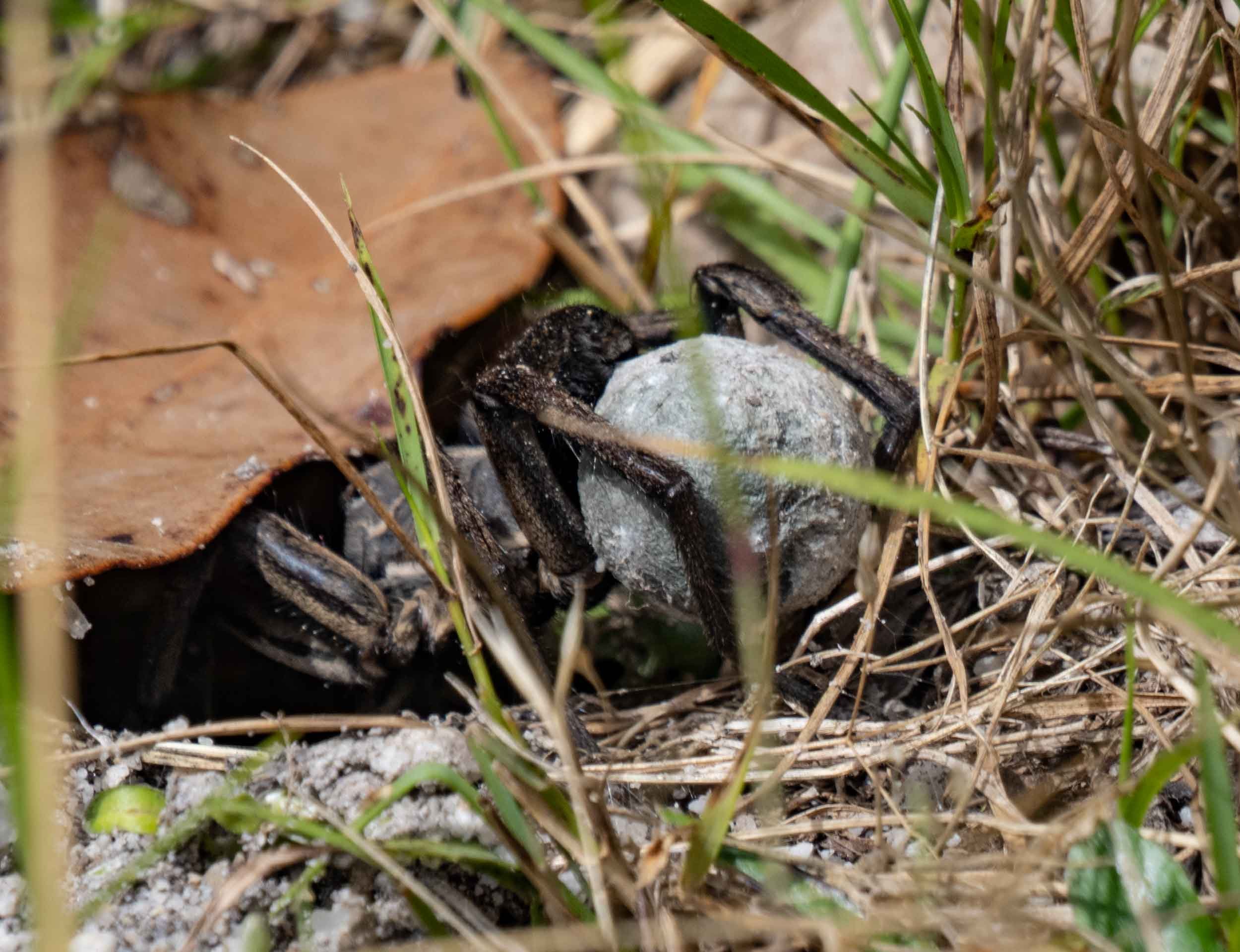
8th Jan: The burrow has clearly suited her admirably as she has produced a large egg sac, which she holds under her abdomen. These can contain between 180 and 1094 eggs (Humphreys, 1978). I never saw her away from the burrow with the egg sac – Humphreys (1976) notes that these spiders rarely eat when carrying the egg sac. He reports that they carry the sac for an average of 3.6 weeks.
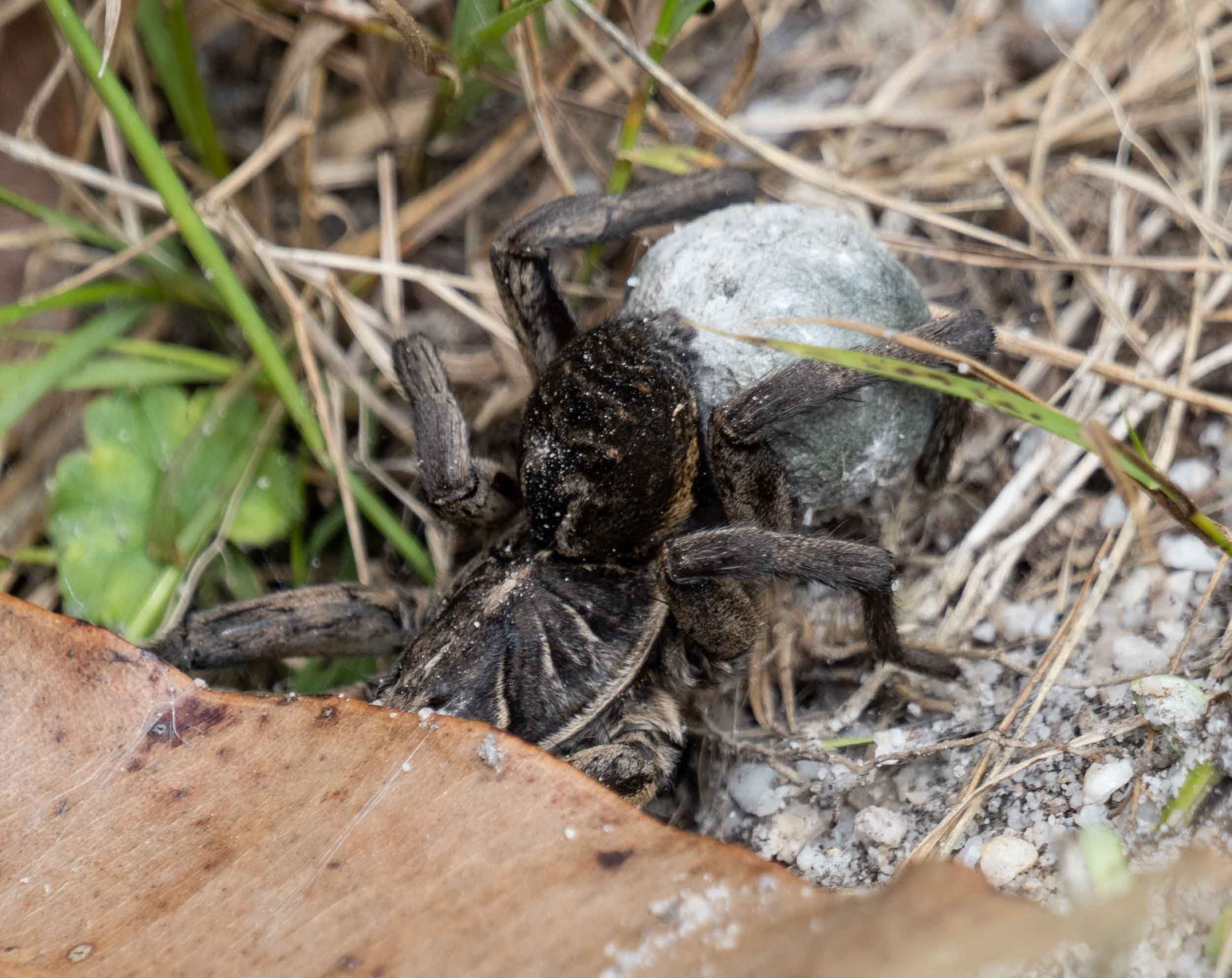
8th Jan: She brings her egg sac into the sun on cool days to raise its temperature. Behavioural thermoregulation has been well documented for Tasmanicosa godeffroyi (Humphreys, 1974, 1976). This spider can keep its body temperature well above ambient by basking in the sun during the day and retreating to its burrow at night.
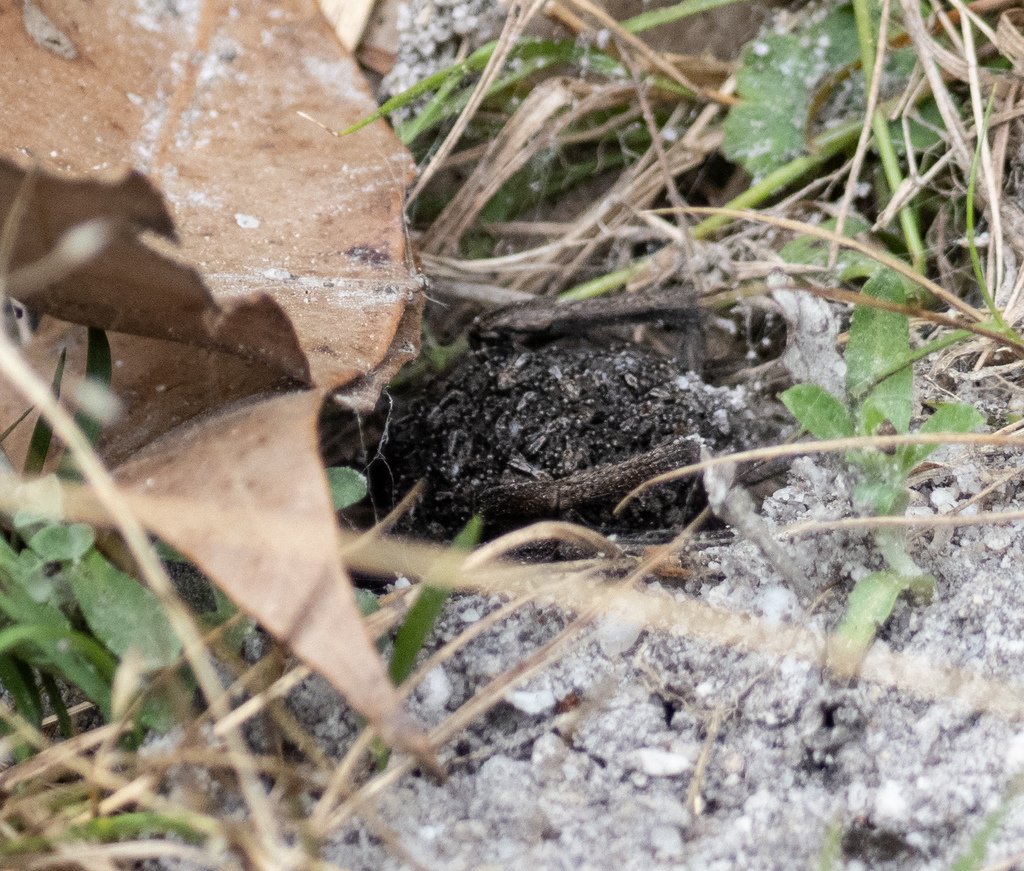
15th Jan: A week later, the spiderlings have left the egg sac and have positioned themselves on their mother’s back.

15th Jan: A closer view of the spiderlings. The mother appeared to stay in or close to her burrow on most occasions. Humphreys (1976) reports that spiders carrying spiderlings ate little.
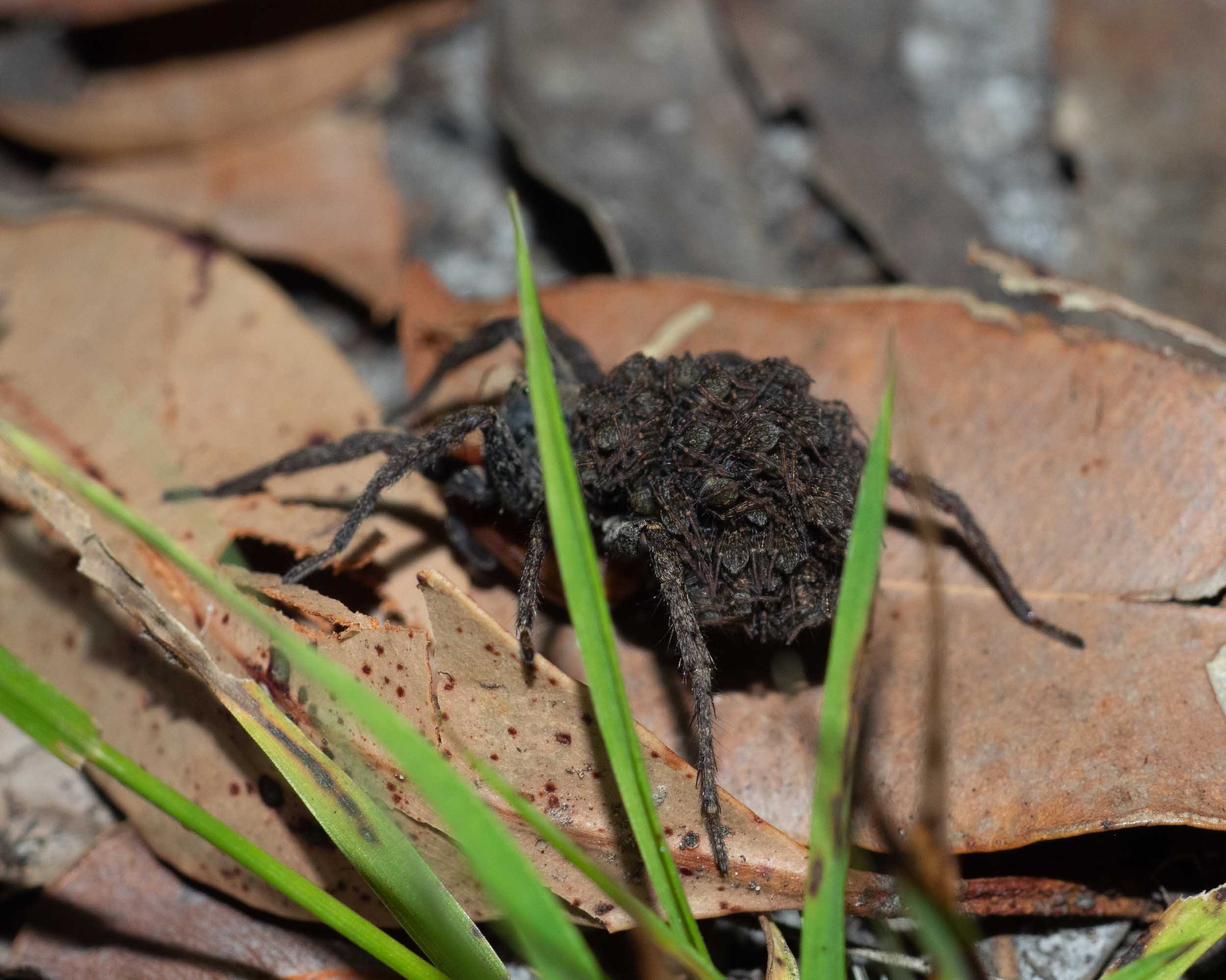
Some other wolf spiders, like this smaller species here move around freely with their backpack of infants

19th Jan: 4 days later, most of the spiderlings have left their mother’s back. Some are still hanging on - see if you can spot the baby close to the top of her abdomen. Humphreys (1978) reports that mothers carry their babies on their backs for an average of 8.6 days.
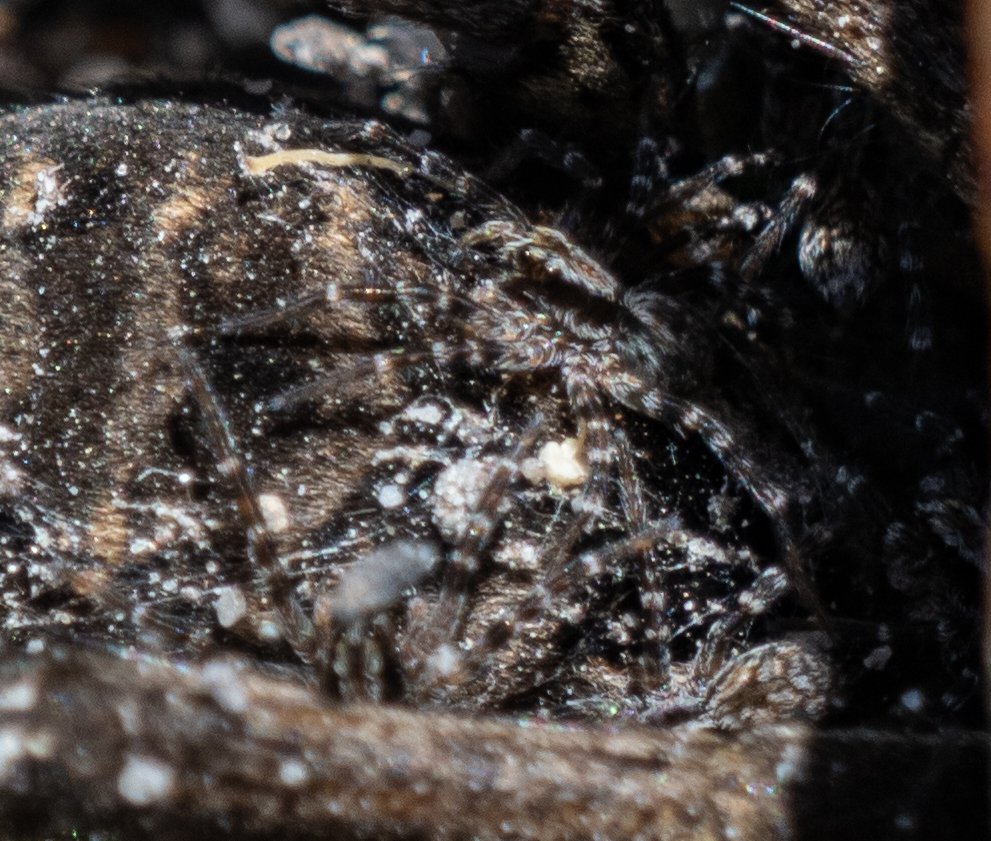
A close-up of the mother’s abdomen reveals the spiderling
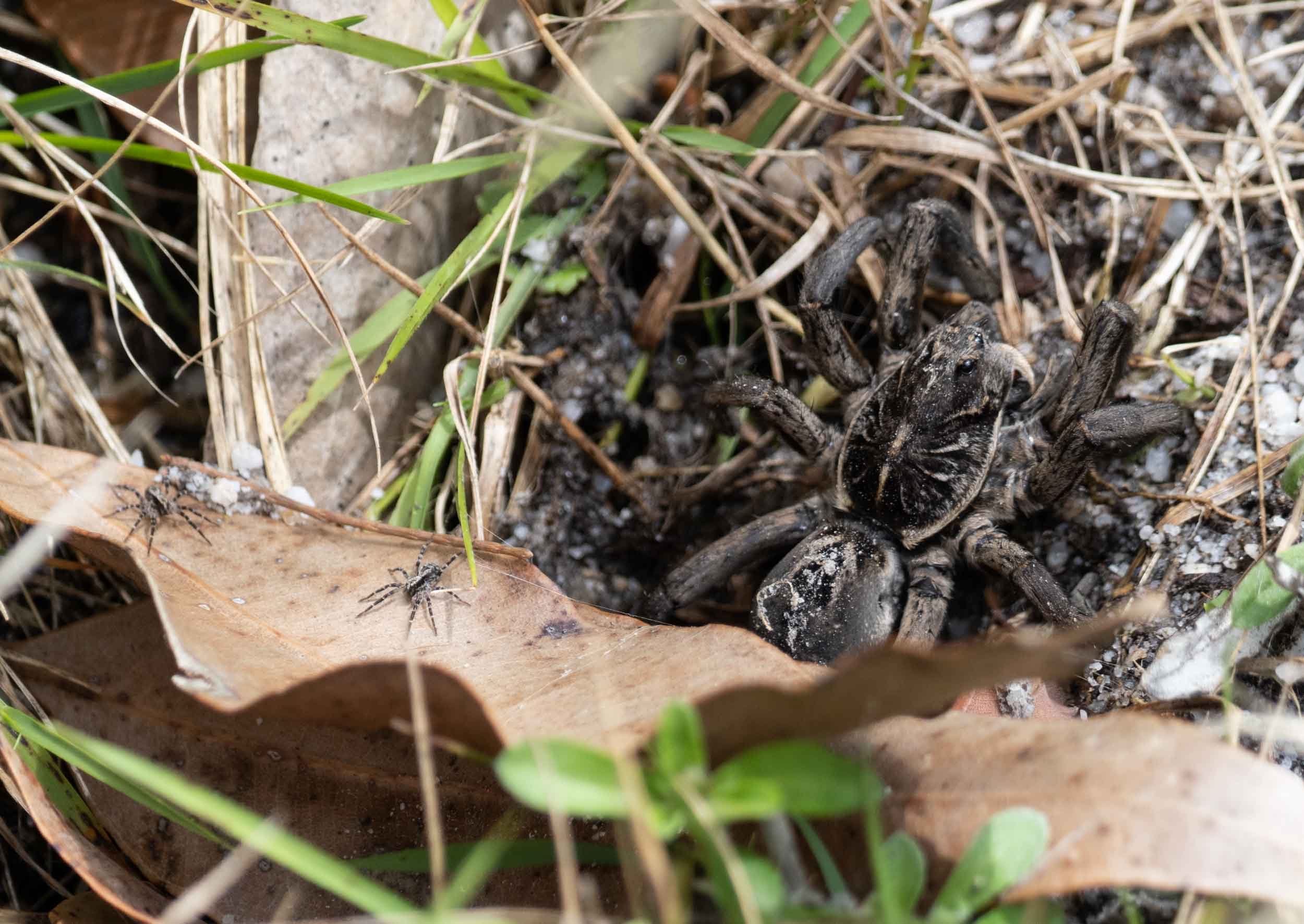
22nd Jan: The spiderlings can be seen exploring the territory close to the burrow. Spot the pair on the leaf. Given the large number of spiderlings seen earlier on the mother’s back, most of her progeny have probably ventured further afield or are hiding nearby.
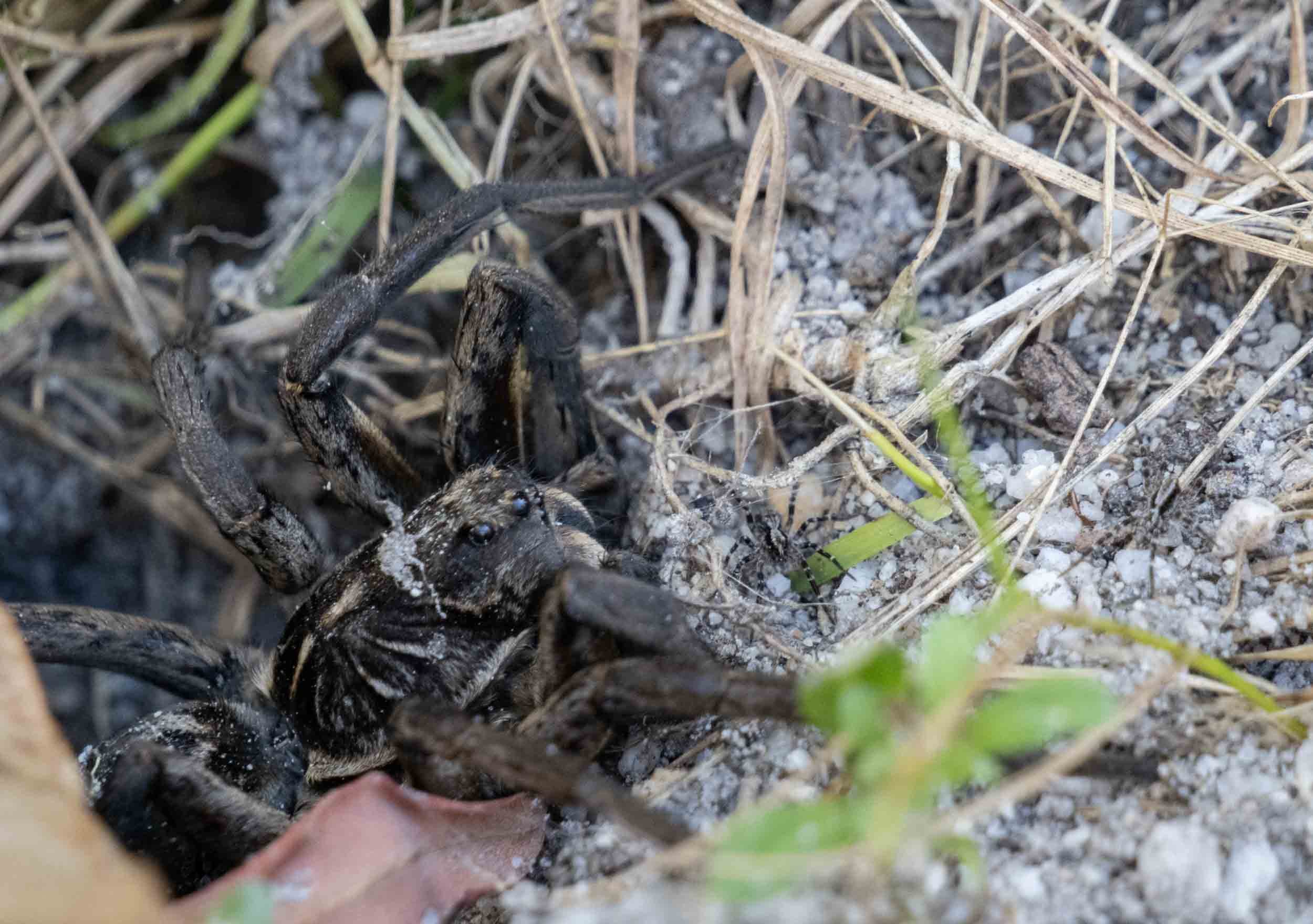
22nd Jan: One spiderling lies within close range of its mother, just in front of her fangs while another is a little further away.
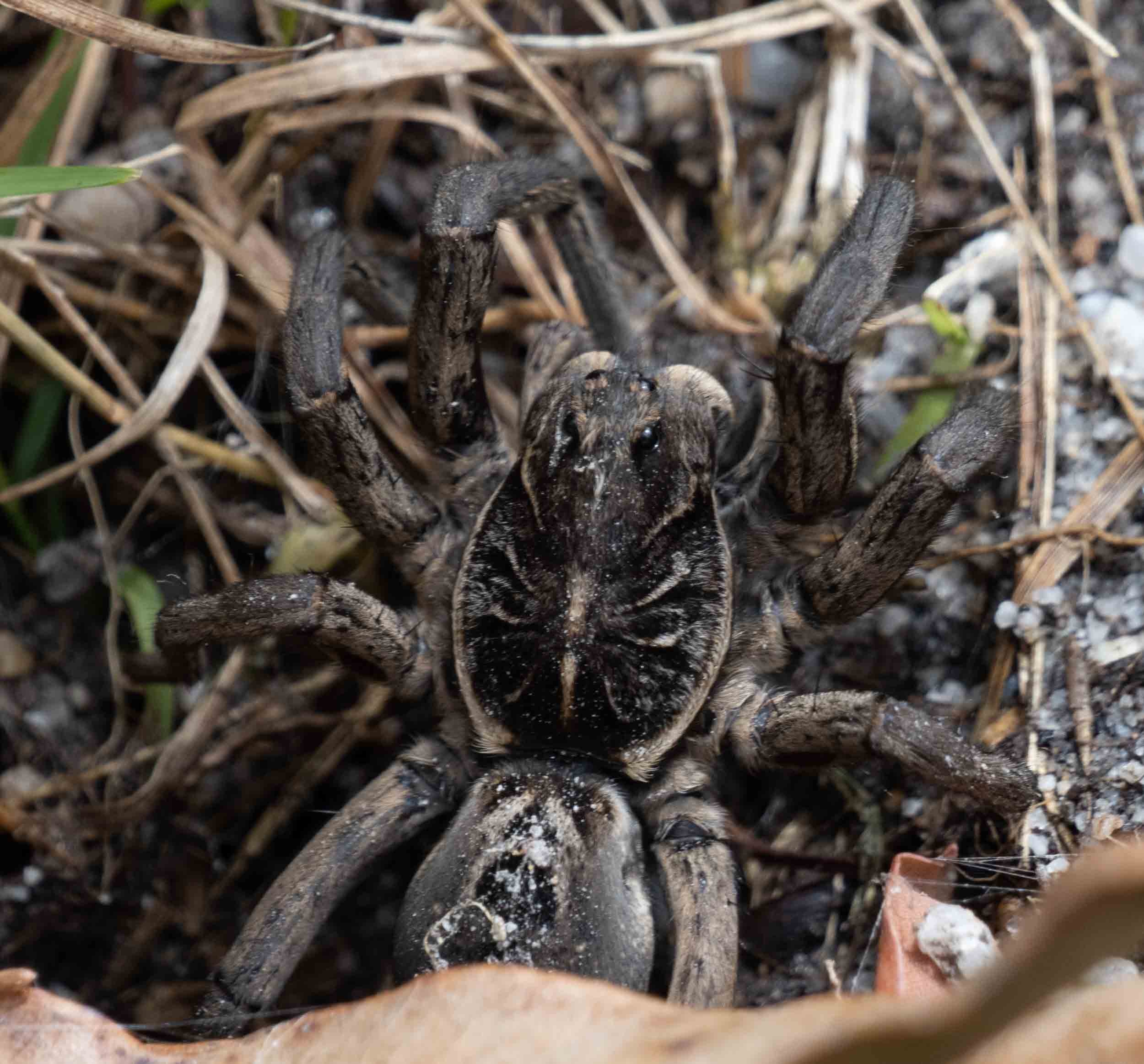
22nd Jan: Now that she has lost her load, the mother leaves the burrow in search of food.
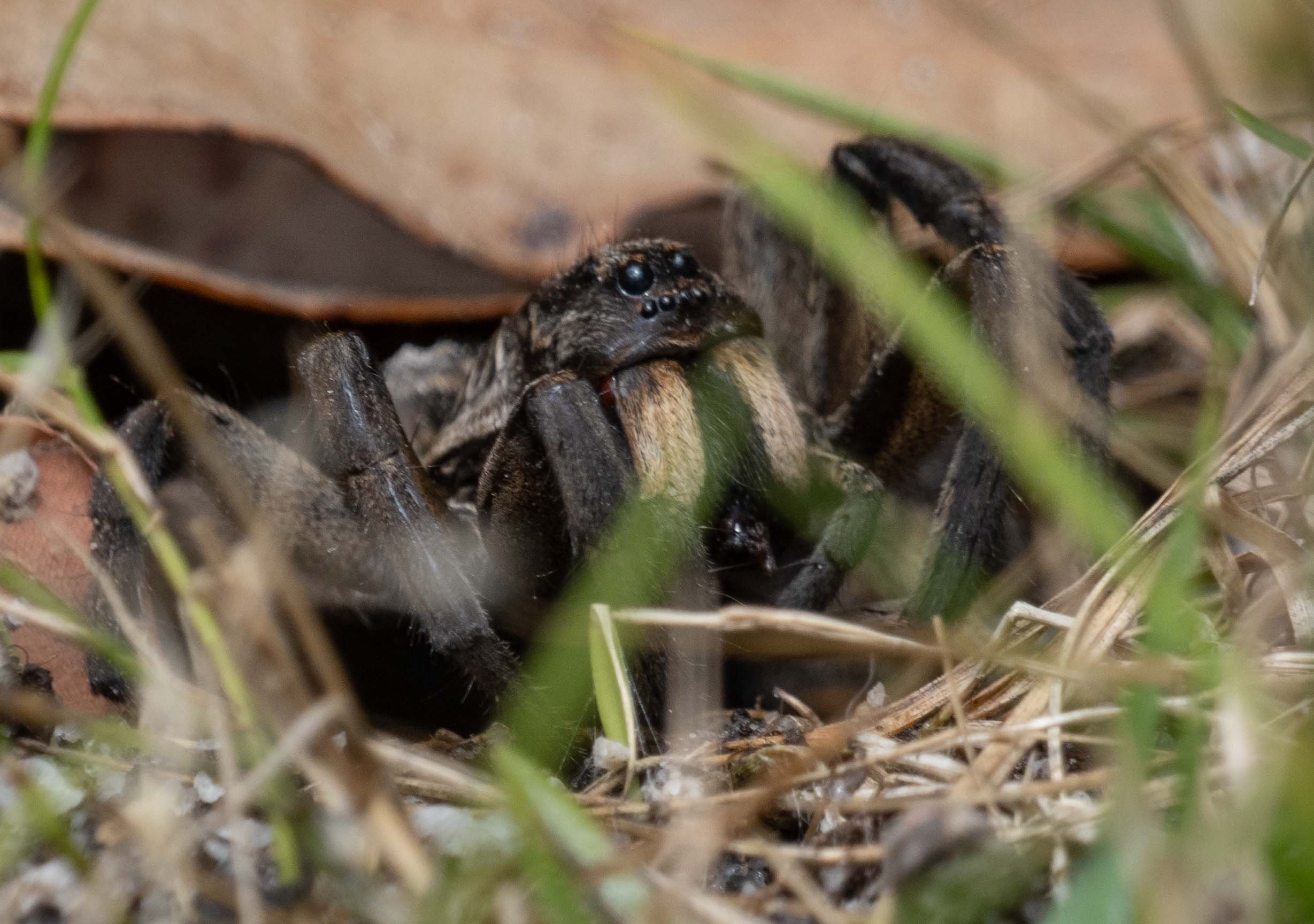
22nd Jan: Viewed from the front, prey can be seen in her fangs. Humphreys (1976) reports that on the average, females catch one prey item a week, but this is a relatively large one, averaging 98mg. As a reference, the average weight of adult females is 1500mg.
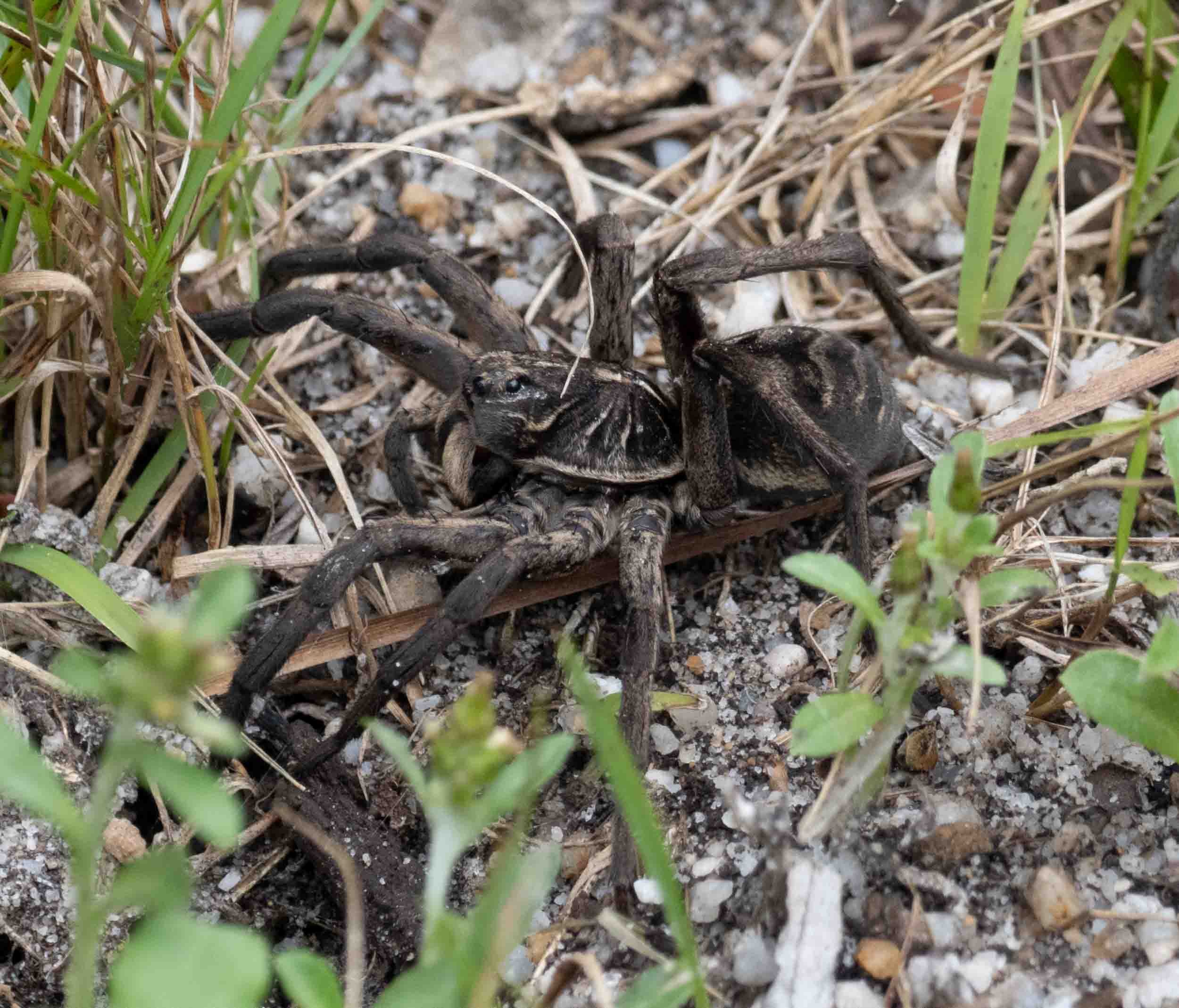
31st Jan: The mother is often seen outside her burrow now. Not long after this, I no longer saw her and her burrow appeared empty. Humphreys (1976) states that females produce one or two egg sacs and die. He notes that all females are probably dead by August following breeding (Humpreys, 1978).

Red-bellied Black Snake
Pseudechis porphyriacus













































































































































